 | –≠–ª–µ–∫—Ç—Ä–æ–Ω–Ω—ã–π –∫–æ–º–ø–æ–Ω–µ–Ω—Ç: QL8050 | –°–∫–∞—á–∞—Ç—å:  PDF PDF  ZIP ZIP |
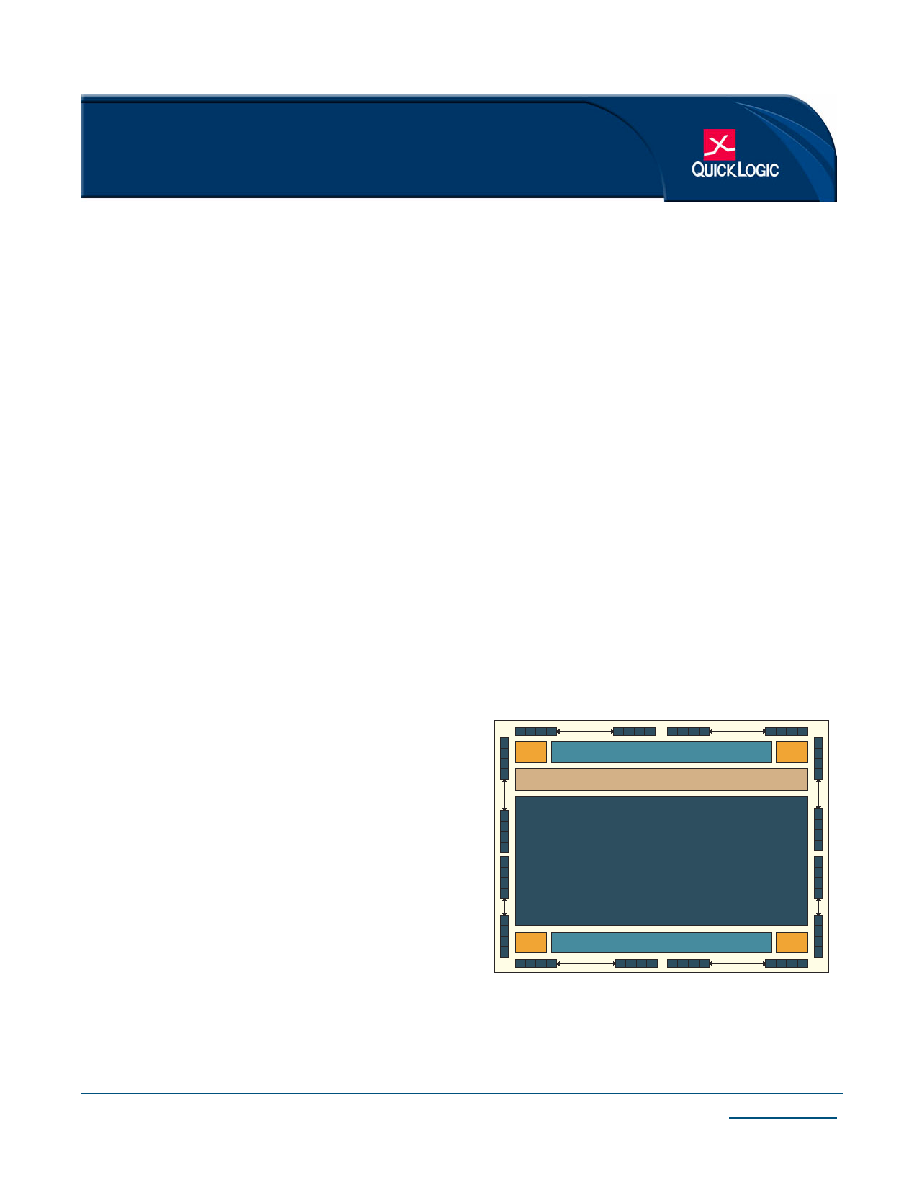
4XLFN/RJLF &RUSRUDWLRQ
ZZZTXLFNORJLFFRP
Preliminary
'HYLFH +LJKOLJKWV
)OH[LEOH 3URJUDPPDEOH /RJLF
0.18
µ
, six layer metal CMOS process
1.8 V Vcc, 1.8/2.5/3.3 V drive capable I/O
Up to 4,008 dedicated flip-flops
Up to 55.3 K embedded RAM Bits
Up to 313 I/O
Up to 370 K system gates
IEEE 1149.1 Boundary Scan Testing
Compliant
Low Power Capability
(PEHGGHG 'XDO 3RUW 65$0
Up to twenty-four 2,304 bit Dual Port High
Performance SRAM Blocks
Up to 55,296 embedded RAM bits
RAM/ROM/FIFO Wizard for automatic
configuration
Configurable and cascadable
3URJUDPPDEOH ,2
High performance I/O cell with Tco< 3 ns
Programmable Slew Rate Control
Programmable I/O Standards:
LVTTL, LVCMOS, LVCMOS18, PCI,
GTL+, SSTL2, and SSTL3
Independent I/O Banks capable of
supporting multiple standards in one device
I/O Register Configurations: Input,
Output, Output Enable (OE)
$GYDQFHG &ORFN 1HWZRUN
Multiple dedicated Low Skew Clock
Networks
High drive input-only networks
Quadrant-based segmentable clock networks
User Programmable Phase Locked Loops
(PEHGGHG &RPSXWDWLRQDO 8QLWV
(&8V�
Hardwired DSP building blocks with integrated
Multiply, Add, and Accumulate Functions.
6HFXULW\ )HDWXUHV
The QuickLogic products come with secure
ViaLink
technology that protects intellectual
property from design theft and reverse
engineering. No external configuration memory
needed; Instant-on at Power-up.
)LJXUH (FOLSVH,,
%ORFN 'LDJUDP
Embedded RAM Blocks
PLL
PLL
Fabric
Embeded Computational Units
Embedded RAM Blocks
PLL
PLL
/RZ 3RZHU )3*$ &RPELQLQJ 3HUIRUPDQFH 'HQVLW\ DQG (PEHGGHG 5$0
(FOLSVH,, )DPLO\ 'DWD 6KHHW
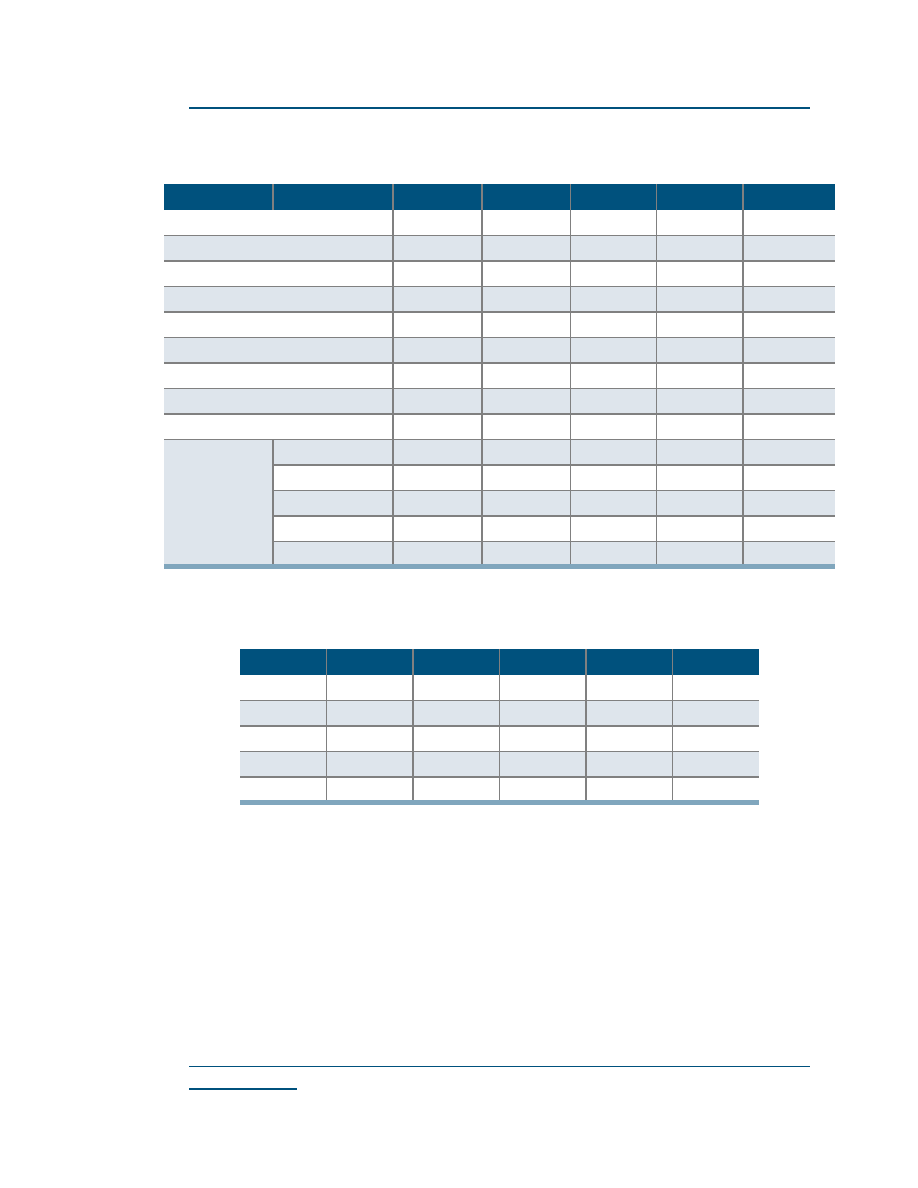
ZZZTXLFNORJLFFRP
4XLFN/RJLF &RUSRUDWLRQ
(FOLSVH,, )DPLO\ 'DWD 6KHHW 5HY %
Preliminary
4XLFN:RUNV 'HVLJQ 6RIWZDUH
The QuickWorks
package provides the most complete ESP and FPGA software solution from
design entry to logic synthesis, to place and route, and simulation. The package provides a
solution for designers who use third party tools from Cadence, Mentor, OrCAD, Synopsys,
Viewlogic, and other third-party tools for design entry, synthesis, or simulation.
3URFHVV 'DWD
Eclipse-II is fabricated on a 0.18
µ
, six layer metal CMOS process. The core voltage is
1.8 V Vcc supply and the I/Os are up to 3.3 V tolerant. The Eclipse-II product line is available in
commercial, industrial, and military temperature grades.
7DEOH (FOLSVH,, 3URGXFW )DPLO\ 0HPEHUV
4/
4/
4/
4/
4/
Max Gates
47,052
63,840
188,946
248,160
320,640
Logic Array
16 x 8
16 x 16
32 x 20
40 x 24
48 x 32
Logic Cells
128
256
640
960
1,536
Max Flip-Flops
526
884
1,697
2,670
4,002
Max I/O
90
124
139
250
310
RAM Modules
4
4
16
20
24
RAM Bits
9,216
9,216
36,864
46,100
55,300
PLLs
0
0
0
4
4
ECUs
0
0
0
10
12
Packages
VQFP
100
100
100
-
-
CSBGA (0.8 mm)
196
196
196
-
-
PQFP
208
208
208
208
208
FBGA (0.8 mm)
-
-
-
280
280
BGA (1.0 mm)
-
-
-
484
484
7DEOH 0D[ ,2 SHU 'HYLFH3DFNDJH &RPELQDWLRQ
'HYLFH
94)3 &6%*$ 34)3 &6%*$ 3%*$
QL8025
62
90
90
-
-
QL8050
62
100
124
-
-
QL8150
62
100
139
-
-
QL8250
-
-
115
163
250
QL8325
-
-
115
163
310
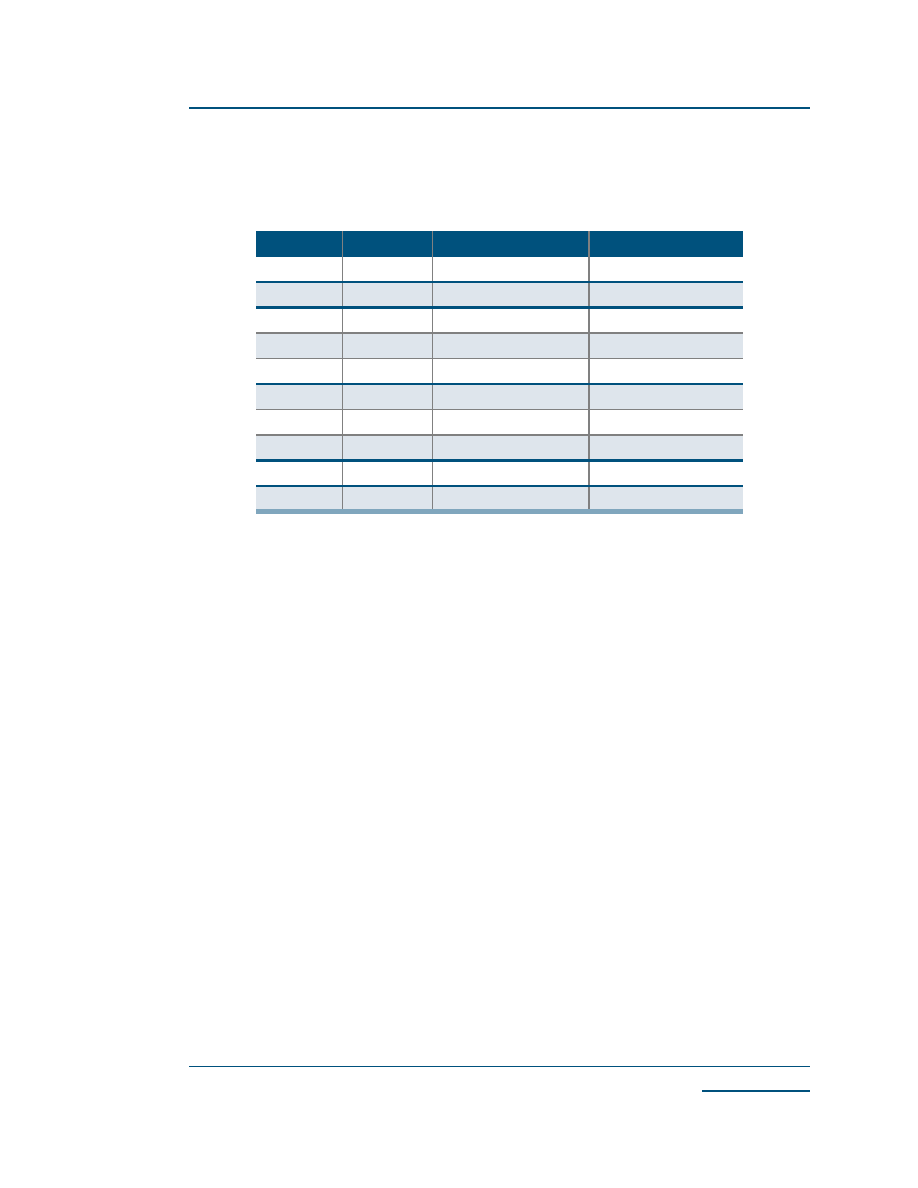
4XLFN/RJLF &RUSRUDWLRQ
ZZZTXLFNORJLFFRP
(FOLSVH,, )DPLO\ 'DWD 6KHHW 5HY %
Preliminary
3URJUDPPDEOH /RJLF $UFKLWHFWXUDO 2YHUYLHZ
The Eclipse-II
logic cell structure is presented in
)LJXUH
. This architectural feature addresses
today's register-intensive designs.
The Eclipse-II logic cell structure presented in
)LJXUH
is a dual register, multiplexor-based logic
cell. It is designed for wide fan-in and multiple, simultaneous output funtions. Both registers share
CLK, SET, and RESET inputs. The second register has a two-to-one multiplexer controlling its
input. The register can be loaded from the NZ output or directly from a dedicated input.
NOTE:
7KH LQSXW 33 LV QRW DQ LQSXW LQ WKH FODVVLFDO VHQVH ,W LV D VWDWLF LQSXW WR WKH ORJLF FHOO
DQG VHOHFWV ZKLFK SDWK 1= RU 36� LV XVHG DV DQ LQSXW WR WKH 4= UHJLVWHU $OO RWKHU
LQSXWV DUH G\QDPLF DQG FDQ EH FRQQHFWHG WR PXOWLSOH URXWLQJ FKDQQHOV
The complete logic cell consists of two 6-input AND gates, four two-input AND gates, seven two-
to-one multiplexers, and two D flip-flops with asynchronous SET and RESET controls. The cell
has a fan-in of 30 (including register control lines), fits a wide range of functions with up to 17
simultaneous inputs, and has six outputs (four combinatorial and two registered). The high logic
capacity and fan-in of the logic cell accommodates many user functions with a single level of logic
delay while other architectures require two or more levels of delay.
7DEOH 3HUIRUPDQFH 6WDQGDUGV
)XQFWLRQ
'HVFULSWLRQ 6ORZHVW 6SHHG *UDGH
)DVWHVW 6SHHG *UDGH
Multiplexer
16:1
5 ns
2.8 ns
Parity Tree
24
6 ns
3.4 ns
Counter
36
6 ns
3.4 ns
16 bit
250 MHz
450 MHz
32 bit
250 MHz
450 MHz
FIFO
128 x 32
155 MHz
280 MHz
256 x 16
155 MHz
280 MHz
128 x 64
155 MHz
280 MHz
Clock-to-Out
4.5 ns
2.5 ns
System clock
200 MHz
400 MHz
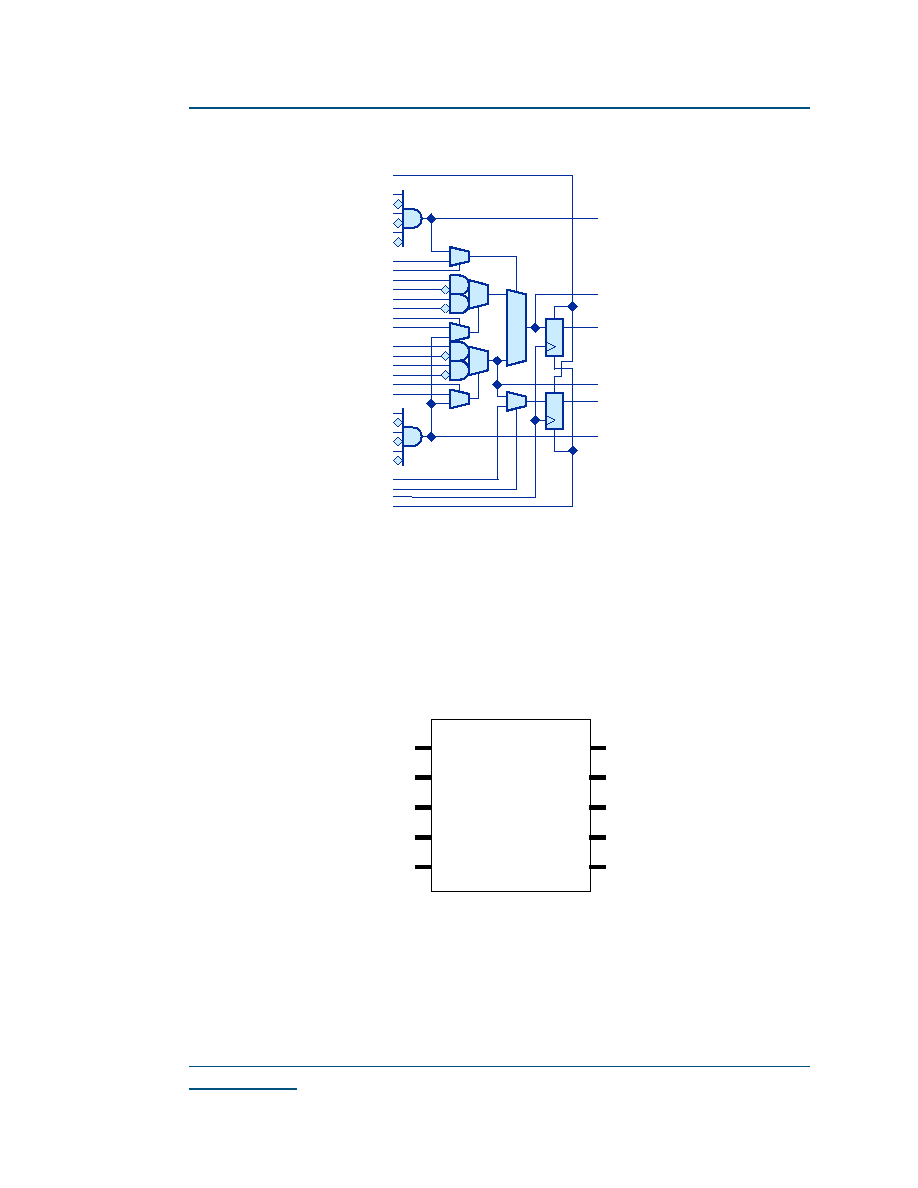
ZZZTXLFNORJLFFRP
4XLFN/RJLF &RUSRUDWLRQ
(FOLSVH,, )DPLO\ 'DWD 6KHHW 5HY %
Preliminary
)LJXUH (FOLSVH,, /RJLF&HOO
5$0 0RGXOHV
The Eclipse-II Product Family includes up to 24 dual-port 2,304-bit RAM modules for
implementing RAM, ROM, and FIFO functions. Each module is user-configurable into four
different block organizations and can be cascaded horizontally to increase their effective width, or
vertically to increase their effective depth as shown in
)LJXUH
.
)LJXUH ELW 5$0 0RGXOH
The number of RAM modules varies from 4 to 24 blocks for a total of 9.2 K to 55.3 K bits of
RAM. Using two "mode" pins, designers can configure each module into 128 x 18 (Mode 0), 256
x 9 (Mode 1), 512 x 4 (Mode 2), or 1024 x 2 blocks (Mode 3). The blocks are also easily
cascadable to increase their effective width and/or depth (see
)LJXUH
).
QS
A1
A2
A3
A4
A5
A6
OS
OP
B1
B2
C1
C2
MS
D1
E1
NP
E2
D2
NS
F1
F3
F5
F6
F2
F4
PS
PP
MP
AZ
OZ
QZ
NZ
FZ
Q2Z
QC
QR
MODE[1:0]
WA[9:0]
WD[17:0]
WE
WCLK
2,304-bit RAM Module
ASYNCRD
RA[9:0]
RD[17:0]
RE
RCLK
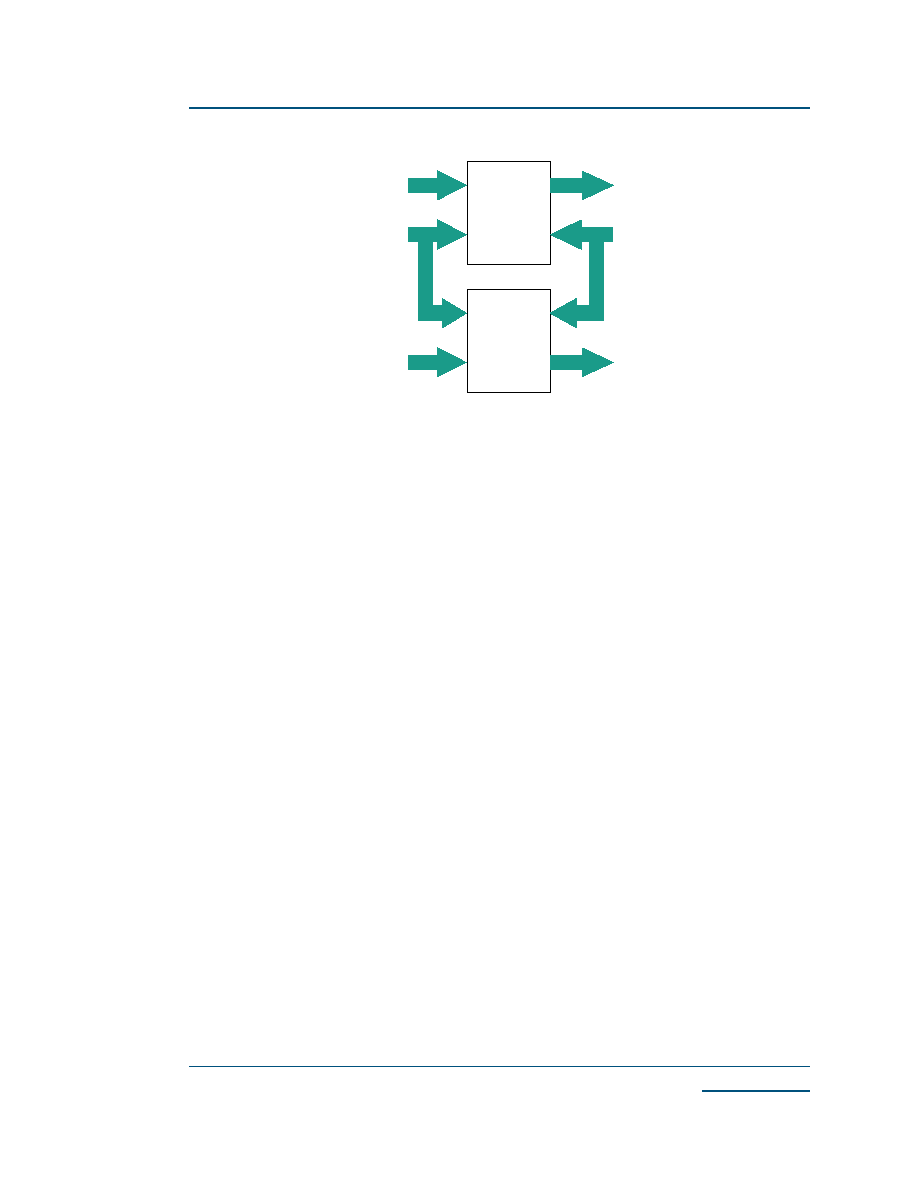
4XLFN/RJLF &RUSRUDWLRQ
ZZZTXLFNORJLFFRP
(FOLSVH,, )DPLO\ 'DWD 6KHHW 5HY %
Preliminary
)LJXUH &DVFDGHG 5$0 0RGXOHV
The RAM modules are dual-port, with completely independent READ and WRITE ports and
separate READ and WRITE clocks. The READ ports support asynchronous and synchronous
operation, while the WRITE ports support synchronous operation. Each port has 18 data lines
and 10 address lines, allowing word lengths of up to 18 bits and address spaces of up to 1,024
words. Depending on the mode selected, however, some higher order data or address lines may
not be used.
The Write Enable (WE) line acts as a clock enable for synchronous write operation. The Read
Enable (RE) acts as a clock enable for synchronous READ operation (ASYNCRD input low), or as
a flow-through enable for asynchronous READ operation (ASYNCRD input high).
Designers can cascade multiple RAM modules to increase the depth or width allowed in single
modules by connecting corresponding address lines together and dividing the words between
modules.
A similar technique can be used to create depths greater than 512 words. In this case address
signals higher than the ninth bit are encoded onto the write enable (WE) input for WRITE
operations. The READ data outputs are multiplexed together using encoded higher READ
address bits for the multiplexer SELECT signals.
The RAM blocks can be loaded with data generated internally (typically for RAM or FIFO
functions) or with data from an external PROM (typically for ROM functions).
(PEHGGHG &RPSXWDWLRQDO 8QLW (&8�
Traditional Programmable Logic architectures do not implement arithmetic functions efficiently
or effectively--these functions require high logic cell usage while garnering only moderate
performance results.
The Eclipse-II architecture allows for functionality above and beyond that achievable using
programmable logic devices. By embedding a dynamically reconfigurable computational unit, the
Eclipse-II device can address various arithmetic functions efficiently. This approach offers greater
performance than traditional programmable logic implementations. The embedded block is
implemented at the transistor level as shown in
)LJXUH
.
WDATA
RDATA
RDATA
WADDR
WDATA
RADDR
RAM
Module
(2,304 bits)
RAM
Module
(2,304 bits)
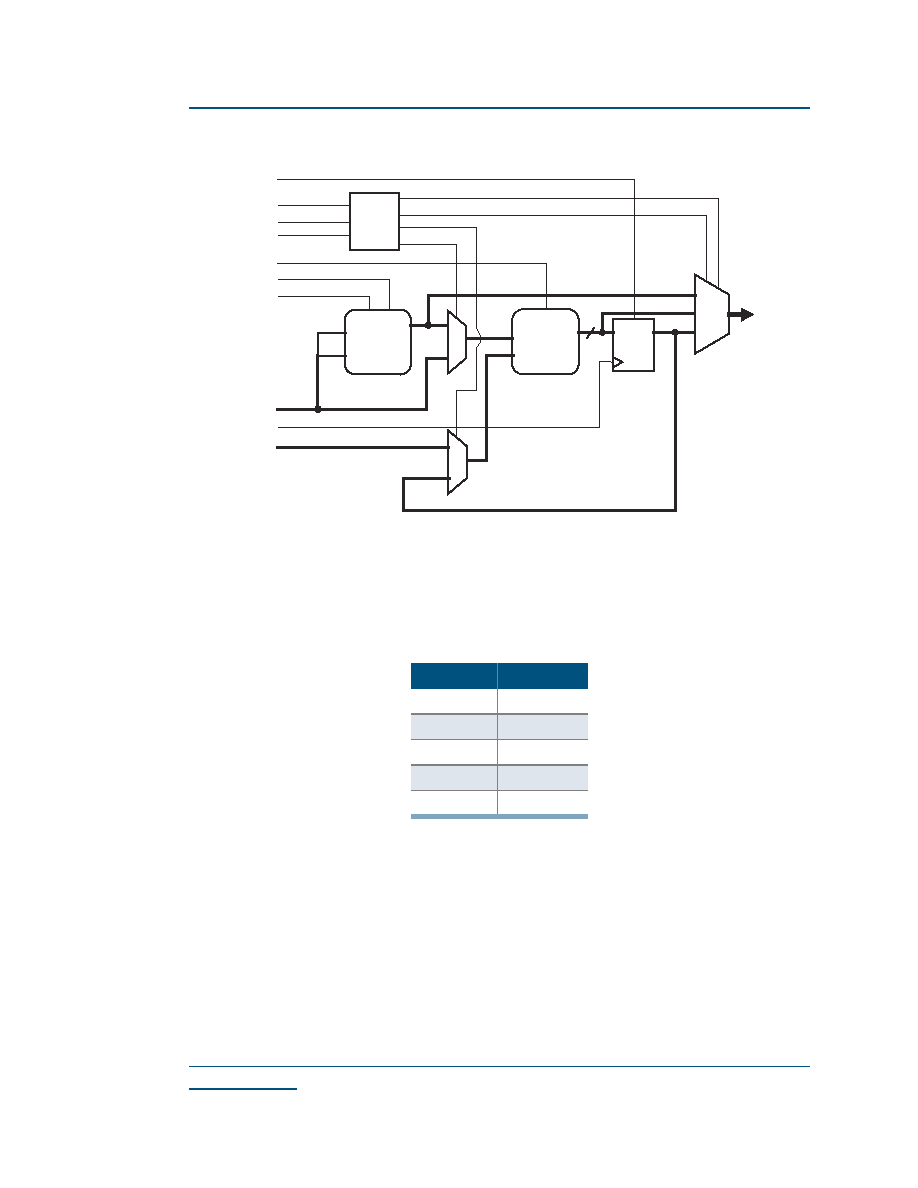
ZZZTXLFNORJLFFRP
4XLFN/RJLF &RUSRUDWLRQ
(FOLSVH,, )DPLO\ 'DWD 6KHHW 5HY %
Preliminary
)LJXUH (&8 %ORFN 'LDJUDP
The Eclipse-II ECU blocks (
7DEOH
) are placed next to the SRAM circuitry for efficient
memory/instruction fetch and addressing for DSP algorithmic implementations.
Up to twelve 8-bit MAC functions can be implemented per cycle for a total of 1 billion MACs/s
when clocked at 100 MHz. Additional multiply-accumulate functions can be implemented in the
programmable logic.
7DEOH (FOLSVH,, (&8 %ORFNV
'HYLFH
(&8V
QL8325
12
QL8250
10
QL8150
0
QL8050
0
QL8025
0
A[0:15]
B[0:15]
SIGN2
SIGN1
CIN
S1
S2
S3
A
B
C
D
3-4
decoder
8-bit
Multiplier
16-bit
Adder
17-bit
Register
2-1
mux
2-1
mux
3-1
mux
Q[16:0]
CLK
RESET
D
Q
00
01
10
A[7:0]
A[15:8]
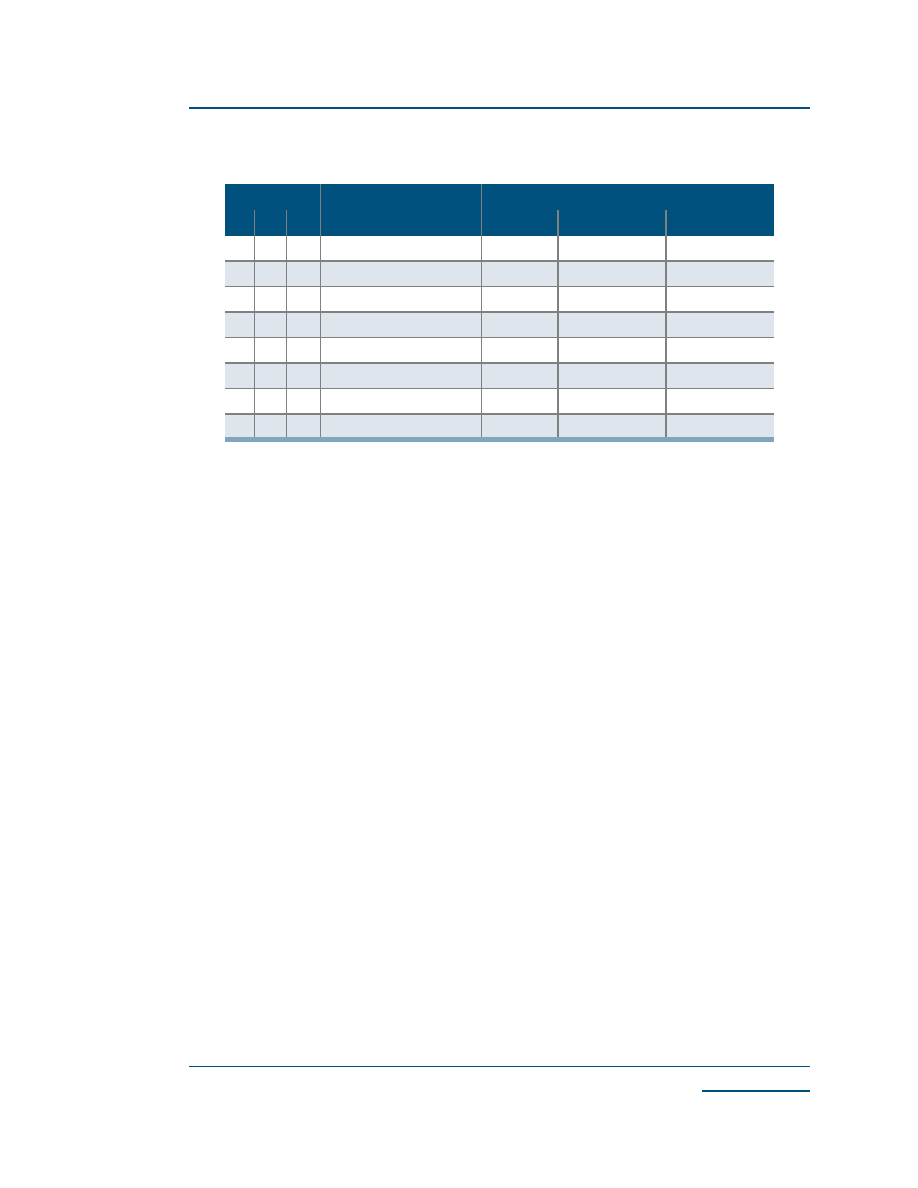
4XLFN/RJLF &RUSRUDWLRQ
ZZZTXLFNORJLFFRP
(FOLSVH,, )DPLO\ 'DWD 6KHHW 5HY %
Preliminary
The modes for the ECU block are dynamically re-programmable through the programmable logic.
NOTE:
7LPLQJ QXPEHUV LQ 7DEOH UHSUHVHQW :RUVW &DVH &RPPHUFLDO FRQGLWLRQV
3KDVH /RFNHG /RRS 3//� ,QIRUPDWLRQ
Instead of requiring extra components, designers simply need to instantiate one of the pre-
configured models (described in this section). The QuickLogic built-in PLLs support a wider range
of frequencies than many other PLLs. These PLLs also have the ability to support different ranges
of frequency multiplications or divisions, driving the device at a faster or slower rate than the
incoming clock frequency. When PLLs are cascaded, the clock signal must be routed off-chip
through the PLLPAD_OUT pin prior to routing into another PLL; internal routing cannot be used
for cascading PLLs.
PLLs achieve a very short clock-to-out time--generally less than 3 ns. This low clock-to-out time
is achieved by the PLL subtracting the clock tree delay through the feedback path, effectively
making the clock tree delay zero.
7DEOH (&8 0RGH 6HOHFW &ULWHULD
,QVWUXFWLRQ
2SHUDWLRQ
(&8 3HUIRUPDQFH
D
:&&
a. t
PD
, t
SU
and t
CO
do not include routing paths in/out of the ECU block.
6 6 6
W
3'
W
68
W
&2
0
0
0
Multiply
6.6 ns max
0
0
1
Multiply-Add
8.8 ns max
0
1
0
Accumulate
b
b. Internal feedback path in ECU restricts max clk frequency to 238 MHz.
3.9 ns min
1.2 ns max
0
1
1
Add
3.1 ns max
1
0
0
Multiply (registered)
c
c. B [15:0] set to zero.
9.6 ns min
1.2 ns max
1
0
1
Multiply- Add (registered)
9.6 ns min
1.2 ns max
1
1
0
Multiply - Accumulate
9.6 ns min
1.2 ns max
1
1
1
Add (registered)
3.9 ns min
1.2 ns max
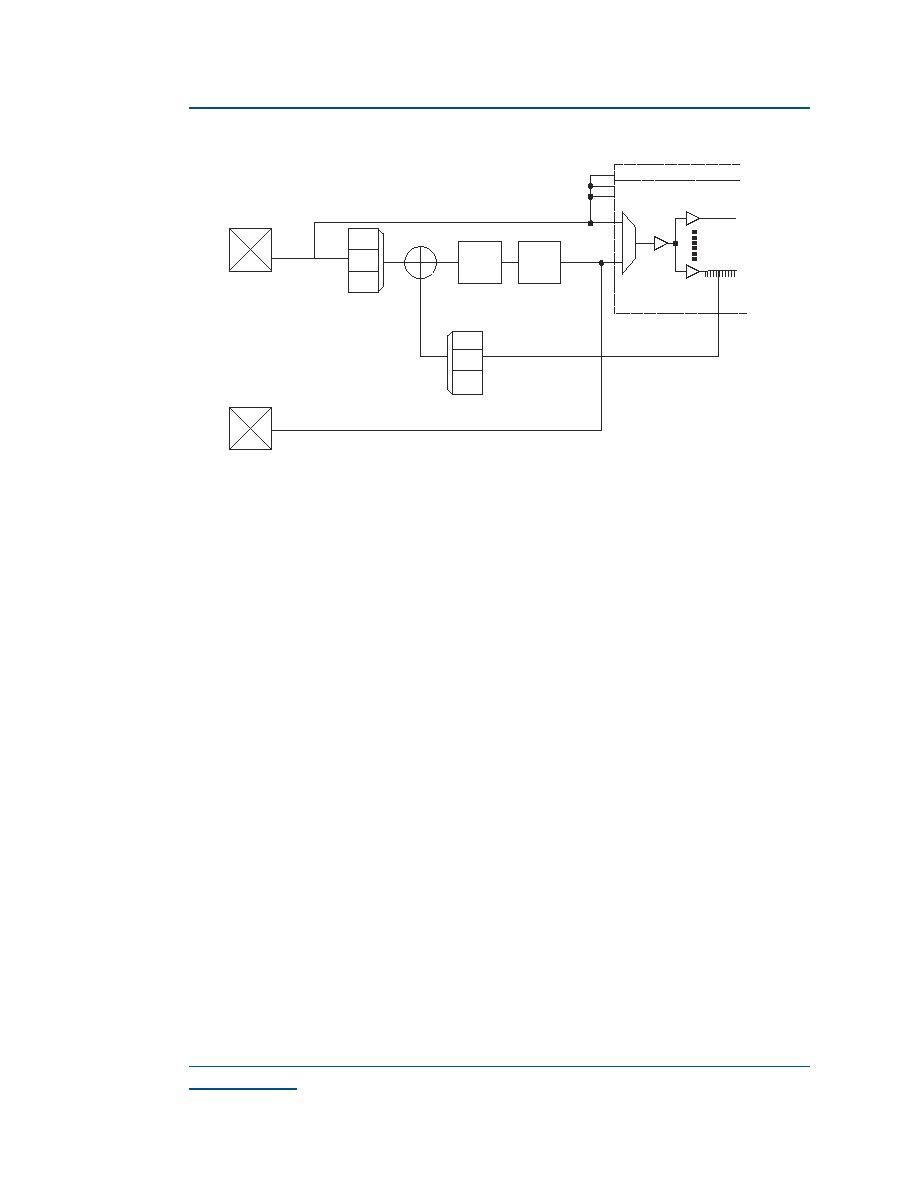
ZZZTXLFNORJLFFRP
4XLFN/RJLF &RUSRUDWLRQ
(FOLSVH,, )DPLO\ 'DWD 6KHHW 5HY %
Preliminary
)LJXUH
illustrates a QuickLogic PLL.
)LJXUH 3// %ORFN 'LDJUDP
F
in
represents a very stable high-frequency input clock and produces an accurate signal reference.
This signal can either bypass the PLL entirely, thus entering the clock tree directly, or it can pass
through the PLL itself.
Within the PLL, a voltage-controlled oscillator (VCO) is added to the circuit. The external F
in
signal
and the local VCO form a control loop. The VCO is multiplied or divided down to the reference
frequency, so that a phase detector (the crossed circle in
)LJXUH
) can compare the two signals.
If the phases of the external and local signals are not within the tolerance required, the phase
detector sends a signal through the charge pump and loop filter (
)LJXUH
). The charge pump
generates an error voltage to bring the VCO back into alignment, and the loop filter removes any
high frequency noise before the error voltage enters the VCO. This new VCO signal enters the
clock tree to drive the chip's circuitry.
F
out
represents the clock signal emerging from the output pad (the output signal PLLPAD_OUT
is explained in
7DEOH
). This clock signal is meaningful only when the PLL is configured for
external use; otherwise, it remains in high Z state.
Most QuickLogic products contain four PLLs. The PLL presented in
)LJXUH
controls the clock
tree in the fourth quadrant of its FPGA. QuickLogic PLLs compensate for the additional delay
created by the clock tree itself, as previously noted, by subtracting the clock tree delay through the
feedback path.
For more specific information on the Phase Locked Loops, please refer to QuickLogic
Application Note 58.
3// 0RGHV RI 2SHUDWLRQ
QuickLogic PLLs have eight modes of operation, based on the input frequency and desired output
frequency--
7DEOH
indicates the features of each mode.
vco
Filter
FIN
FOUT
+
-
1st Quadrant
2nd Quadrant
3rd Quadrant
4th Quadrant
Clock
Tree
Frequency Divide
Frequency Multiply
1
._
.
2
._
.
4
._
.
4
._
.
2
._
.
1
.
._
PLL Bypass
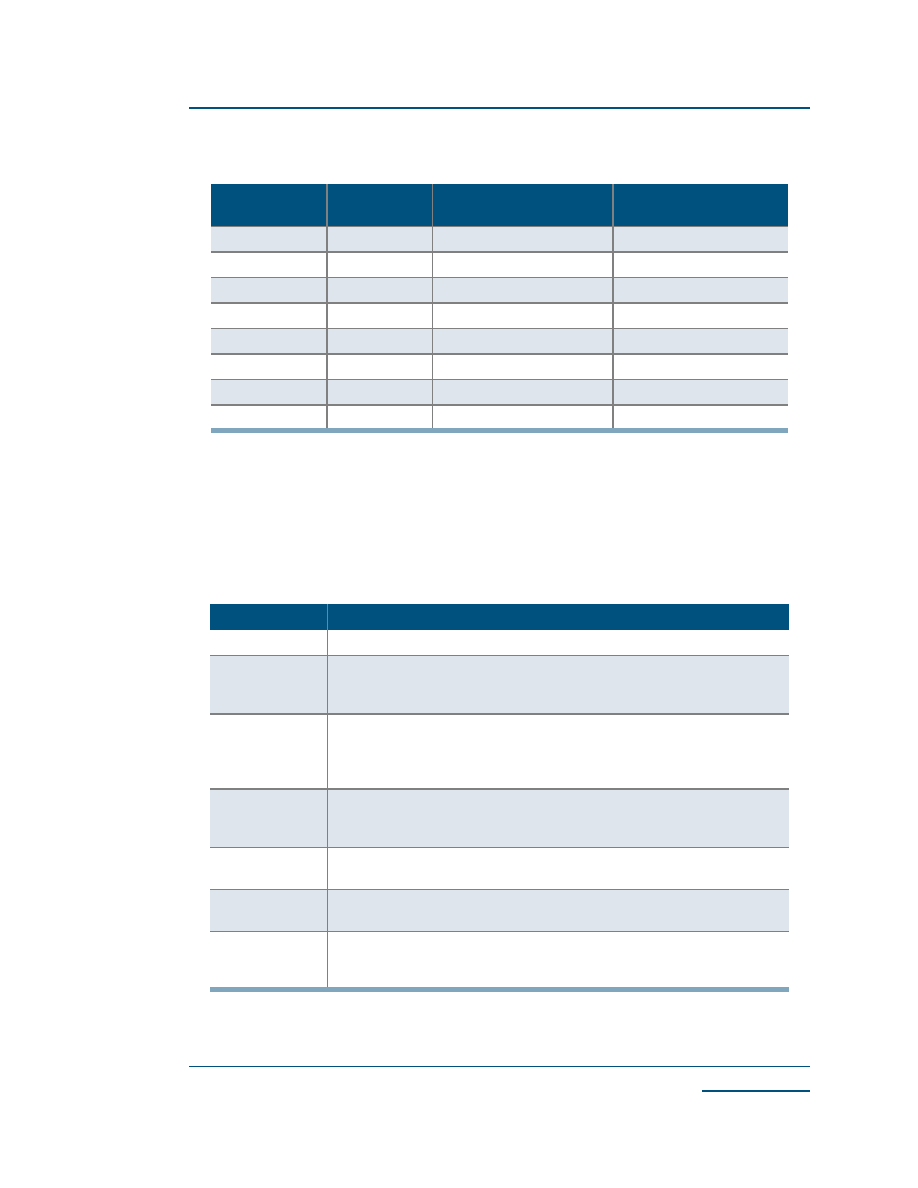
4XLFN/RJLF &RUSRUDWLRQ
ZZZTXLFNORJLFFRP
(FOLSVH,, )DPLO\ 'DWD 6KHHW 5HY %
Preliminary
NOTE:
+) VWDQGV IRU KLJK IUHTXHQF\ DQG /) VWDQGV IRU ORZ IUHTXHQF\
The input frequency can range from 16 MHz to 300 MHz, while output frequency ranges from
25 MHz to 250 MHz. When you add PLLs to your top-level design, be sure that the PLL mode
matches your desired input and output frequencies.
3// 6LJQDOV
7DEOH
summarizes the key signals in QuickLogic's PLLs.
NOTE:
%HFDXVH 3//&/.B,1 DQG 3//B5(6(7 VLJQDOV KDYH3//B,13$' DQG 3//3$'B287
KDV 2873$' \RX GR QRW KDYH WR DGG DGGLWLRQDO SDGV WR \RXU GHVLJQ
7DEOH 3// 0RGH )UHTXHQFLHV
3// 0RGHO
2XWSXW
)UHTXHQF\
,QSXW )UHTXHQF\ 5DQJH
2XWSXW )UHTXHQF\ 5DQJH
PLL_HF
Same as input
66 MHz≠150 MHz
66 MHz≠150 MHz
PLL_LF
Same as input
25 MHz≠133 MHz
25 MHz≠133 MHz
PLL_MULT2HF
2x
50 MHz≠125 MHz
100 MHz≠250 MHz
PLL_MULT2LF
2x
16 MHz≠50 MHz
32 MHz≠100 MHz
PLL_DIV2HF
1/2x
100 MHz≠250 MHz
50 MHz≠125 MHz
PLL_DIV2LF
1/2x
50 MHz≠100 MHz
25 MHz≠50 MHz
PLL_MULT4
4x
16 MHz≠40 MHz
64 MHz≠160 MHz
PLL_DIV4
1/4x
100 MHz≠300 MHz
25 MHz≠75 MHz
7DEOH 4XLFN/RJLF 3// 6LJQDOV
6LJQDO 1DPH
'HVFULSWLRQ
PLLCLK_IN
Input clock signal
PLL_RESET
Active High Reset
If PLL_RESET is asserted, then CLKNET_OUT and
PLLPAD_OUT are reset to 0. This signal must be asserted and then released
in order for the LOCK_DETECT to work.
ONn_OFFCHIP
PLL output
This signal selects whether the PLL will drive the internal clock
network or be used off-chip. This is a static signal, not a dynamic signal.
Tied to GND = outgoing signal drives internal gates.
Tied to VCC = outgoing signal used off-chip.
CLKNET_OUT
Out to internal gates
This signal bypasses the PLL logic before driving the
internal gates. Note that this signal cannot be used in the same quadrant where
the PLL signal is used (PLLCLK_OUT).
PLLCLK_OUT
Out from PLL to internal gates
This signal can drive the internal gates after
going through the PLL. For this to work, ONn_OFFCHIP must be tied to GND.
PLLPAD_OUT
Out to off-chip
This outgoing signal is used off-chip. For this to work,
ONn_OFFCHIP signal must be tied to VCC.
LOCK_DETECT
Active High Lock detection signal
NOTE: For simulation purposes, this
signal gets asserted after 10 clock cycles. However, it can take a maximum of
200 clock cycles to sync with the input clock upon release of the RESET signal.
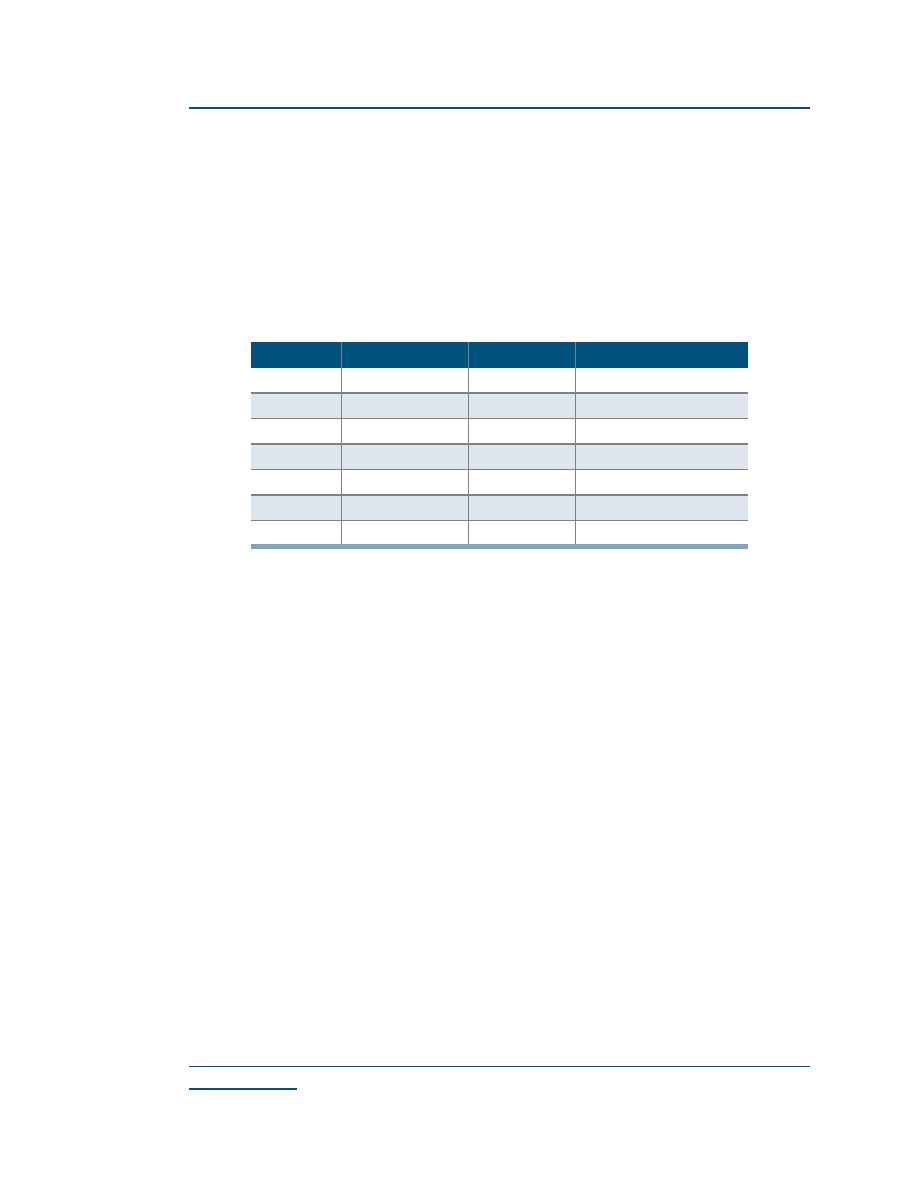
ZZZTXLFNORJLFFRP
4XLFN/RJLF &RUSRUDWLRQ
(FOLSVH,, )DPLO\ 'DWD 6KHHW 5HY %
Preliminary
,2 &HOO 6WUXFWXUH
Eclipse-II features a variety of distinct I/O pins to maximize performance, functionality, and
flexibility with bi-directional I/O pins and input-only pins. All input and I/O pins are 1.8 V, 2.5 V,
and 3.3 V tolerant and comply with the specific I/O standard selected. For single ended I/O
standards, VCCIO specifies the input tolerance and the output drive. For voltage referenced I/O
standards (e.g SSTL), the voltage supplied to the INREF pins in each bank specifies the input
switch point. For example, the VCCIO pins must be tied to a 3.3 V supply to provide 3.3 V
compliance. Eclipse-II
can also support the LVDS and LVPECL I/O standards with the use of
external resistors ( see
7DEOH
).
As designs become more complex and requirements more stringent, several
application-specific I/O standards have emerged for specific applications. I/O standards for
processors, memories, and a variety of bus applications have become commonplace and a
requirement for many systems. In addition, I/O timing has become a greater issue with specific
requirements for setup, hold, clock to out, and switching times. Eclipse-II has addressed these new
system requirements and now includes a completely new I/O cell which consists of programmable
I/Os as well as a new cell structure consisting of three registers--Input, Output, and OE.
Eclipse-II offers banks of programmable I/Os that address many of the bus standards that are
popular today. As shown in
)LJXUH
each bi-directional I/O pin is associated with an I/O cell
which features an input register, an input buffer, an output register, a three-state output buffer, an
output enable register, and 2 two-to-one output multiplexers.
7DEOH ,2 6WDQGDUGV DQG $SSOLFDWLRQV
,2 6WDQGDUG 5HIHUHQFH 9ROWDJH 2XWSXW 9ROWDJH
$SSOLFDWLRQ
LVTTL
n/a
3.3 V
General Purpose
LVCMOS25
n/a
2.5 V
General Purpose
LVCMOS18
n/a
1.8 V
General Purpose
PCI
n/a
3.3 V
PCI Bus Applications
GTL+
1
n/a
Backplane
SSTL3
1.5
3.3 V
SDRAM
SSTL2
1.25
2.5 V
SDRAM

4XLFN/RJLF &RUSRUDWLRQ
ZZZTXLFNORJLFFRP
(FOLSVH,, )DPLO\ 'DWD 6KHHW 5HY %
Preliminary
)LJXUH (FOLSVH,,
,2 &HOO
The bi-directional I/O pin options can be programmed for input, output, or bi-directional
operation. As shown in
)LJXUH
, each bi-directional I/O pin is associated with an I/O cell which
features an input register, an input buffer, an output register, a three-state output buffer, an output
enable register, and 2 two-to-one multiplexers. The select lines of the two-to-one multiplexers are
static and must be connected to either Vcc or GND.
For input functions, I/O pins can provide combinatorial, registered data, or both options
simultaneously to the logic array. For combinatorial input operation, data is routed from I/O pins
through the input buffer to the array logic. For registered input operation, I/O pins drive the D
input of input cell registers, allowing data to be captured with fast set-up times without consuming
internal logic cell resources. The comparator and multiplexor in the input path allows for native
support of I/O standards with reference points offset from traditional ground.
For output functions, I/O pins can receive combinatorial or registered data from the logic array.
For combinatorial output operation, data is routed from the logic array through a multiplexer to
the I/O pin. For registered output operation, the array logic drives the D input of the output cell
register which in turn drives the I/O pin through a multiplexer. The multiplexer allows either a
combinatorial or a registered signal to be driven to the I/O pin. The addition of an output register
will also decrease the Tco. Since the output register does not need to drive the routing the length
of the output path is also reduced.
The three-state output buffer controls the flow of data from the array logic to the I/O pin and
allows the I/O pin to act as an input and/or output. The buffer's output enable can be individually
controlled by the logic cell array or any pin (through the regular routing resources), or it can be
bank-controlled through one of the global networks. The signal can also be either combinatorial
E
R
Q
D
R
Q
D
E
R
Q
D
+
-
PAD
OUTPUT ENABLE
REGISTER
OUTPUT
REGISTER
INPUT
REGISTER

ZZZTXLFNORJLFFRP
4XLFN/RJLF &RUSRUDWLRQ
(FOLSVH,, )DPLO\ 'DWD 6KHHW 5HY %
Preliminary
or registered. This is identical to that of the flow for the output cell. For combinatorial control
operation data is routed from the logic array through a multiplexer to the three-state control. The
IOCTRL pins can directly drive the OE and CLK signals for all I/O cells within the same bank.
For registered control operation, the array logic drives the D input of the OE cell register which
in turn drives the three-state control through a multiplexer. The multiplexer allows either a
combinatorial or a registered signal to be driven to the three-state control.
When I/O pins are unused, the OE controls can be permanently disabled, allowing the output cell
register to be used for registered feedback into the logic array.
I/O cell registers are controlled by clock, clock enable, and reset signals, which can come from
the regular routing resources, from one of the global networks, or from two IOCTRL input pins
per bank of I/O's. The CLK and RESET signals share common lines, while the clock enables for
each register can be independently controlled. I/O interface support is programmable on a per
bank basis. The two larger Eclipse-II devices contain eight I/O banks.The two smaller Eclipse-II
devices contain two I/O banks per device.
)LJXUH
illustrates the I/O bank configurations.
Each I/O bank is independent of other I/O banks and each I/O bank has its own VCCIO and
INREF supply inputs. A mixture of different I/O standards can be used on the device; however,
there is a limitation as to which I/O standards can be supported within a given bank. Only
standards that share a common VCCIO and INREF can be shared within the same bank (e.g. PCI
and LVTTL).
)LJXUH 0XOWLSOH ,2 %DQNV
3URJUDPPDEOH 6OHZ 5DWH
Each I/O has programmable slew rate capability--the slew rate can be either fast or slow. The
slower rate can be used to reduce the switching times of each I/O.
Embedded RAM Blocks
PLL
PLL
Fabric
Embeded Computational Units
Embedded RAM Blocks
PLL
PLL
VCCIO 0
INREF 0
VCCIO 1
INREF 1
VCCIO 2
INREF 2
VCCIO 3
INREF 3
INREF 4
VCCIO 4
INREF 5
VCCIO 5
INREF 6
VCCIO 6
INREF 7
VCCIO 7

4XLFN/RJLF &RUSRUDWLRQ
ZZZTXLFNORJLFFRP
(FOLSVH,, )DPLO\ 'DWD 6KHHW 5HY %
Preliminary
3URJUDPPDEOH :HDN 3XOO'RZQ
A programmable Weak Pull-Down resistor is available on each I/O. The I/O Weak Pull-Down
eliminates the need for external pull down resistors for used I/Os. The spec for pull-down current
is maximum of 150
µ
A under worst case condition.
)LJXUH 3URJUDPPDEOH ,2 :HDN 3XOO'RZQ
&ORFN 1HWZRUNV
*OREDO &ORFNV
There are a maximum of eight global clock networks in each Eclipse-II
device. Global clocks can
drive logic cells and I/O registers, ECUs, and RAM blocks in the device. All global clocks have
access to a Quad Net (local clock network) connection with a programmable connection to the
logic cell's register clock input.
I/O Output Logic
PAD
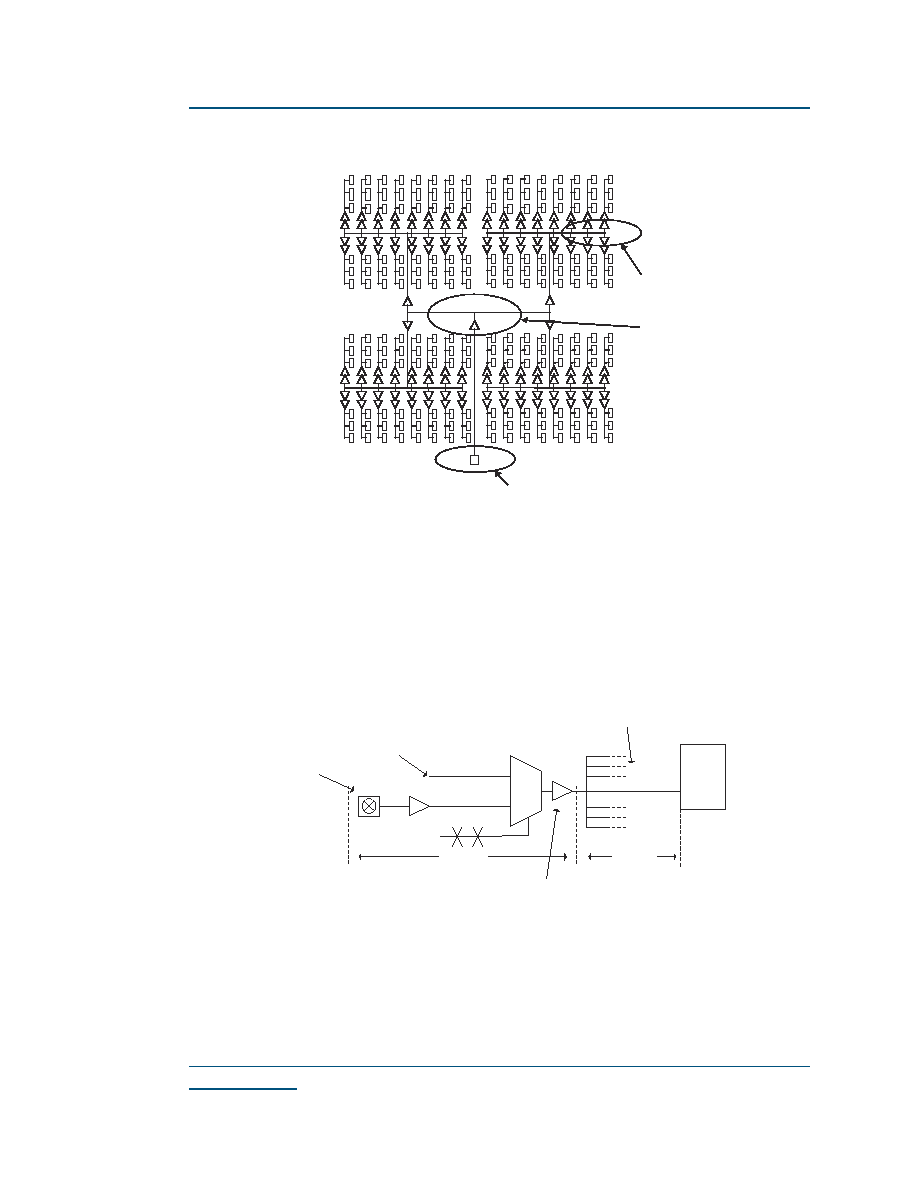
ZZZTXLFNORJLFFRP
4XLFN/RJLF &RUSRUDWLRQ
(FOLSVH,, )DPLO\ 'DWD 6KHHW 5HY %
Preliminary
)LJXUH *OREDO &ORFN $UFKLWHFWXUH
4XDG1HW 1HWZRUN
There are five Quad-Net local clock networks in each quadrant for a total of 20 in a device.
Each Quad-Net is local to a quadrant. Before driving the columns clock buffers, the quad-net is
driven by the output of a mux which selects between the GCLK input and an internally generated
clock source (see
)LJXUH
).
)LJXUH *OREDO &ORFN 6WUXFWXUH 6FKHPDWLF
Quad Net
GCLK Pin
Global Clock Net
tPGCK
tBGCK
Internally generated clock, or
clock from general routing network
Global Clock
(GCLK) Input
Global Clock Network
FF
Global Clock Buffer
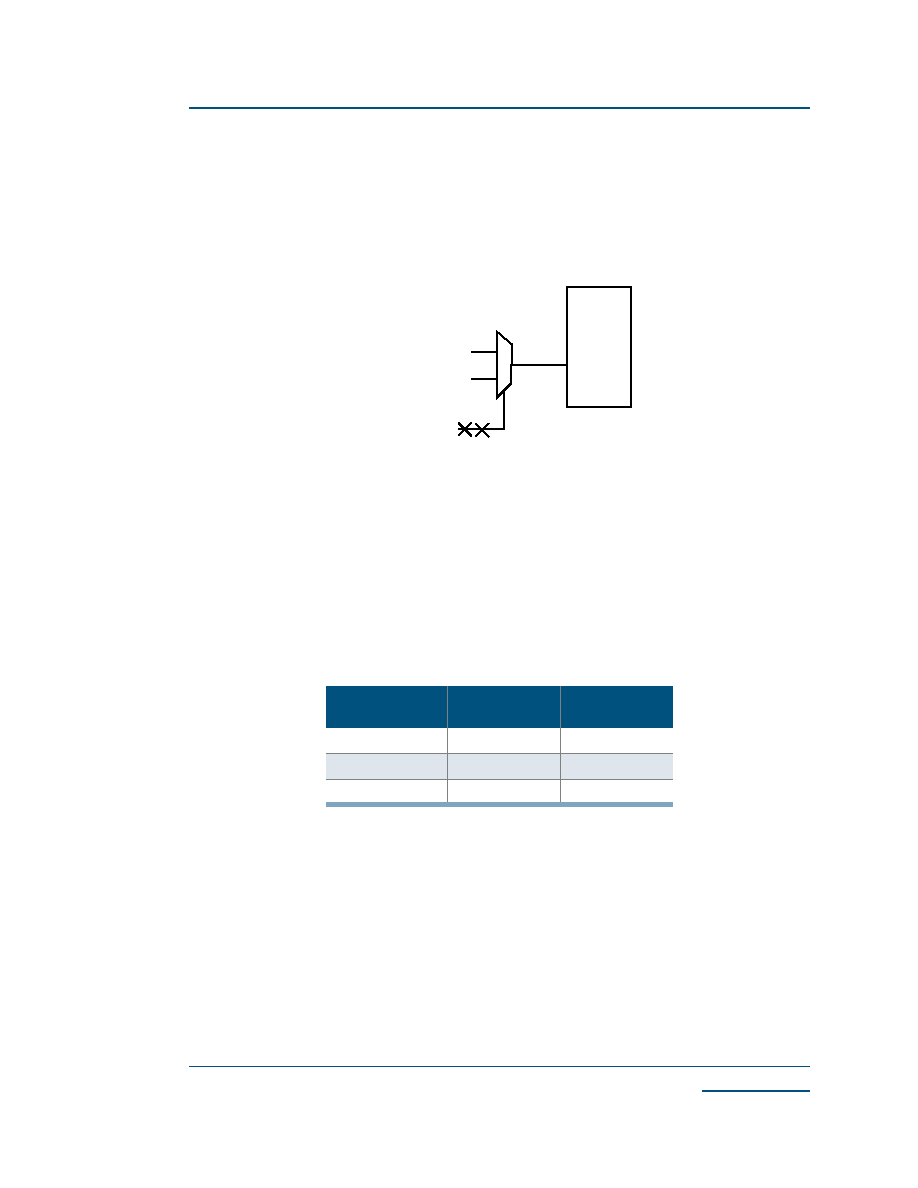
4XLFN/RJLF &RUSRUDWLRQ
ZZZTXLFNORJLFFRP
(FOLSVH,, )DPLO\ 'DWD 6KHHW 5HY %
Preliminary
'HGLFDWHG &ORFN
There is one dedicated clock in the two larger devices of the Eclipse-II Family (QL8325 and
QL8250). This clock connects to the clock input of the LogicCell and I/O registers, and RAM
blocks through a hardwired connection and is multiplexed with the programmable clock input.
The dedicated clock provides a fast global network with low skew. Users have the ability to select
either the dedicated clock or the programmable clock (
)LJXUH
).
)LJXUH 'HGLFDWHG &ORFN &LUFXLWU\ ZLWKLQ /RJLF &HOO
NOTE:
)RU PRUH LQIRUPDWLRQ RQ WKH FORFNLQJ FDSDELOLWLHV RI (FOLSVH,, )3*$V SOHDVH VHH WKH
4XLFN/RJLF $SSOLFDWLRQ 1RWH
,2 &RQWURO DQG /RFDO +L'ULYHV
Each bank of I/Os has two input-only pins that can be programmed to drive the RST, CLK, and
EN inputs of I/Os in that bank. These input-only pins also serve as high drive inputs to a quadrant.
These buffers can be driven by the internal logic both as an I/O control or high drive. The
performance of these drives is presented in
7DEOH
.
3URJUDPPDEOH /RJLF 5RXWLQJ
Eclipse-II devices are delivered with six types of routing resources as follows: short (sometimes
called segmented) wires, dual wires, quad wires, express wires, distributed networks, and default
wires. Short wires span the length of one logic cell, always in the vertical direction. Dual wires run
horizontally and span the length of two logic cells. Short and dual wires are predominantly used
for local connections. Default wires supply VCC and GND (Logic `1' and Logic `0') to each
column of logic cells.
Quad wires have passive link interconnect elements every fourth logic cell. As a result, these wires
are typically used to implement intermediate length or medium fan-out nets.
7DEOH ,2 &RQWURO 1HWZRUN/RFDO +LJK'ULYH
'HVWLQDWLRQ
77
& 9
)URP 3DG
)URP $UUD\
I/O (far)
1.00 ns
1.14 ns
I/O (near)
0.63 ns
0.78 ns
Skew
0.37 ns
0.36 ns
Programmable Clock or
General Routing
Dedicated Clock
CLK
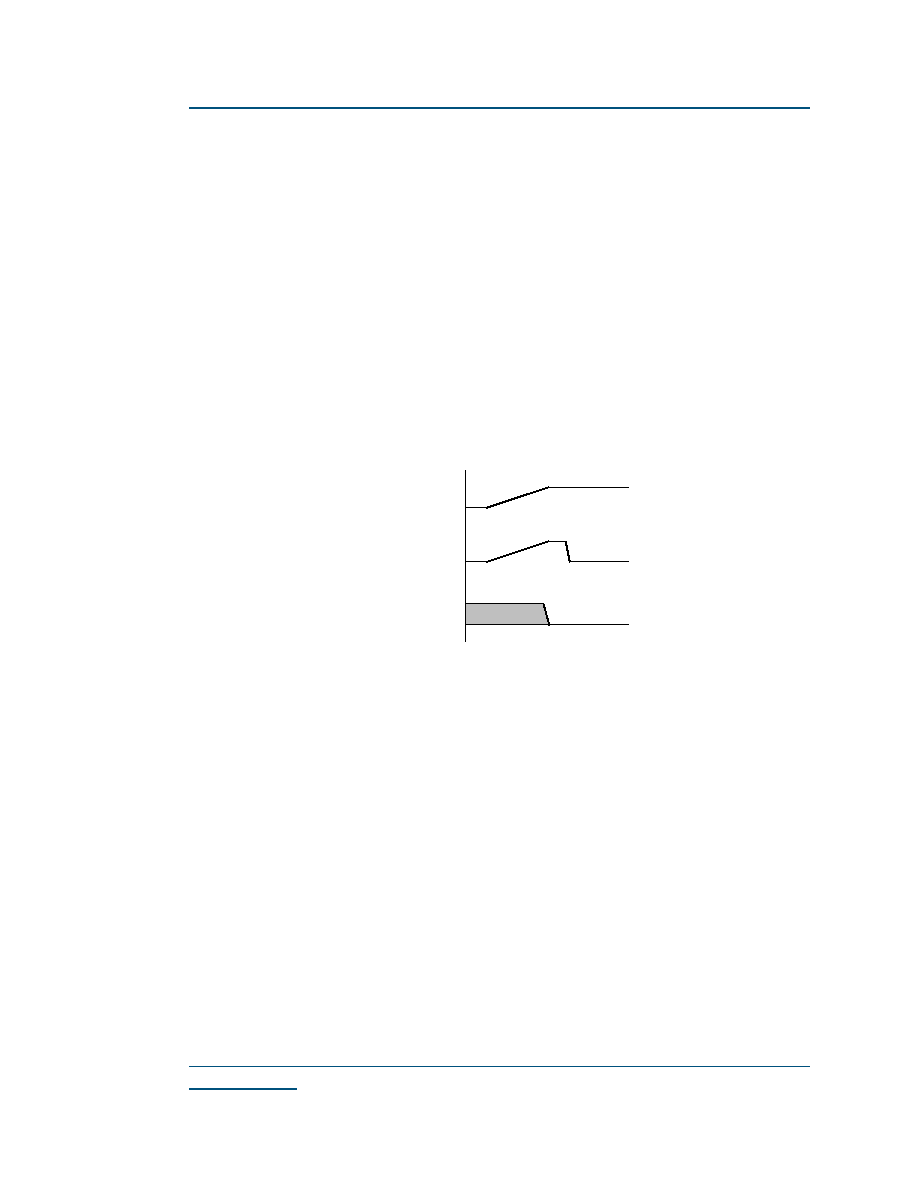
ZZZTXLFNORJLFFRP
4XLFN/RJLF &RUSRUDWLRQ
(FOLSVH,, )DPLO\ 'DWD 6KHHW 5HY %
Preliminary
Express lines run the length of the programmable logic uninterrupted. Each of these lines has a
higher capacitance than a quad, dual, or short wire, but less capacitance than shorter wires
connected to run the length of the device. The resistance will also be lower because the express
wires don't require the use of "pass" links. Express wires provide higher performance for long
routes or high fan-out nets.
Distributed networks are described in the clock/control section. These wires span the
programmable logic and are driven by "column clock" buffers. All clock network pin buffers (both
Dedicated and Global) are hard wired to individual sets of column clock buffers.
*OREDO 3RZHU2Q 5HVHW 325�
The Eclipse-II
family of devices features a global power-on reset. This reset is hardwired to all
registers and resets them to Logic `0' upon power-up of the device. In QuickLogic devices, the
aynchronous Reset input to flip-flops has priority over the Set input; therefore, the Global POR
will reset all flip-flops during power-up. If you want to set the flip-flops to Logic `1', you must assert
the "Set" signal after the Global POR signal has been deasserted.
)LJXUH 3RZHU2Q 5HVHW
/RZ 3RZHU 0RGH
Power consumption of the two smaller Eclipse-II devices can be reduced significantly by de-
activating the charge pumps inside the architecture. By applying 3.3 V to the Vpump pin, the
internal charge pump is de-activated--this effectively reduces the dynamic power consumption of
the device. Users who have a 3.3 V supply available in their system should take advantage of this
low power feature by tying the Vpump pin to 3.3 V. Otherwise, if a 3.3 V supply is not available,
this pin should be tied to ground.
VCC
Power-on
Reset
Q
XXXXXXX
0
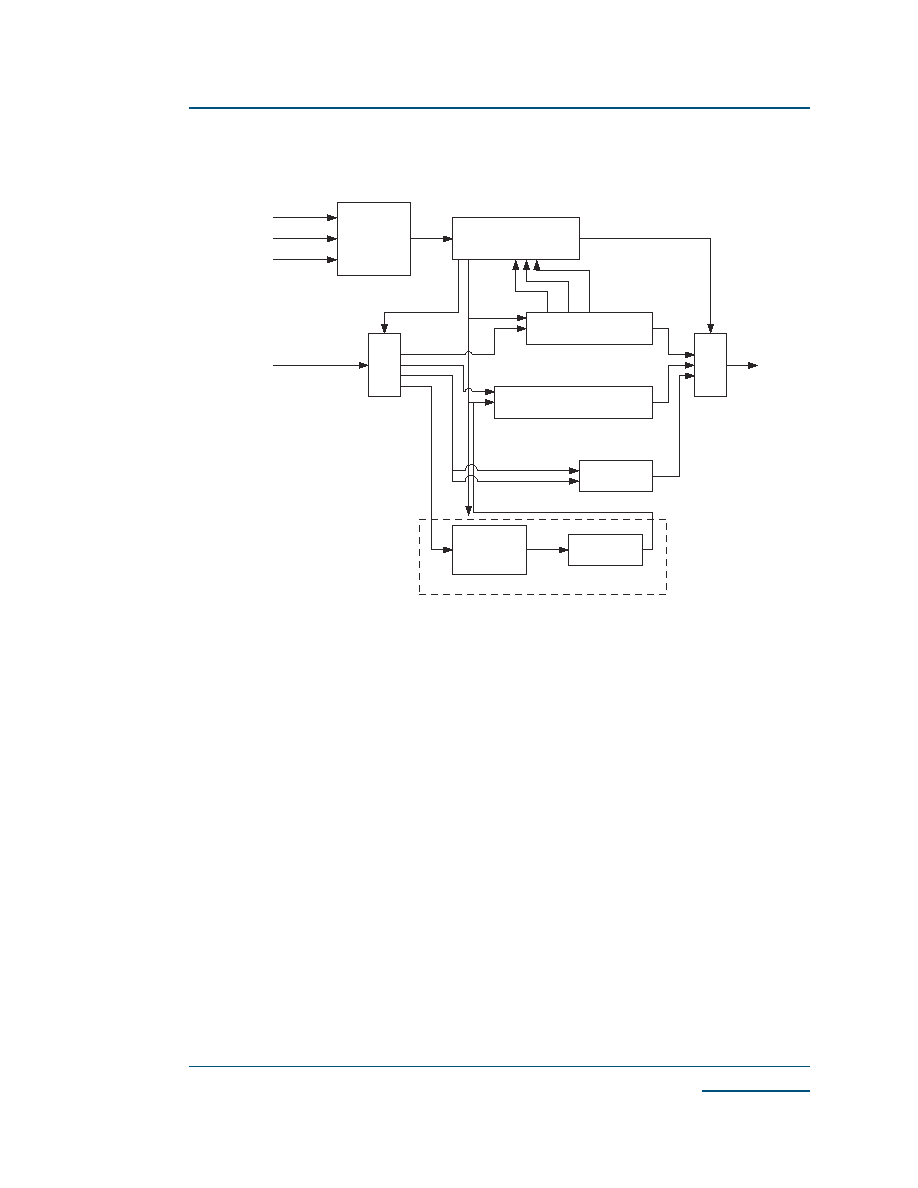
4XLFN/RJLF &RUSRUDWLRQ
ZZZTXLFNORJLFFRP
(FOLSVH,, )DPLO\ 'DWD 6KHHW 5HY %
Preliminary
-RLQW 7HVW $FFHVV *URXS -7$*� ,QIRUPDWLRQ
)LJXUH -7$* %ORFN 'LDJUDP
Microprocessors and Application Specific Integrated Circuits (ASICs) pose many design
challenges, one problem being the accessibility of test points. JTAG formed in response to this
challenge, resulting in IEEE standard 1149.1, the Standard Test Access Port and Boundary Scan
Architecture.
The JTAG boundary scan test methodology allows complete observation and control of the
boundary pins of a JTAG-compatible device through JTAG software. A Test Access Port (TAP)
controller works in concert with the Instruction Register (IR), which allow users to run three
required tests along with several user-defined tests.
JTAG tests allow users to reduce system debug time, reuse test platforms and tools, and reuse
subsystem tests for fuller verification of higher level system elements.
The 1149.1 standard requires the following three tests:
∑
Extest Instruction.
The Extest instruction performs a PCB interconnect test. This test
places a device into an external boundary test mode, selecting the boundary scan register to
be connected between the TAP's Test Data In (TDI) and Test Data Out (TDO) pins. Boundary
scan cells are preloaded with test patterns (via the Sample/Preload Instruction), and input
boundary cells capture the input data for analysis.
∑
Sample/Preload Instruction.
This instruction allows a device to remain in its functional
mode, while selecting the boundary scan register to be connected between the TDI and TDO
pins. For this test, the boundary scan register can be accessed via a data scan operation,
allowing users to sample the functional data entering and leaving the device.
TCK
TMS
TRSTB
RDI
TDO
Instruction Decode
&
Control Logic
Tap Controller
State Machine
(16 States)
Instruction Register
Boundary-Scan Register
(Data Register)
Mux
Bypass
Register
Mux
Internal
Register
I/O Registers
User Defined Data Register

ZZZTXLFNORJLFFRP
4XLFN/RJLF &RUSRUDWLRQ
(FOLSVH,, )DPLO\ 'DWD 6KHHW 5HY %
Preliminary
∑
Bypass Instruction.
The Bypass instruction allows data to skip a device's boundary scan
entirely, so the data passes through the bypass register. The Bypass instruction allows users
to test a device without passing through other devices. The bypass register is connected
between the TDI and TDO pins, allowing serial data to be transferred through a device
without affecting the operation of the device.
-7$* %6'/ 6XSSRUW
∑
BSDL-Boundary Scan Description Language
∑
Machine-readable data for test equipment to generate testing vectors and software
∑
BSDL files available for all device/ package combinations from QuickLogic
∑
Extensive industry support available and ATVG (Automatic Test Vector Generation)
6HFXULW\ IXVHV
There are two security links: one to disable reading logic from the array, and the second to disable
JTAG access to the device. Programming these optional links completely disables access to the
device from the outside world and provides an extra level of design security not possible in SRAM-
based FPGAs. The option to program these fuses is selectable via QuickWorks in the
Tools/Options/Device Programming window in SpDE.
)OH[LELOLW\ IXVH
The flexibility link enables Power-Up loading of the Embedded RAM blocks. If the link is
programmed, the Power Up Loading state machine is activated during power-up of the device.
The state machine communicates with an external EPROM via the JTAG pins to download
memory contents into the on-chip RAM. If the link is not programmed, Power-Up Loading is not
enabled and the JTAG pins function as they normally would. The option to program this bit is
selectable via QuickWorks in the Tools/Options/Device Programming window in SpDE. For
more information on Power-Up Loading refer to QuickLogic Application Note 55.
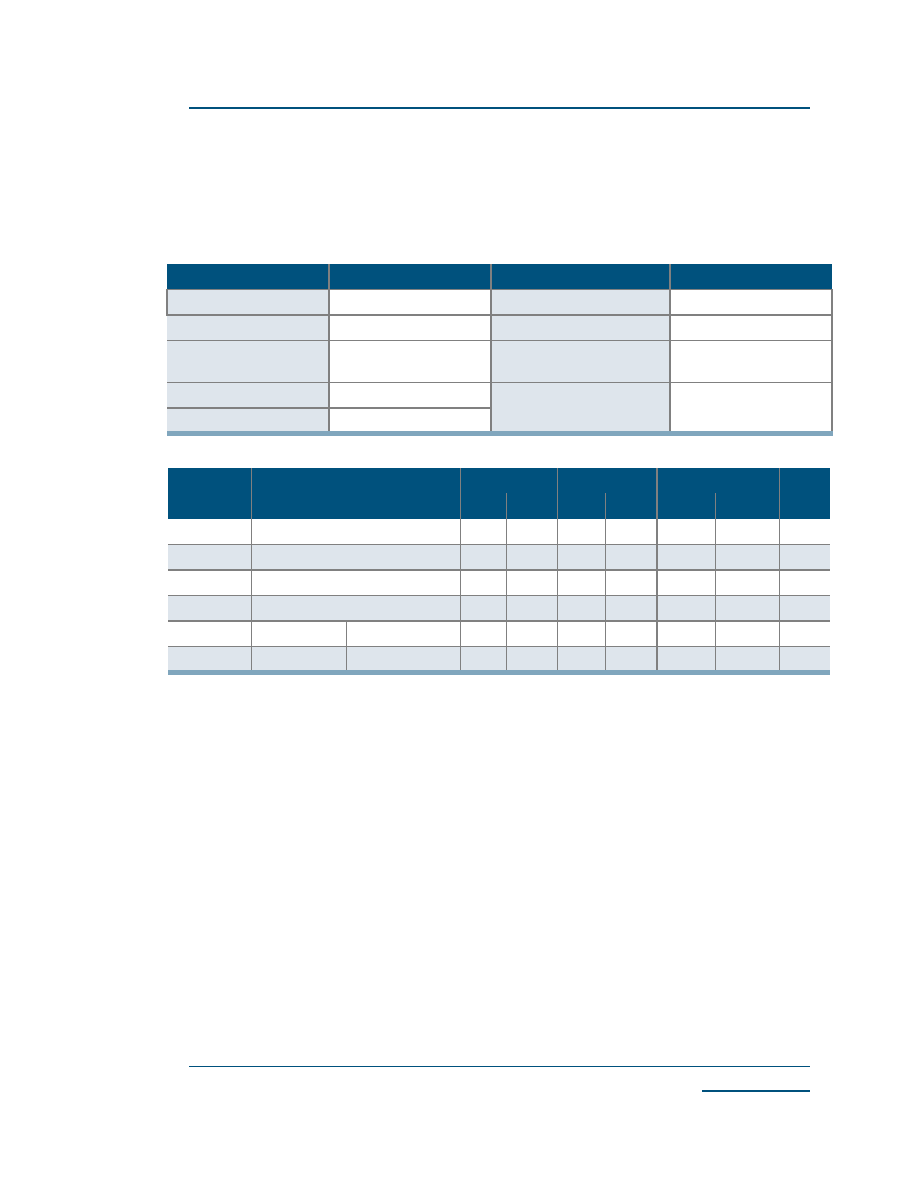
4XLFN/RJLF &RUSRUDWLRQ
ZZZTXLFNORJLFFRP
(FOLSVH,, )DPLO\ 'DWD 6KHHW 5HY %
Preliminary
(OHFWULFDO 6SHFLILFDWLRQV
'& &KDUDFWHULVWLFV
The DC Specifications are provided in
7DEOH
through
7DEOH
.
7DEOH $EVROXWH 0D[LPXP 5DWLQJV
3DUDPHWHU
9DOXH
3DUDPHWHU
9DOXH
V
CC
Voltage
-0.5 V to 2.0 V
DC Input Current
±20 mA
V
CCIO
Voltage
-0.5 V to 4.0 V
ESD Pad Protection
±2000 V
INREF
Voltage
0.5 V to V
CCIO
Leaded Package
Storage Temperature
-65∞ C to + 150∞ C
Input Voltage
-0.5 V to V
CCIO
+ 0.5 V
Laminate Package (BGA)
Storage Temperature
-55∞ C to + 125∞ C
Latch-up Immunity
±100 mA
7DEOH 2SHUDWLQJ 5DQJH
6\PERO
3DUDPHWHU
0LOLWDU\
,QGXVWULDO
&RPPHUFLDO
8QLW
0LQ
0D[
0LQ
0D[
0LQ
0D[
V
CC
Supply Voltage
1.71
1.98
1.71
1.98
1.71
1.98
V
V
CCIO
I/O Input Tolerance Voltage
1.71
3.60
1.71
3.60
1.71
3.60
V
TA
Ambient Temperature
-55
-
-40
85
0
70
∞C
TC
Case Temperature
-
125
-
-
-
-
∞C
K
Delay Factor
-7 Speed Grade
0.42
1.35
0.43
1.26
0.46
1.23
n/a
-8 Speed Grade
0.42
1.27
0.43
1.19
0.46
1.16
n/a
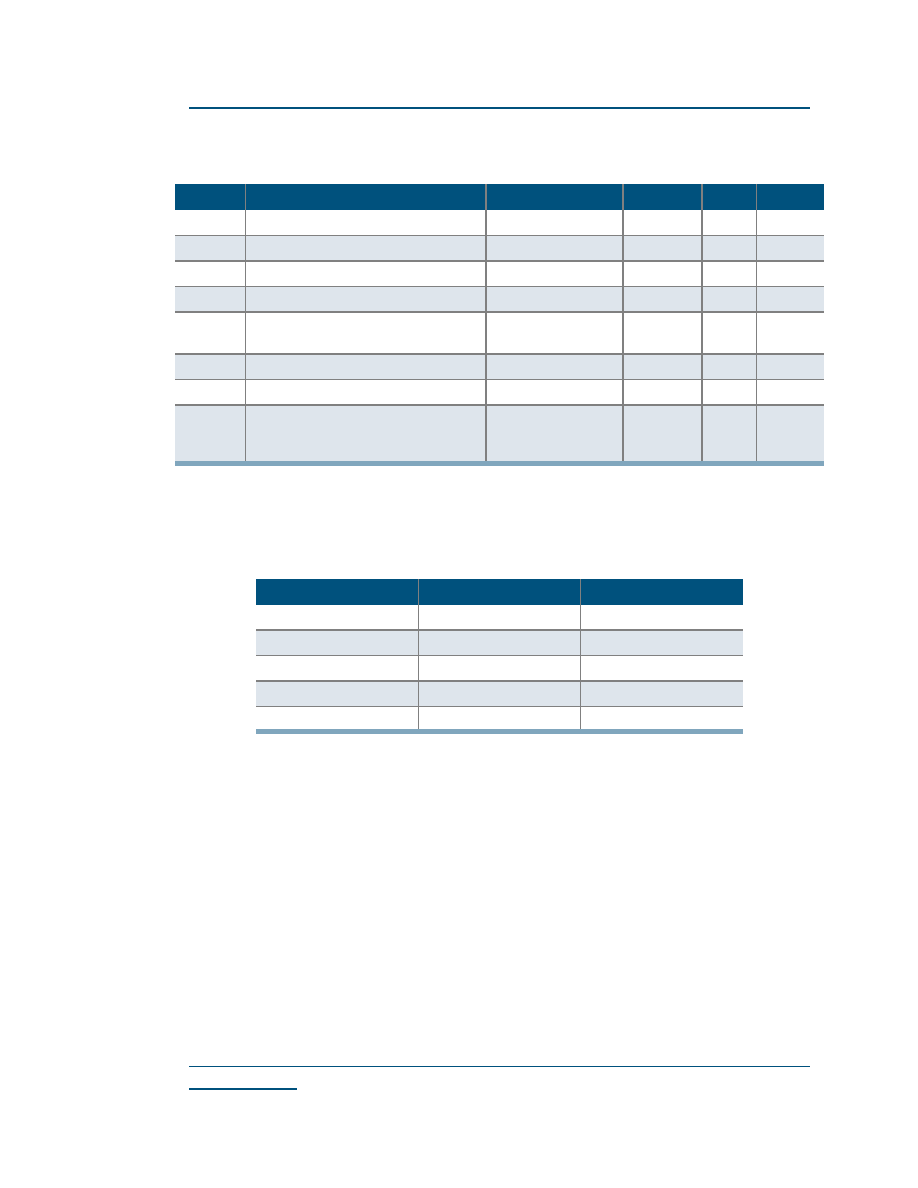
ZZZTXLFNORJLFFRP
4XLFN/RJLF &RUSRUDWLRQ
(FOLSVH,, )DPLO\ 'DWD 6KHHW 5HY %
Preliminary
7DEOH '& &KDUDFWHULVWLFV
6\PERO
3DUDPHWHU
&RQGLWLRQV
0LQ
0D[
8QLWV
I
I
I or I/O Input Leakage Current
V
I
= V
CCIO
or GND
-10
10
µA
I
OZ
3-State Output Leakage Current
V
I
= V
CCIO
or GND
-
10
µA
C
I
I/O Input Capacitance
a
D &DSDFLWDQFH LV VDPSOH WHVWHG RQO\ &ORFN SLQV DUH S) PD[LPXP
-
-
8
pF
C
CLOCK
Clock Input Capacitance
-
-
8
pF
I
OS
Output Short Circuit Current
b
b. Only one output at a time. Duration should not exceed 30 seconds.
V
o
= GND
V
o
= V
CC
-15
40
-180
210
mA
mA
I
ded
D.C. Supply Current on V
ded
-
-
-
mA
I
REF
D.C. Supply Current on INREF
-
-10
10
µA
I
PD
Current on programmable Pull-down
V
CCIO
= 3.6 V
V
CCIO
= 2.5 V
V
CCIO
= 1.8 V
-
150
µA
7DEOH ,FF &KDUDFWHULVWLFV
'HYLFH
9SXPS 9
9SXPS 9
QL8025
-
-
QL8050
-
-
QL8150
-
-
QL8250
a
a. For -7/-8 commercial grade devices only. Maximum I
CC
is 3 mA for all
industrial grade devices and 5 mA for all military devices.
2 mA
-
QL8325
a
2 mA
-
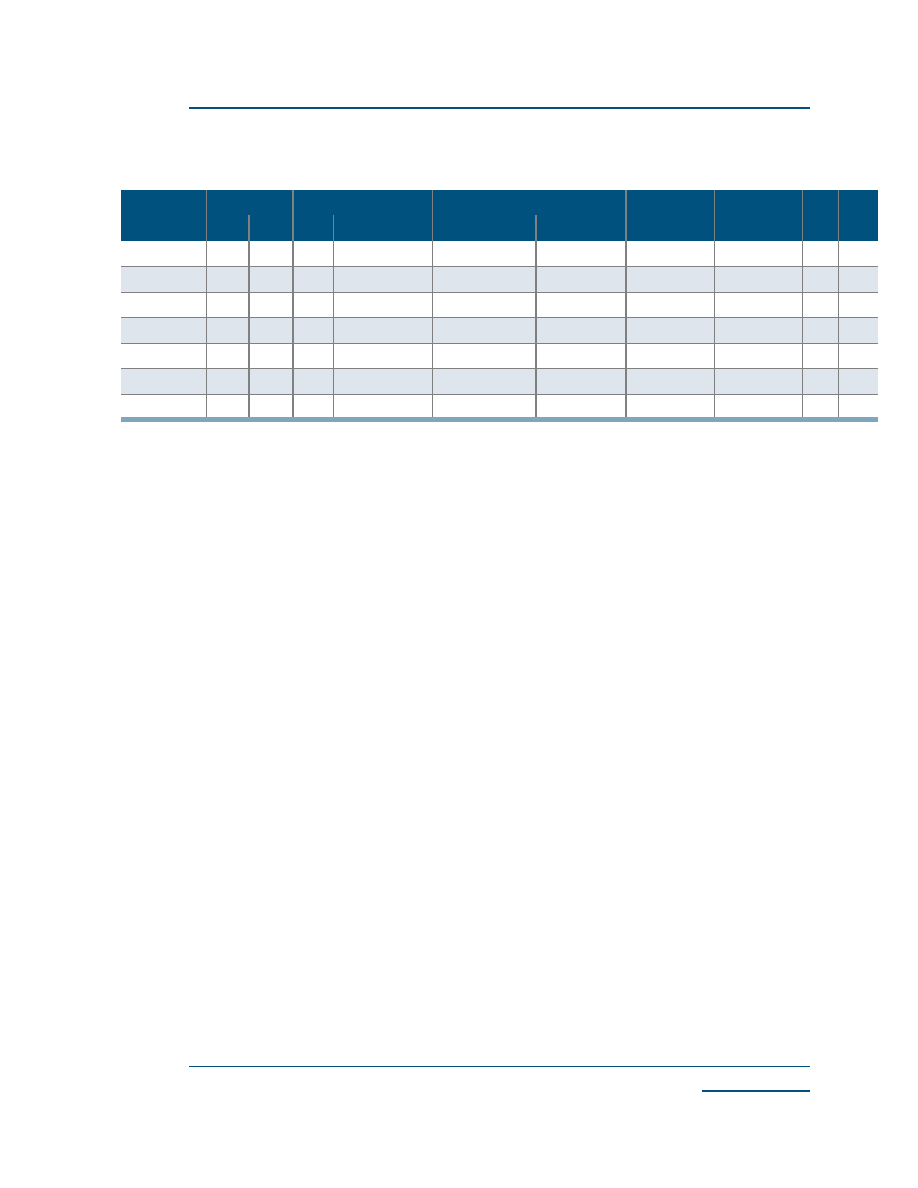
4XLFN/RJLF &RUSRUDWLRQ
ZZZTXLFNORJLFFRP
(FOLSVH,, )DPLO\ 'DWD 6KHHW 5HY %
Preliminary
7DEOH '& ,QSXW DQG 2XWSXW /HYHOV
D
a. The data provided in
7DEOH
and
7DEOH
are JEDEC and PCI Specifications.
QuickLogic devices either meet or exceed these requirements. For data specific to
QuickLogic I/Os, see preceding
7DEOH
through
7DEOH
,
)LJXUH
through
)LJXUH
, and
)LJXUH
through
)LJXUH
.
NOTE:
$OO &/. DQG ,2&75/ SLQV DUH FODPSHG WR WKH 9
GHG
UDLO 7KHUHIRUH WKHVH SLQV FDQ EH
GULYHQ XS WR 9
GHG
9
,15()
9
,/
9
,+
9
2/
9
2+
,
2/
,
2+
9
0,1
9
0$;
9
0,1
9
0$;
9
0,1
9
0$;
9
0$;
9
0,1
P$ P$
LVTTL
n/a
n/a
-0.3
0.8
2.2
V
CCIO
+ 0.3
0.4
2.4
2.0
-2.0
LVCMOS2
n/a
n/a
-0.3
0.7
1.7
V
CCIO
+ 0.3
0.7
1.7
2.0
-2.0
LVCMOS18
n/a
n/a
-0.3
0.63
1.2
V
CCIO
+ 0.3
0.7
1.7
2.0
-2.0
GTL+
0.88
1.12
-0.3
INREF
- 0.2
INREF
+ 0.2
V
CCIO
+ 0.3
0.6
n/a
40
n/a
PCI
n/a
n/a
-0.3
0.3 x V
CCIO
0.5 x V
CCIO
V
CCIO
+ 0.5
0.1 x V
CCIO
0.9 x V
CCIO
1.5
-0.5
SSTL2
1.15
1.35
-0.3
INREF
- 0.18
INREF
+ 0.18
V
CCIO
+ 0.3
0.74
1.76
7.6
-7.6
SSTL3
1.3
1.7
-0.3
INREF
- 0.2
INREF
+ 0.2
V
CCIO
+ 0.3
1.10
1.90
8
-8
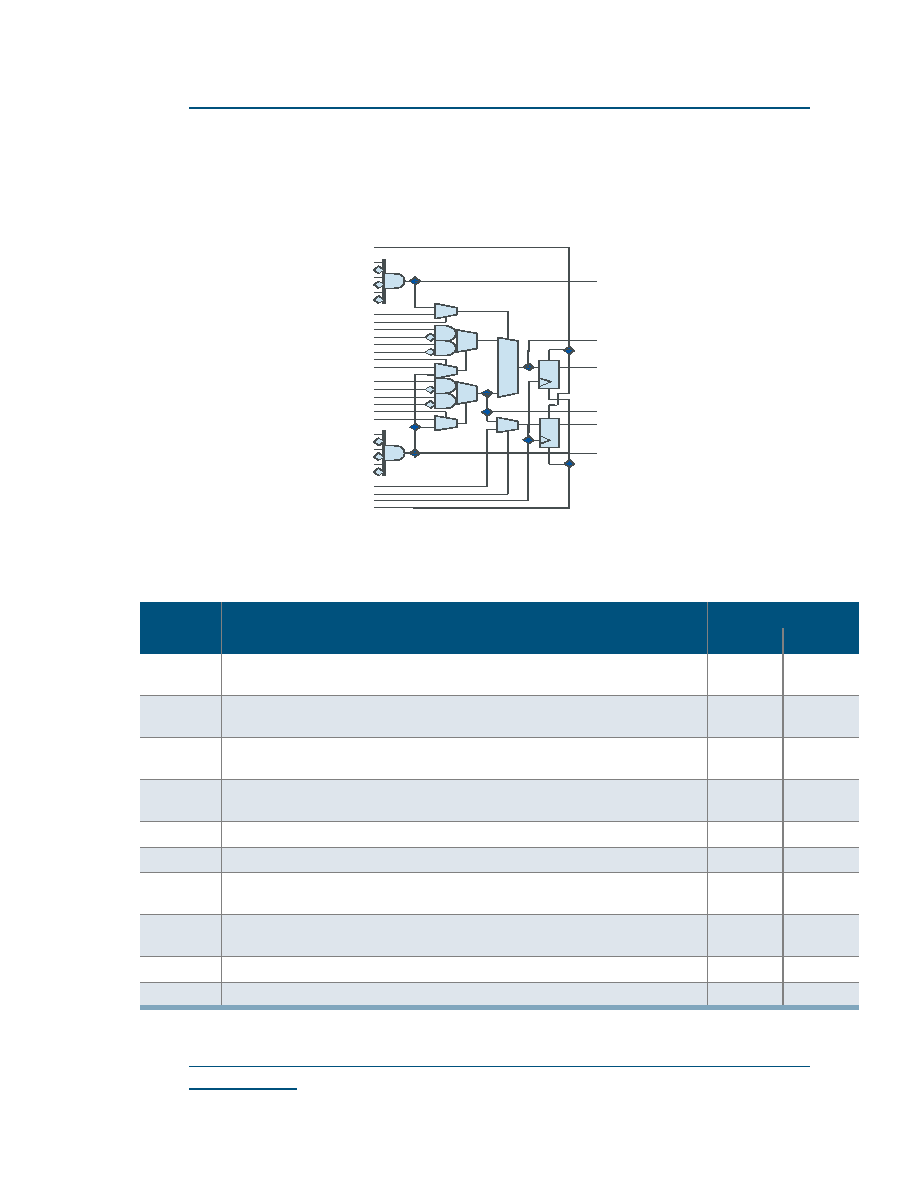
ZZZTXLFNORJLFFRP
4XLFN/RJLF &RUSRUDWLRQ
(FOLSVH,, )DPLO\ 'DWD 6KHHW 5HY %
Preliminary
$& &KDUDFWHULVWLFV
The AC Specifications (at V
CC
= 1.8 V, TA = 25∞ C, Worst Case Corner,
Speed Grade = -7 (K = 1.16)) are provided from
7DEOH
to
7DEOH
. Logic Cell diagrams and
waveforms are provided from
)LJXUH
to
)LJXUH
.
)LJXUH (FOLSVH,,
Logic Cell
7DEOH /RJLF &HOOV
6\PERO
3DUDPHWHU
9DOXH
/RJLF &HOOV
0LQ
0D[
t
PD
Combinatorial Delay of the longest path: time taken by the combinatorial circuit to
output
-
0.257 ns
t
SU
Setup time: time the synchronous input of the flip-flop must be stable before the
active clock edge
0.22 ns
-
t
HL
Hold time: time the synchronous input of the flip-flop must be stable after the active
clock edge
0 ns
-
t
CO
Clock-to-out delay: the amount of time taken by the flip-flop to output after the
active clock edge.
-
0.255 ns
t
CWHI
Clock High Time: required minimum time the clock stays high
0.46 ns
-
t
CWLO
Clock Low Time: required minimum time that the clock stays low
0.46 ns
-
t
SET
Set Delay: time between when the flip-flop is "set" (high)
and when the output is consequently "set" (high)
-
0.18 ns
t
RESET
Reset Delay: time between when the flip-flop is "reset" (low) and when the output
is consequently "reset" (low)
-
0.09 ns
t
SW
Set Width: time that the SET signal must remain high/low
0.3 ns
-
t
RW
Reset Width: time that the RESET signal must remain high/low
0.3 ns
-
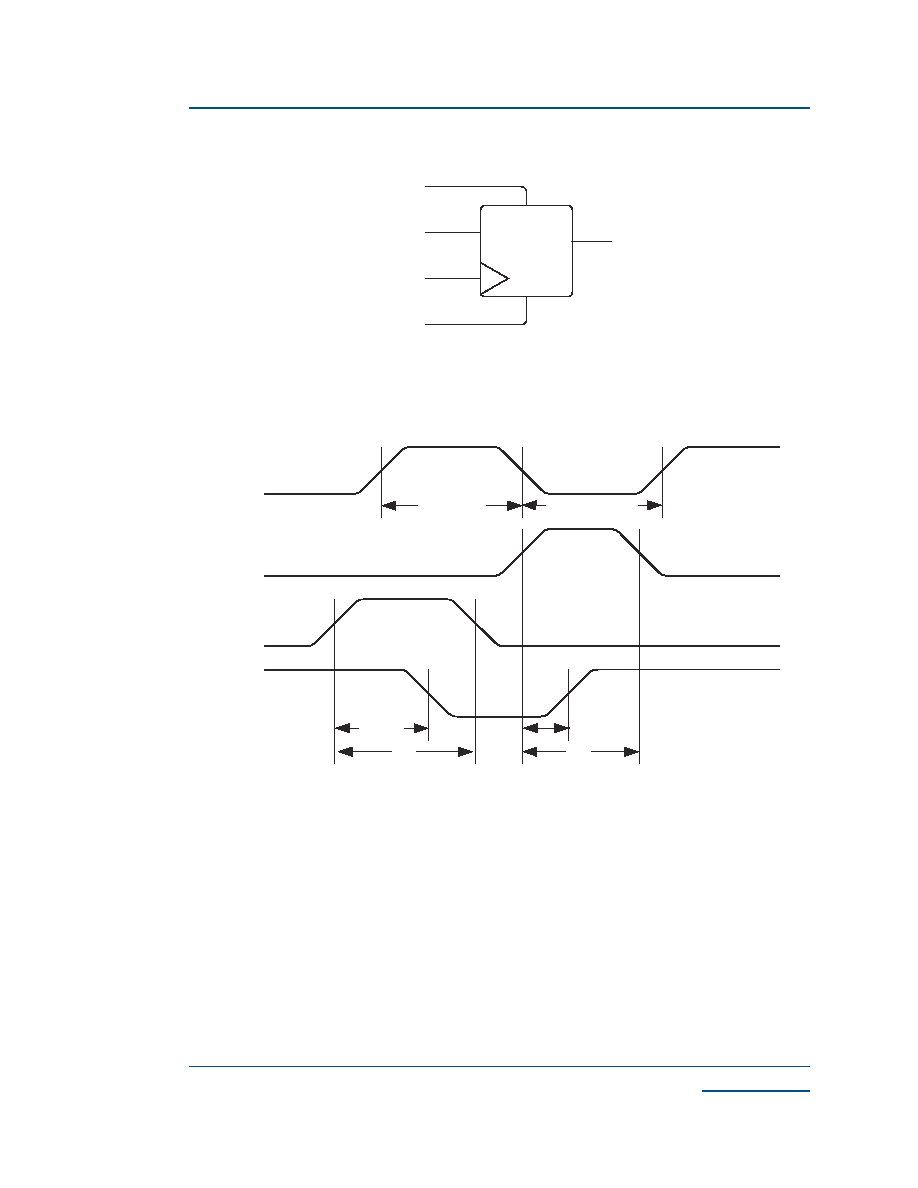
4XLFN/RJLF &RUSRUDWLRQ
ZZZTXLFNORJLFFRP
(FOLSVH,, )DPLO\ 'DWD 6KHHW 5HY %
Preliminary
)LJXUH /RJLF &HOO )OLSIORS
)LJXUH /RJLF &HOO )OLS)ORS 7LPLQJV≤)LUVW :DYHIRUP
SET
D
CLK
RESET
Q
SET
RESET
Q
CLK
tCWHI (min)
tCWLO (min)
tRESET
tRW
tSET
tSW
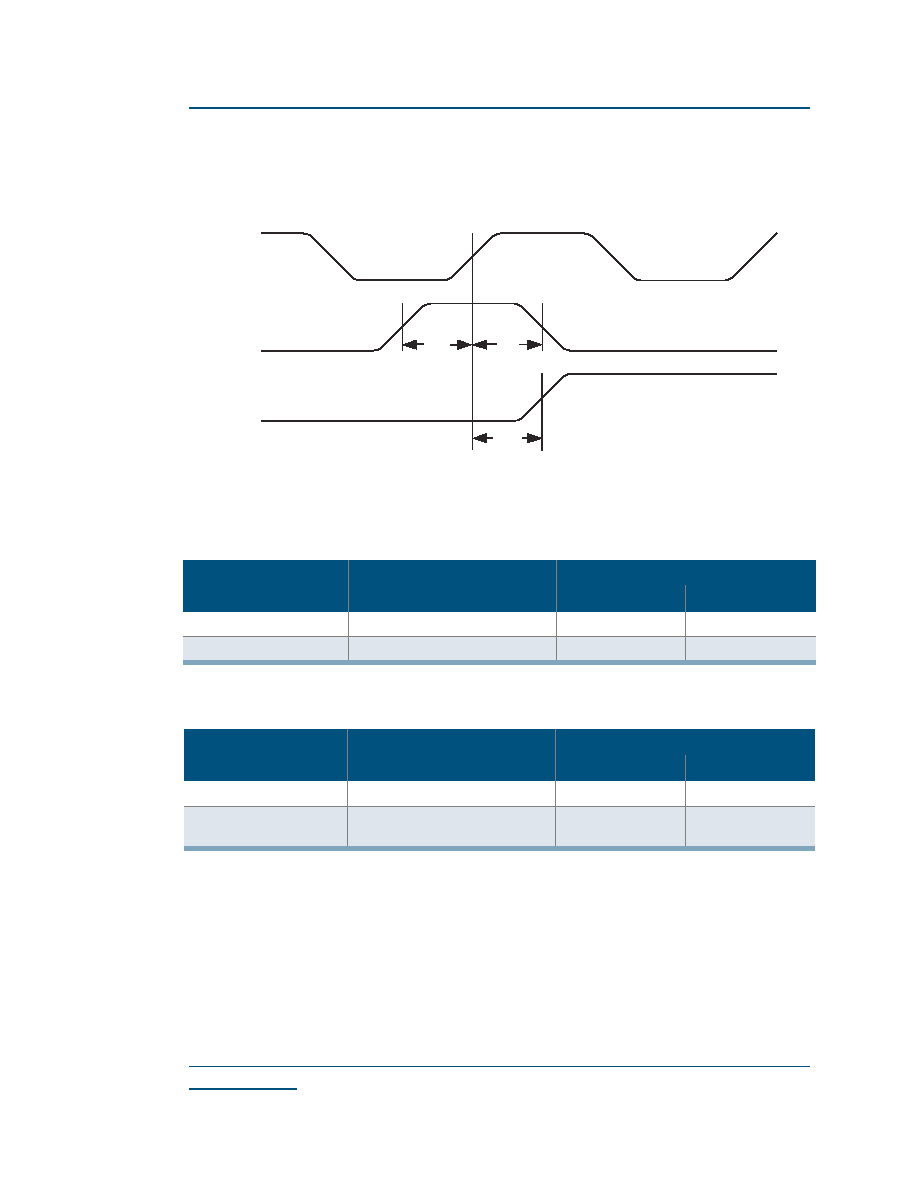
ZZZTXLFNORJLFFRP
4XLFN/RJLF &RUSRUDWLRQ
(FOLSVH,, )DPLO\ 'DWD 6KHHW 5HY %
Preliminary
)LJXUH /RJLF &HOO )OLS)ORS 7LPLQJV≤6HFRQG :DYHIRUP
NOTE:
:KHQ XVLQJ D 3// W
3*&.
DQG W
%*&.
DUH HIIHFWLYHO\ ]HUR GXH WR GHOD\ DGMXVWPHQW E\
3KDVH /RFNHG /RRS
7DEOH (FOLSVH,, &ORFN 'HOD\
&ORFN 6RXUFH
3DUDPHWHUV
&ORFN 3HUIRUPDQFH
*OREDO
'HGLFDWHG
Logic Cells (Internal)
Clock signal generated internally
1.51 ns (max)
-
Clock Pad
Clock signal generated externally
2.06 ns (max)
1.73 ns
7DEOH (FOLSVH,, *OREDO &ORFN 'HOD\
&ORFN 6HJPHQW
3DUDPHWHU
9DOXH
0LQ
0D[
t
PGCK
Global clock pin delay to quad net
-
1.34 ns
t
BGCK
Global clock tree delay
(quad net to flip-flop)
-
0.56 ns
CLK
D
Q
tSU
tHL
tCO
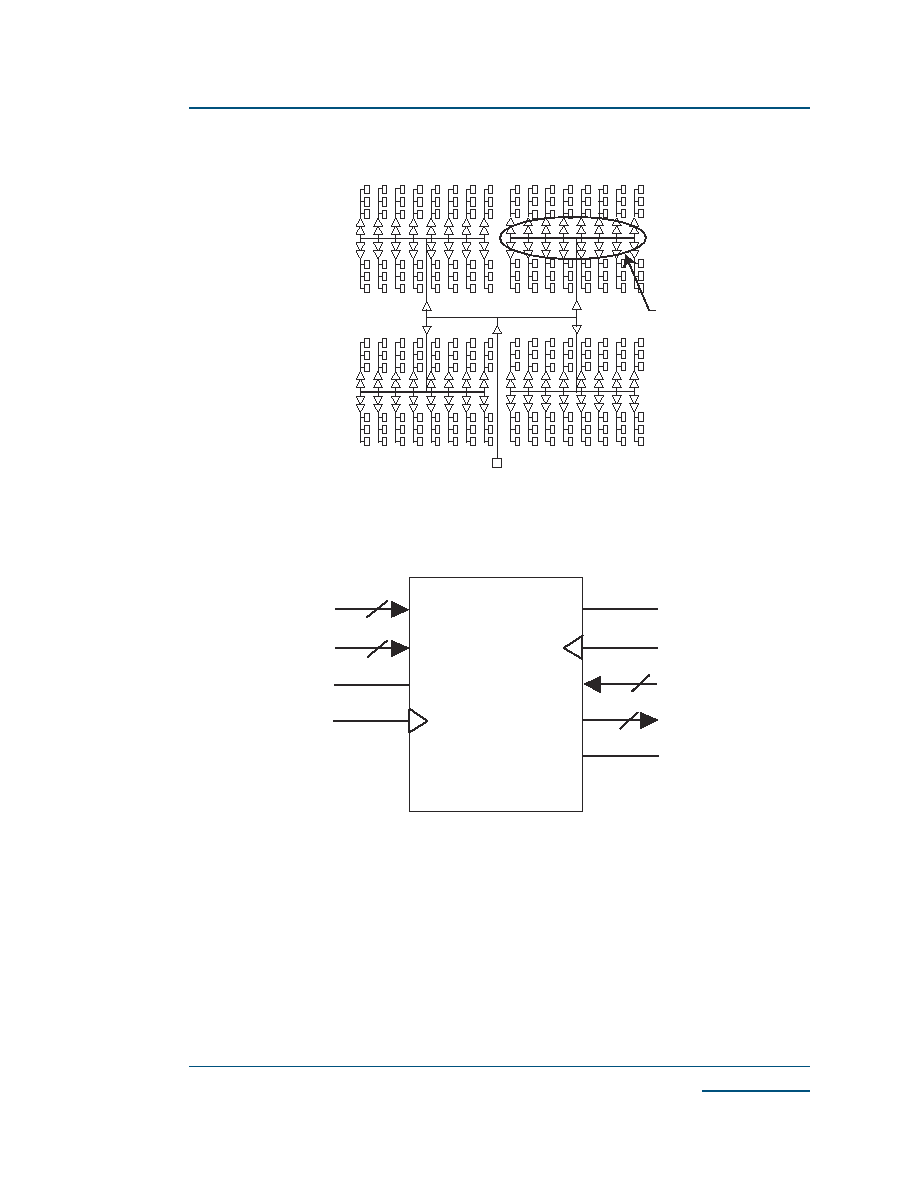
4XLFN/RJLF &RUSRUDWLRQ
ZZZTXLFNORJLFFRP
(FOLSVH,, )DPLO\ 'DWD 6KHHW 5HY %
Preliminary
)LJXUH *OREDO &ORFN 6WUXFWXUH 6FKHPDWLF
)LJXUH 5$0 0RGXOH
Quad net
WA
WD
WE
WC LK
R E
R C LK
R A
R D
R AM Module
[9:0]
[17:0]
[9:0]
[17:0]
AS Y NC R D
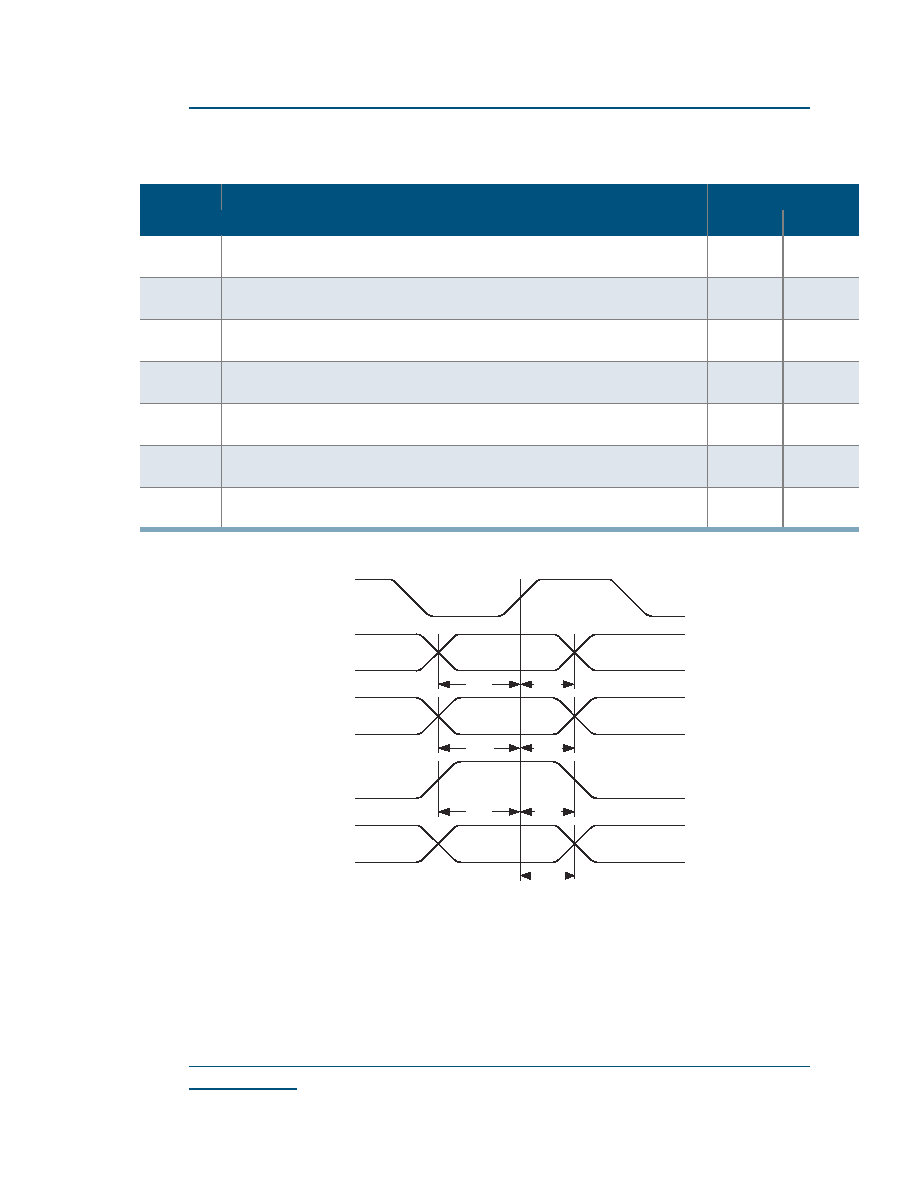
ZZZTXLFNORJLFFRP
4XLFN/RJLF &RUSRUDWLRQ
(FOLSVH,, )DPLO\ 'DWD 6KHHW 5HY %
Preliminary
)LJXUH 5$0 &HOO 6\QFKURQRXV :ULWH 7LPLQJ
7DEOH 5$0 &HOO 6\QFKURQRXV :ULWH 7LPLQJ
6\PERO
3DUDPHWHU
9DOXH
5$0 &HOO 6\QFKURQRXV :ULWH 7LPLQJ
0LQ
0D[
t
SWA
WA setup time to WCLK: time the WRITE ADDRESS must be stable before the
active edge of the WRITE CLOCK
0.675 ns
-
t
HWA
WA hold time to WCLK: time the WRITE ADDRESS must be stable after the active
edge of the WRITE CLOCK
0 ns
-
t
SWD
WD setup time to WCLK: time the WRITE DATA must be stable before the active
edge of the WRITE CLOCK
0.654 ns
-
t
HWD
WD hold time to WCLK: time the WRITE DATA must be stable after the active edge
of the WRITE CLOCK
0 ns
-
t
SWE
WE setup time to WCLK: time the WRITE ENABLE must be stable before the active
edge of the WRITE CLOCK
0.623 ns
-
t
HWE
WE hold time to WCLK: time the WRITE ENABLE must be stable after the active
edge of the WRITE CLOCK
0 ns
-
t
WCRD
WCLK to RD (WA = RA): time between the active WRITE CLOCK edge and the
time when the data is available at RD
-
4.38 ns
tSWA
tSWD
tSWE
tHWA
tHWD
tHWE
tWCRD
old data
new data
WCLK
WA
WD
WE
RD
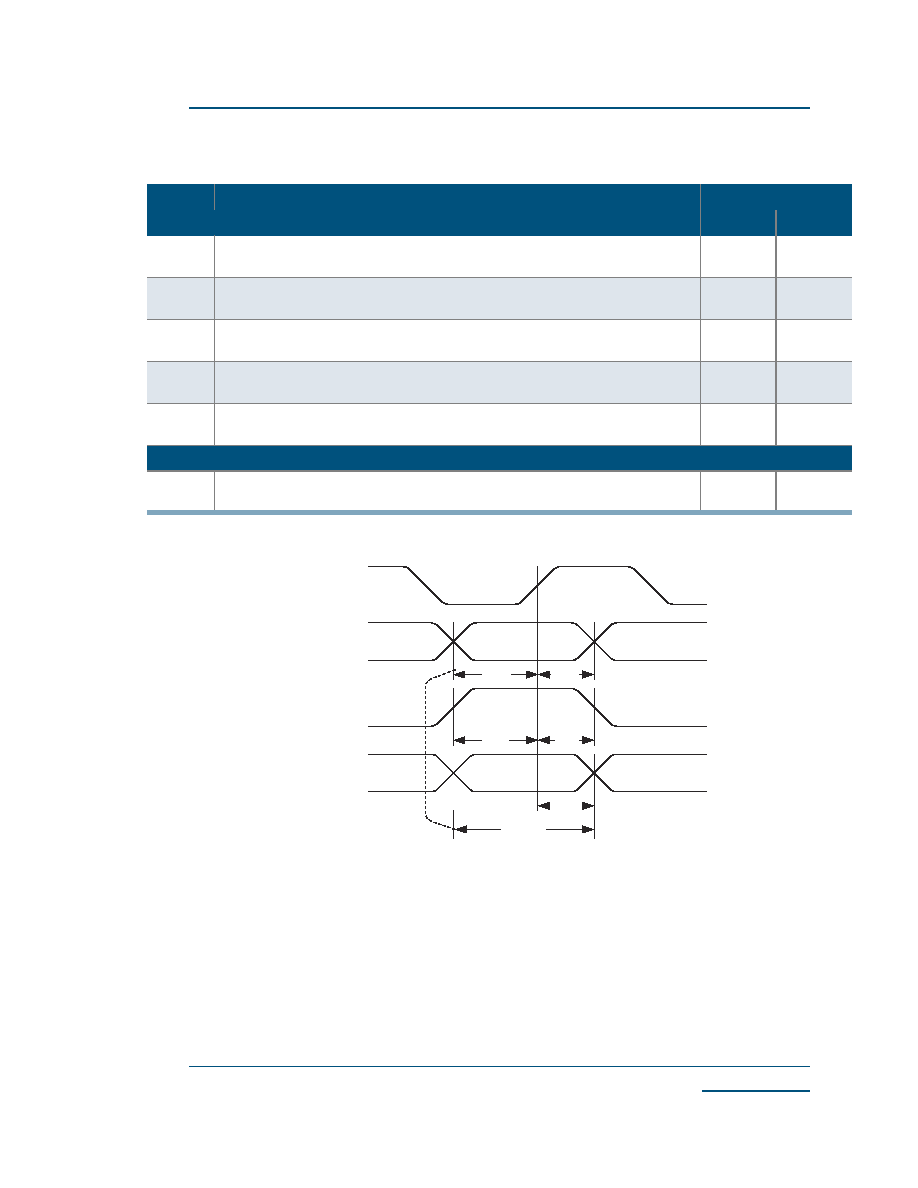
4XLFN/RJLF &RUSRUDWLRQ
ZZZTXLFNORJLFFRP
(FOLSVH,, )DPLO\ 'DWD 6KHHW 5HY %
Preliminary
)LJXUH 5$0 &HOO 6\QFKURQRXV DQG $V\QFKURQRXV 5HDG 7LPLQJ
7DEOH 5$0 &HOO 6\QFKURQRXV DQG $V\QFKURQRXV 5HDG 7LPLQJ
6\PERO
3DUDPHWHU
9DOXH
5$0 &HOO 6\QFKURQRXV 5HDG 7LPLQJ
0LQ
0D[
t
SRA
RA setup time to RCLK: time the READ ADDRESS must be stable before the active
edge of the READ CLOCK
0.686 ns
-
t
HRA
RA hold time to RCLK: time the READ ADDRESS must be stable after the active
edge of the READ CLOCK
0 ns
-
t
SRE
RE setup time to WCLK: time the READ ENABLE must be stable before the active
edge of the READ CLOCK
0.243 ns
-
t
HRE
RE hold time to WCLK: time the READ ENABLE must be stable after the active
edge of the READ CLOCK
0 ns
-
t
RCRD
RCLK to RD: time between the active READ CLOCK edge and the time when the
data is available at RD
-
4.38 ns
5$0 &HOO $V\QFKURQRXV 5HDG 7LPLQJ
r
PDRD
RA to RD: time between when the READ ADDRESS is input and when the DATA
is output
-
2.06 ns
tSRA
tHRA
RCLK
RA
tSRE
tHRE
tRCRD
old data
new data
RE
RD
rPDRD
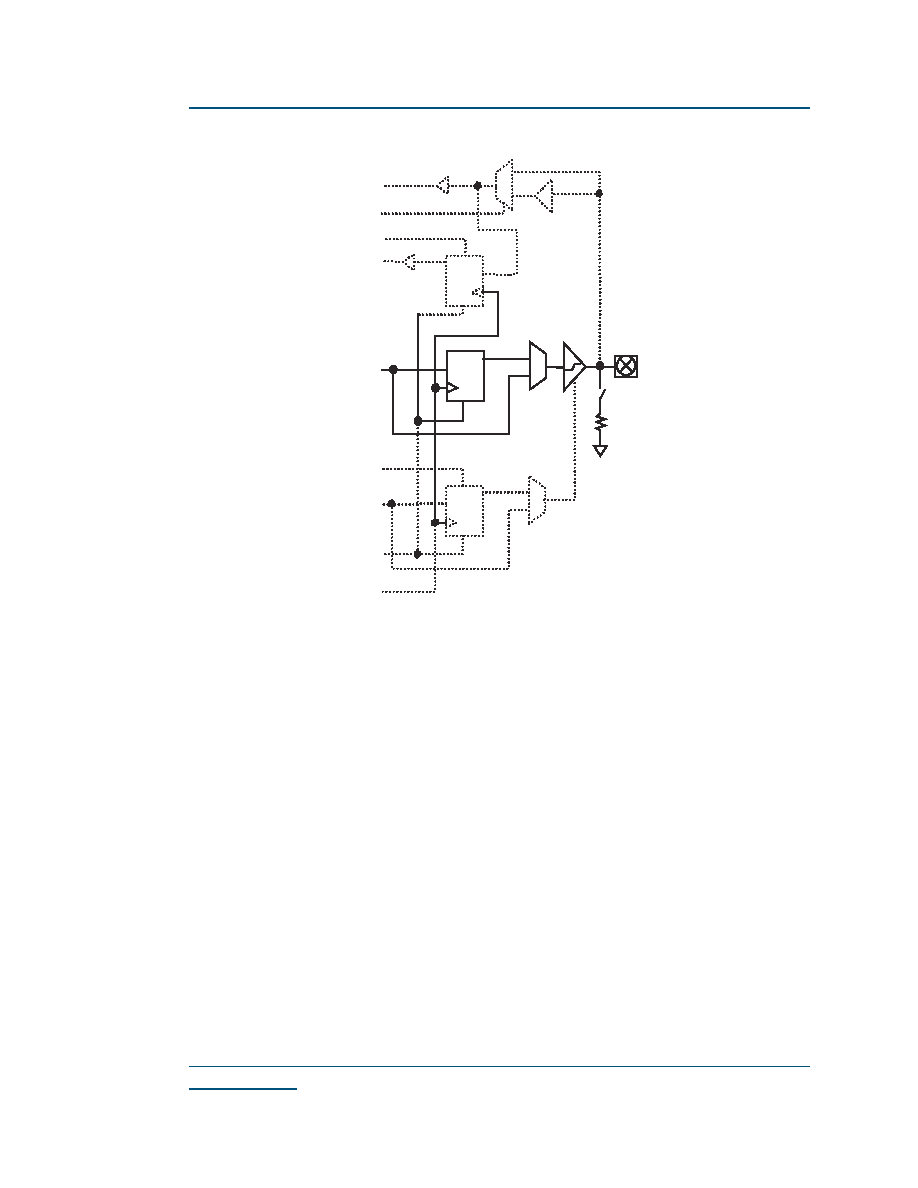
ZZZTXLFNORJLFFRP
4XLFN/RJLF &RUSRUDWLRQ
(FOLSVH,, )DPLO\ 'DWD 6KHHW 5HY %
Preliminary
)LJXUH (FOLSVH,, &HOO ,2
+
-
PAD
OUTPUT
REGISTER
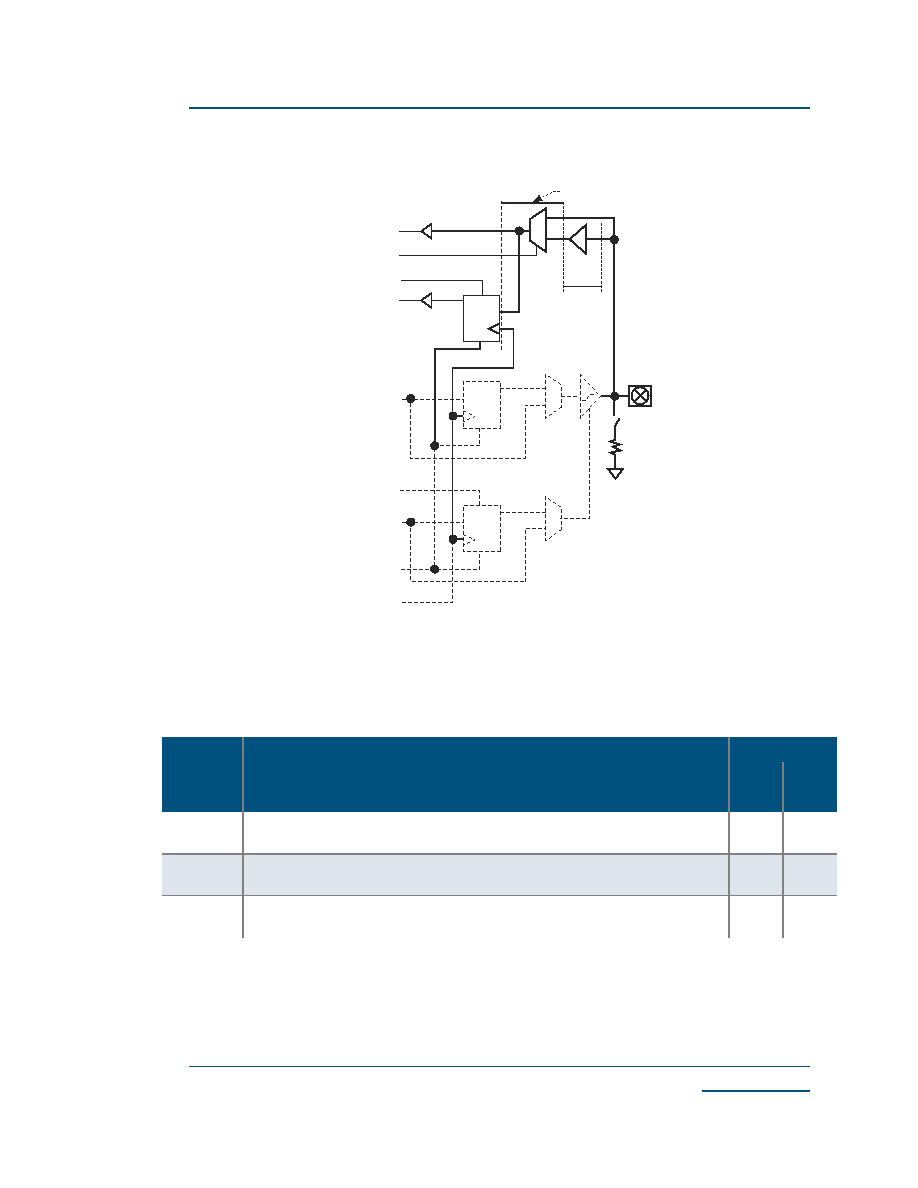
4XLFN/RJLF &RUSRUDWLRQ
ZZZTXLFNORJLFFRP
(FOLSVH,, )DPLO\ 'DWD 6KHHW 5HY %
Preliminary
)LJXUH (FOLSVH,,
,QSXW 5HJLVWHU &HOO
7DEOH ,QSXW 5HJLVWHU &HOO
6\PERO
,QSXW
5HJLVWHU
&HOO 2QO\�
3DUDPHWHU
9DOXH
0LQ
0D[
t
ISU
Input register setup time: time the synchronous input of the flip-flop must be stable
before the active clock edge
2.50 ns
-
t
IHL
Input register hold time: time the synchronous input of the flip-flop must be stable
after the active clock edge
-
0 ns
t
ICO
Input register clock-to-out: time taken by the flip-flop to output after the active clock
edge
-
1.08 ns
PAD
t
ISU
t
SID
+
-
Q E
D
R
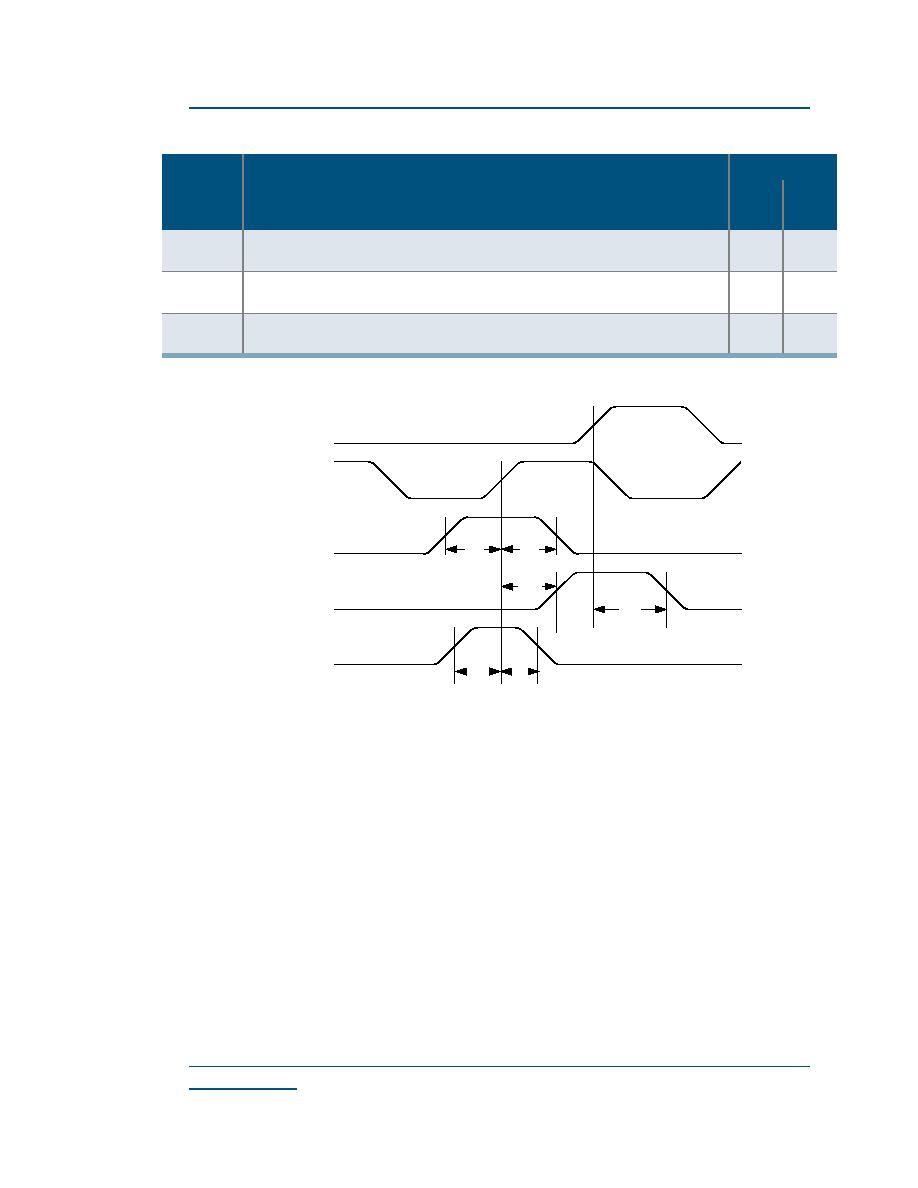
ZZZTXLFNORJLFFRP
4XLFN/RJLF &RUSRUDWLRQ
(FOLSVH,, )DPLO\ 'DWD 6KHHW 5HY %
Preliminary
)LJXUH (FOLSVH,,
,QSXW 5HJLVWHU &HOO 7LPLQJ
t
IRST
Input register reset delay: time between when the flip-flop is "reset"(low) and when
the output is consequently "reset" (low)
-
0.99 ns
t
IESU
Input register clock enable setup time: time "enable" must be stable before the
active clock edge
0.37 ns
-
t
IEH
Input register clock enable hold time: time "enable" must be stable after the active
clock edge
0 ns
-
7DEOH ,QSXW 5HJLVWHU &HOO
6\PERO
,QSXW
5HJLVWHU
&HOO 2QO\�
3DUDPHWHU
9DOXH
0LQ
0D[
R
C L K
D
Q
tISU
tIH L
tIC O
tIE SU
tIE H
tIR ST
E
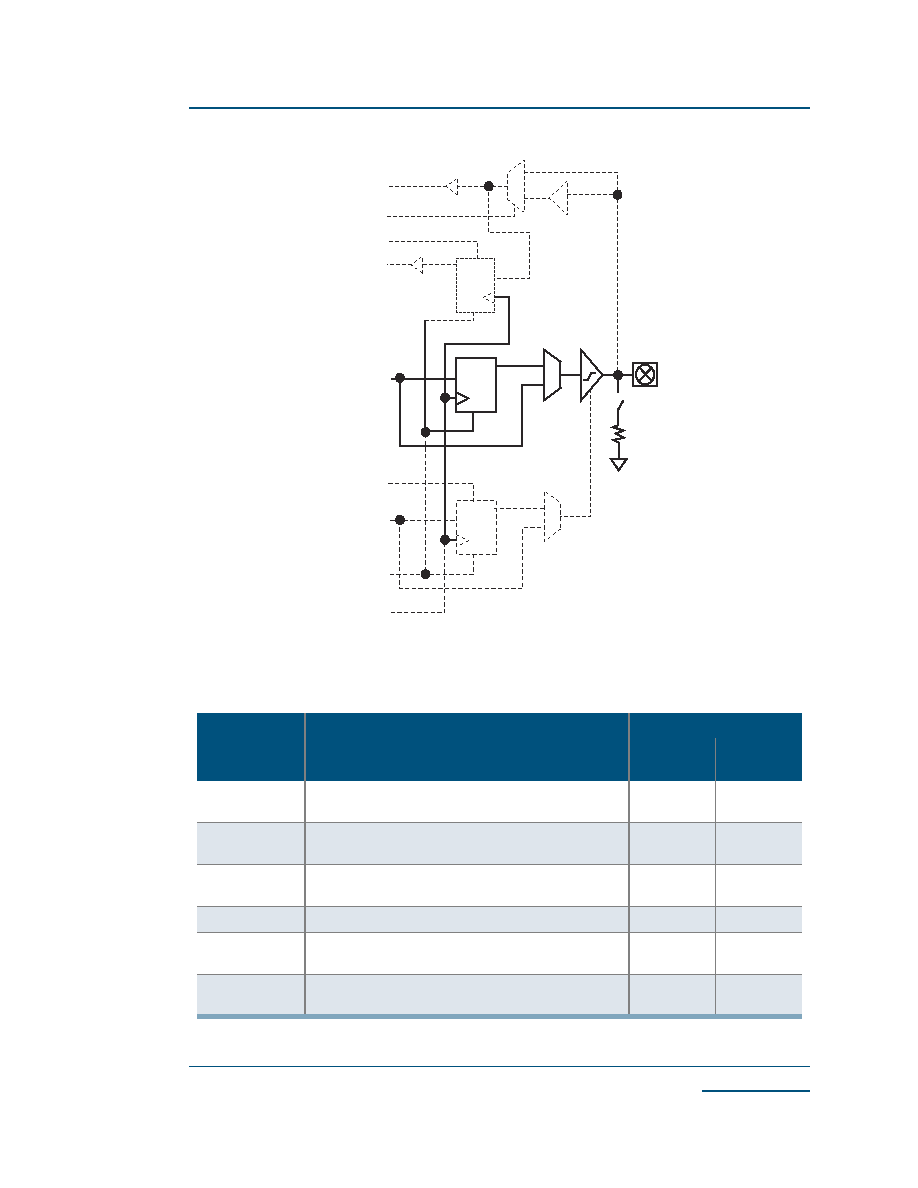
4XLFN/RJLF &RUSRUDWLRQ
ZZZTXLFNORJLFFRP
(FOLSVH,, )DPLO\ 'DWD 6KHHW 5HY %
Preliminary
)LJXUH (FOLSVH,,
2XWSXW 5HJLVWHU &HOO
7DEOH 6WDQGDUG ,QSXW 'HOD\V
6\PERO
3DUDPHWHU
9DOXH
6WDQGDUG ,QSXW
'HOD\V
7R JHW WKH WRWDO LQSXW GHOD\ DGG WKLV GHOD\ WR W
,68
0LQ
0D[
t
SID
(LVTTL)
LVTTL input delay: Low Voltage TTL for 3.3 V
applications
-
0.34 ns
t
SID
(LVCMOS2)
LVCMOS2 input delay: Low Voltage CMOS for 2.5 V
and lower applications
-
0.42 ns
t
SID
(LVCMOS18)
LVCMOS18 input delay: Low Voltage CMOS for 1.8
V applications
-
-
t
SID
(GTL+)
GTL+ input delay: Gunning Transceiver Logic
-
0.68 ns
t
SID
(SSTL3)
SSTL3 input delay: Stub Series Terminated Logic for
3.3 V
-
0.55 ns
t
SID
(SSTL2)
SSTL2 input delay: Stub Series Terminated Logic for
2.5 V
-
0.61 ns
PAD
OUTPUT
REGISTER
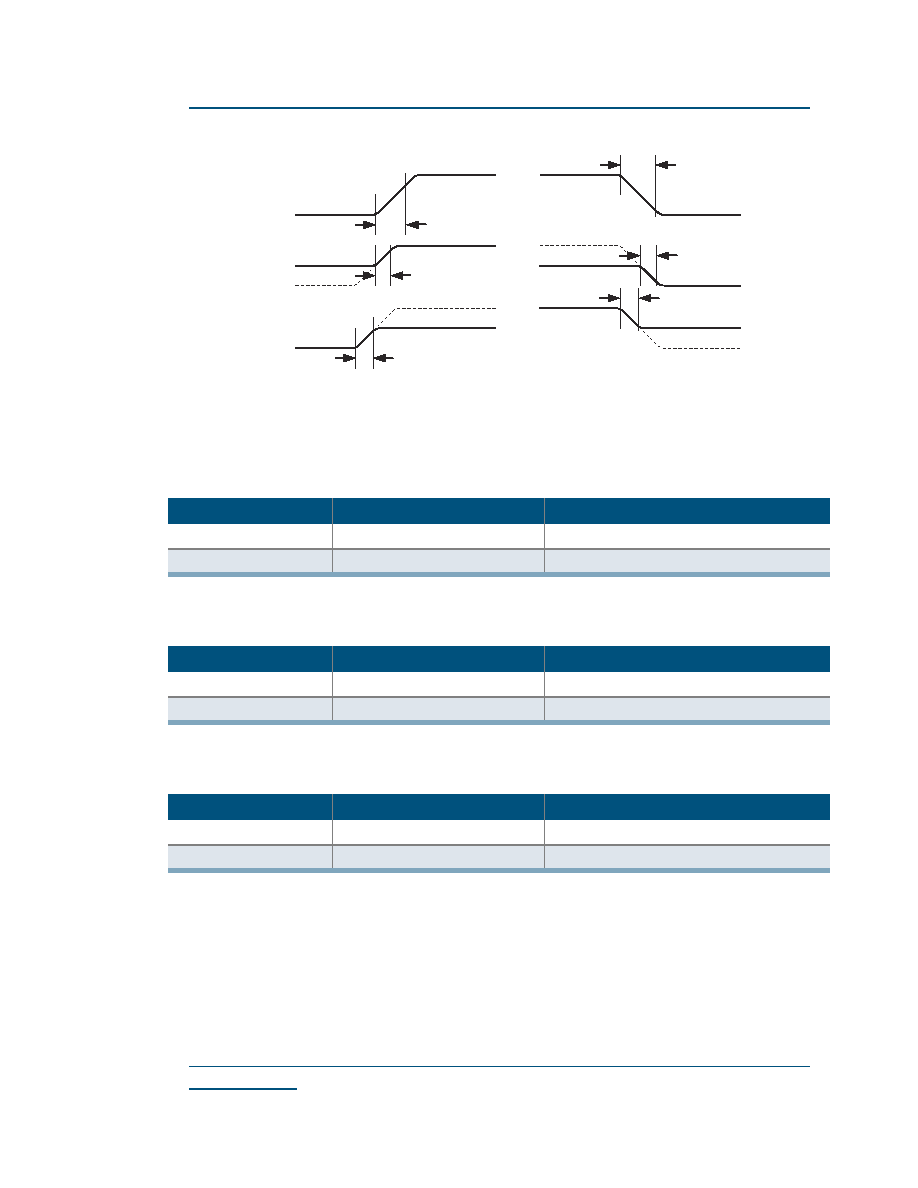
ZZZTXLFNORJLFFRP
4XLFN/RJLF &RUSRUDWLRQ
(FOLSVH,, )DPLO\ 'DWD 6KHHW 5HY %
Preliminary
)LJXUH (FOLSVH,,
2XWSXW 5HJLVWHU &HOO 7LPLQJ
7DEOH 2XWSXW 6OHZ 5DWHV # 9
&&,2
9 7
∞
&
)DVW 6OHZ
6ORZ 6OHZ
Rising Edge
2.8 V/ns
1.0 V/ns
Falling Edge
2.86 V/ns
1.0 V/ns
7DEOH 2XWSXW 6OHZ 5DWHV # 9
&&,2
9 7
∞
&
)DVW 6OHZ
6ORZ 6OHZ
Rising Edge
1.7 V/ns
0.6 V/ns
Falling Edge
1.9 V/ns
0.6 V/ns
7DEOH 2XWSXW 6OHZ 5DWHV # 9
&&,2
9 7
∞
&
)DVW 6OHZ
6ORZ 6OHZ
Rising Edge
-
-
Falling Edge
-
-
L
H
L
H
tOUTLH
tOUTHL
L
H
Z
tPZH
L
H
Z
tPZL
L
H
Z
tPLZ
L
H
Z
tPHZ
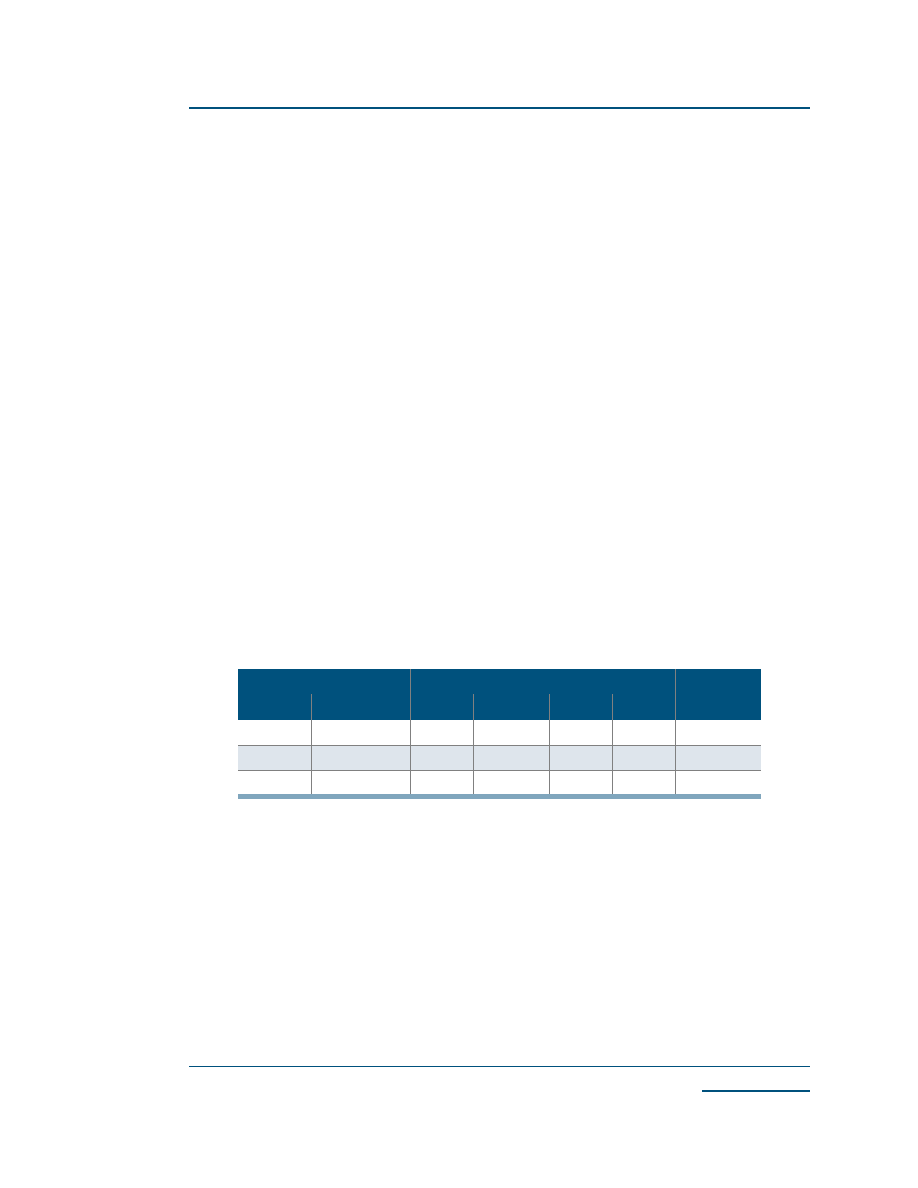
4XLFN/RJLF &RUSRUDWLRQ
ZZZTXLFNORJLFFRP
(FOLSVH,, )DPLO\ 'DWD 6KHHW 5HY %
Preliminary
3DFNDJH 7KHUPDO &KDUDFWHULVWLFV
Thermal Resistance Equations:
JC
= (T
J
- T
C
)/P
JA
= (TJ - TA)/P
P
MAX
= (T
JMAX
- T
AMAX
)/
JA
Parameter Description:
JC
: Junction-to-case thermal resistance
JA
: Junction-to-ambient thermal resistance
T
J
: Junction temperature
T
A
: Ambient temperature
P: Power dissipated by the device while operating
P
MAX
: The maximum power dissipation for the device
T
JMAX
: Maximum junction temperature
T
AMAX
: Maximum ambient temperature
NOTE:
0D[LPXP MXQFWLRQ WHPSHUDWXUH 7
-0$;
� LV & 7R FDOFXODWH WKH PD[LPXP SRZHU
GLVVLSDWLRQ IRU D GHYLFH SDFNDJH ORRN XS
-$
IURP 7DEOH SLFN DQ DSSURSULDWH 7
$0$;
DQG XVH
P
MAX
= (150∫ C - T
AMAX
)/
JA
7DEOH 3DFNDJH 7KHUPDO &KDUDFWHULVWLFV
3DFNDJH 'HVFULSWLRQ
JA
&:� # YDULRXV IORZ UDWHV PVHF�
JC
&:�
3LQ &RXQW 3DFNDJH 7\SH
484
PBGA
28.0
26.0
25.0
23.0
9.0
280
LF-PBGA
18.5
17.0
15.5
14.0
7.0
208
PQFP
26.0
24.5
23.0
22.0
11.0

ZZZTXLFNORJLFFRP
4XLFN/RJLF &RUSRUDWLRQ
(FOLSVH,, )DPLO\ 'DWD 6KHHW 5HY %
Preliminary
.Y DQG .W *UDSKV
)LJXUH 9ROWDJH )DFWRU YV 6XSSO\ 9ROWDJH
)LJXUH 7HPSHUDWXUH )DFWRU YV 2SHUDWLQJ 7HPSHUDWXUH
Voltage Factor vs. Supply Voltage
0.9200
0.9400
0.9600
0.9800
1.0000
1.0200
1.0400
1.0600
1.0800
1.1000
2.25
2.3
2.35
2.4
2.45
2.5
2.55
2.6
2.65
2.7
2.75
Supply Voltage (V)
Kv
Temperature Factor vs. Operating Temperature
0.85
0.90
0.95
1.00
1.05
1.10
1.15
-60
-40
-20
0
20
40
60
80
Junction Temperature C
Kt
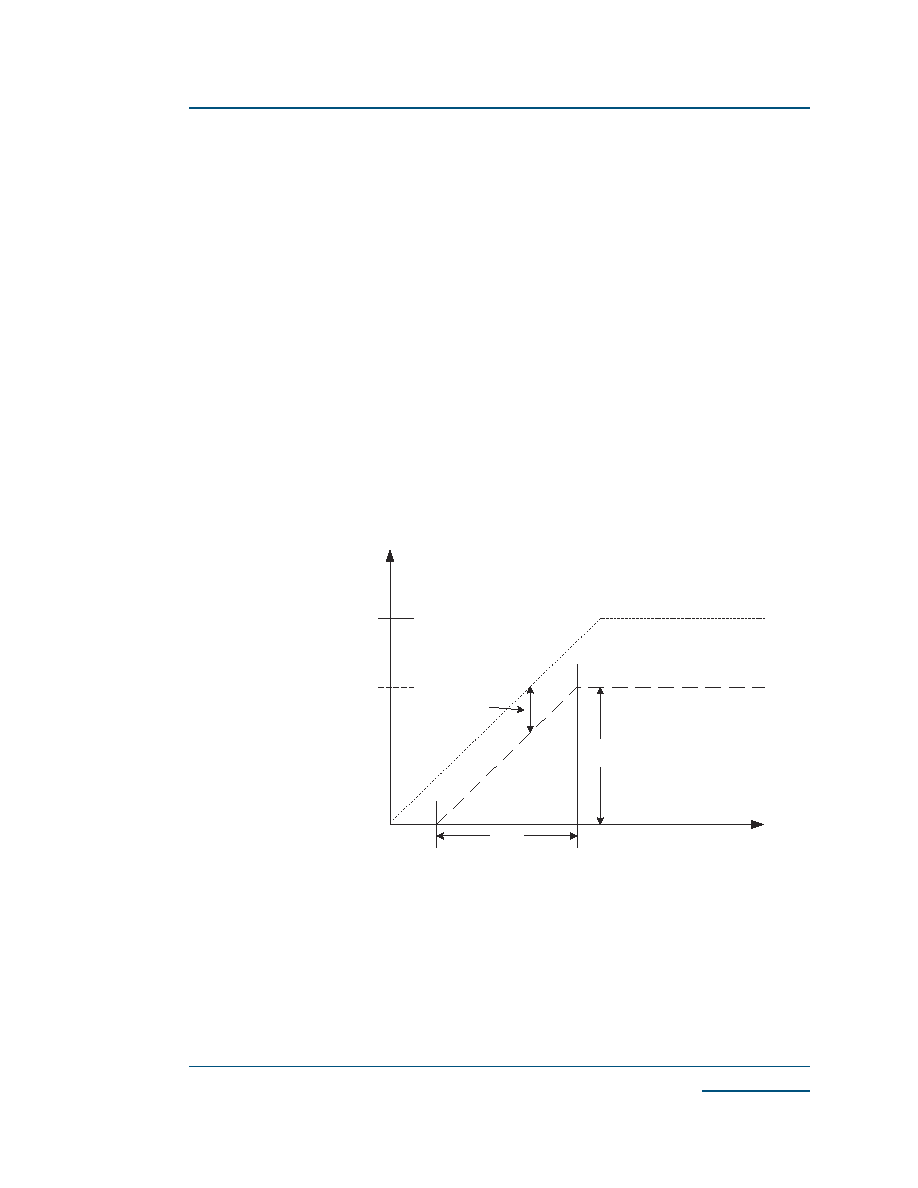
4XLFN/RJLF &RUSRUDWLRQ
ZZZTXLFNORJLFFRP
(FOLSVH,, )DPLO\ 'DWD 6KHHW 5HY %
Preliminary
3RZHU YV 2SHUDWLQJ )UHTXHQF\
The basic power equation which best models power consumption is given below:
P
TOTAL
= 0.350 + f[0.0031
LC
+ 0.0948
CKBF
+ 0.01
CLBF
+ 0.0263
CKLD
+
0.543
RAM
+ 0.20
PLL
+ 0.0035
INP
+ 0.0257
OUTP
] (mW)
Where
∑
LC
is the total number of logic cells in the design
∑
CKBF
= # of clock buffers
∑
CLBF
= # of column clock buffers
∑
CKLD
= # of loads connected to the column clock buffers
∑
RAM
= # of RAM blocks
∑
PLL
= # of PLLs
∑
INP
is the number of input pins
∑
OUTP
is the number of output pins
NOTE:
7R OHDUQ PRUH DERXW SRZHU FRQVXPSWLRQ SOHDVH UHIHU WR $SSOLFDWLRQ 1RWH
3RZHUXS 6HTXHQFLQJ
)LJXUH 3RZHUXS 6HTXHQFLQJ
The following requirements must be met when powering up a device (refer to
)LJXUH
):
∑
When ramping up the power supplies keep (V
CCIO
-V
CC
)
MAX
500 mV. Deviation from this
recommendation can cause permanent damage to the device.
∑
V
CCIO
must lead V
CC
when ramping the device.
∑
The power supply must be greater than or equal to 400 µs to reach V
CC
. Ramping to
V
CC
/V
CCIO
before reaching 400 µs can cause the device to behave improperly.
Vol
t
age
V
CCIO
V
CC
(V
CCIO
-V
CC
)
MAX
400 us
V
CC

ZZZTXLFNORJLFFRP
4XLFN/RJLF &RUSRUDWLRQ
(FOLSVH,, )DPLO\ 'DWD 6KHHW 5HY %
Preliminary
3LQ 'HVFULSWLRQV
)LJXUH ,2 %DQNV ZLWK 5HOHYDQW 3LQV
7DEOH -7$* 3LQ 'HVFULSWLRQV
3LQ
)XQFWLRQ
'HVFULSWLRQ
TDI/RSI
Test Data In for JTAG/RAM
init. Serial Data In
Hold HIGH during normal operation. Connects to serial PROM
data in for RAM initialization. Connect to V
CC
if unused
TRSTB/RRO
Active low Reset for
JTAG/RAM init. reset out
Hold LOW during normal operation. Connects to serial PROM
reset for RAM initialization. Connect to GND if unused
TMS
Test Mode Select for JTAG
Hold HIGH during normal operation. Connect to V
CC
if not used
for JTAG
TCK
Test Clock for JTAG
Hold HIGH or LOW during normal operation. Connect to V
CC
or
ground if not used for JTAG
TDO/RCO
Test data out for JTAG/RAM
init. clock out
Connect to serial PROM clock for RAM initialization. Must be left
unconnected if not used for JTAG or RAM initialization
IO BANK A
IO BANK B
V CCI
O
(A
)
IN
R
E
F(
A)
IO
C
T
R
L
(
A
)
IO
(
A
)
V CCI
O
(A
)
IN
R
E
F(
A)
IO
C
T
R
L
(
A
)
IO
(
A
)
IO
BAN
K C
IO
BAN
K D
VCCIO (C)
INREF(C)
IOCTRL(C)
IO(C)
VCCIO(D)
INREF(D)
IOCTRL(D)
IO(D)
IO BANK F
IO BANK E
VCCI
O
(F
)
I
N
R
E
F(
F)
I
O
CT
RL(F
)
IO
(
F
)
VCCI
O
(E
)
IN
R
E
F
(
E)
I
O
CT
RL(E
)
IO
(
E
)
IO
BAN
K H
IO
BAN
K G
(H)
INREF(H)
IOCTRL(H)
IO(H)
VCCIO
VCCIO
(G)
INREF(G)
IOCTRL(G)
IO(G)
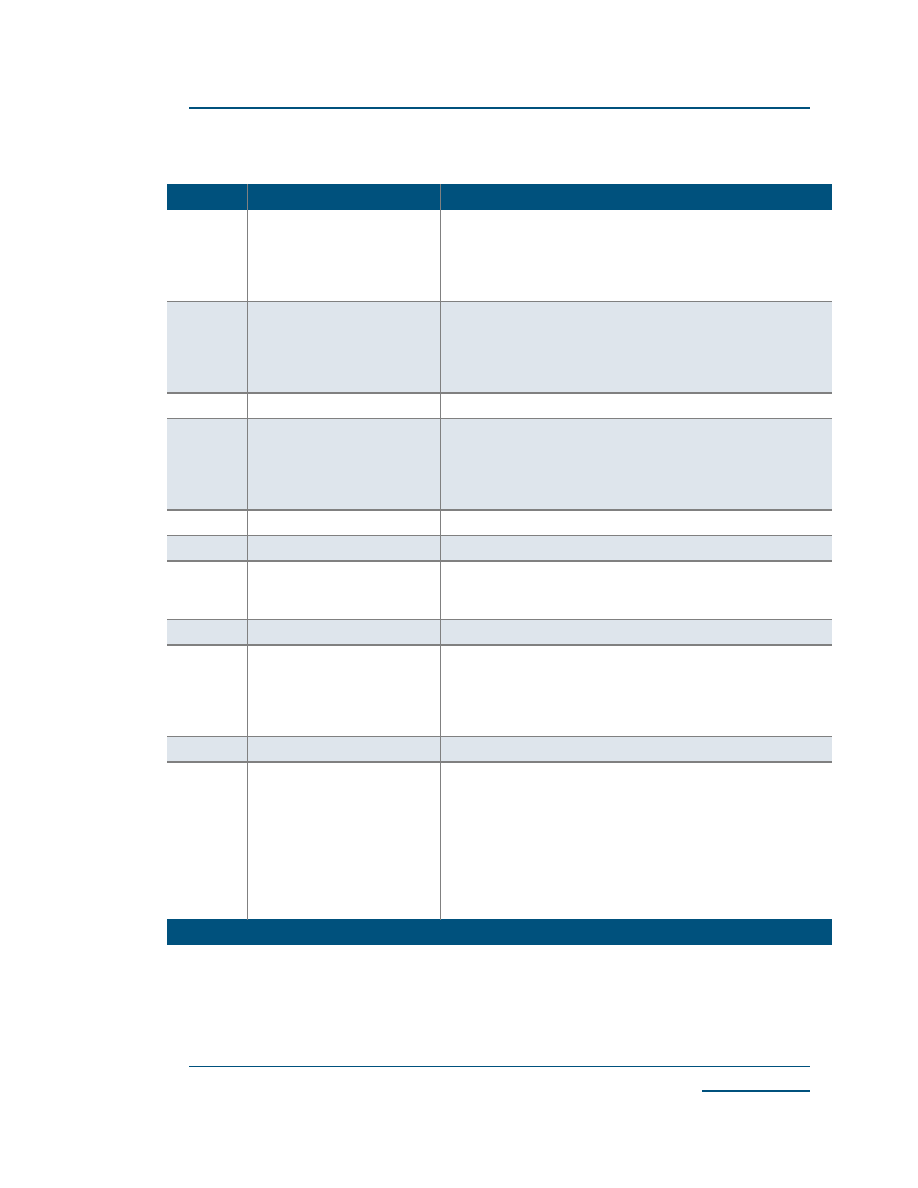
4XLFN/RJLF &RUSRUDWLRQ
ZZZTXLFNORJLFFRP
(FOLSVH,, )DPLO\ 'DWD 6KHHW 5HY %
Preliminary
7DEOH 'HGLFDWHG 3LQ 'HVFULSWLRQV
3LQ
)XQFWLRQ
'HVFULSWLRQ
GCLK
Global clock network driver
Low skew global clock. This pin provides access to a dedicated,
distributed network capable of driving the CLOCK, SET, RESET,
F1, and A2 inputs to the Logic Cell, READ, and WRITE CLOCKS,
Read and Write Enables of the Embedded RAM Blocks, CLOCK
of the ECUs, and Output Enables of the I/Os.
I/O(A)
Input/Output pin
The I/O pin is a bi-directional pin, configurable to either an input-
only, output-only, or bi-directional pin. The A inside the
parenthesis means that the I/O is located in Bank A. If an I/O is
not used, SpDE (QuickWorks Tool) provides the option of tying
that pin to GND, V
CC,
or TriState during programming.
V
CC
Power supply pin
Connect to 1.8 V supply
V
CCIO
(A)
Input voltage tolerance pin
This pin provides the flexibility to interface the device with either a
3.3 V, 2.5 V, or 1.8 V device. The A inside the parenthesis means
that V
CCIO
is located in BANK A. Every I/O pin in Bank A will be
tolerant of V
CCIO
input signals and will output V
CCIO
level signals.
This pin must be connected to either 3.3 V, 2.5 V, or 1.8 V.
GND
Ground pin
Connect to ground
PLLIN
PLL clock input
Clock input for PLL
DEDCLK
Dedicated clock pin
Low skew global clock. This pin provides access to a dedicated,
distributed clock network capable of driving the CLOCK inputs of
all sequential elements of the device (e.g. RAM, Flip Flops).
GNDPLL
Ground pin for PLL
Connect to GND
INREF(A)
Differential reference voltage
The INREF is the reference voltage pin for GTL+, SSTL2, and
STTL3 standards. Follow the recommendations provided in
7DEOH
for the appropriate standard. The A inside the parenthesis
means that INREF is located in BANK A. This pin should be tied
to GND if not needed.
PLLOUT
PLL output pin
Dedicated PLL output pin; otherwise, may be left unconnected
IOCTRL(A) Highdrive input
This pin provides fast RESET, SET, CLOCK, and ENABLE access
to the I/O cell flip-flops, providing fast clock-to-out and fast I/O
response times. This pin can also double as a high-drive pin to the
internal logic cells. The A inside the parenthesis means that
IOCTRL is located in Bank A. There is an internal pulldown
resistor to Ground on this pin. This pin should be tied to Ground if
it is not used. For backwards compatibility with Eclipse, it can be
tied to Vcc or Ground. If tied to Vcc, it will draw no more than
20 µA per IOCTRL pin due to the pulldown resistor.
6KHHW RI �
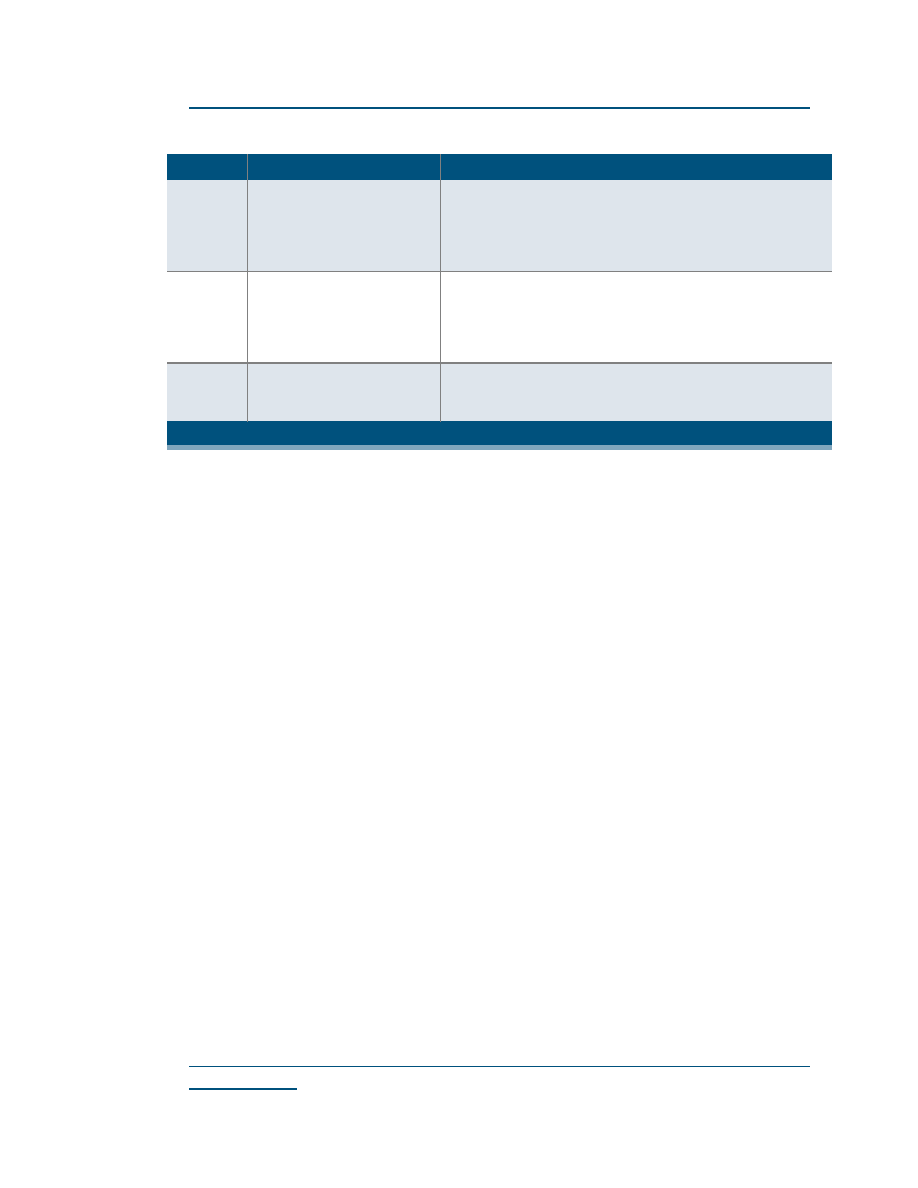
ZZZTXLFNORJLFFRP
4XLFN/RJLF &RUSRUDWLRQ
(FOLSVH,, )DPLO\ 'DWD 6KHHW 5HY %
Preliminary
Vpump
Charge Pump Disable
This pin disables the internal charge pump for lower static power
operation. To disable the charge pump, connect Vpump to 3.3 V.
If the Disable Charge Pump feature is not used, connect Vpump to
Ground. For backwards compatibility with Eclipse and EclipsePlus
devices, connect Vpump to Ground.
Vded
Voltage tolerance for clocks,
JTAG, and IOCTRL/Voltage
Drive for PLLOUT and JTAG
pins
This pin specifies the input voltage tolerance for CLK, JTAG, and
IOCTRL dedicated input pins, as well as the output voltage drive
for PLLOUT and JTAG pins. If the PLLs are used, Vded must be
the same as V
CC
PLL. For backwards compatibility with Eclipse and
EclipsePlus devices, connect Vded to 2.5 V.
VccPLL
Power Supply pin for PLL
Connect to 2.5 V supply or 3.3 V supply. For backwards
compatibility with Eclipse and EclipsePlus devices, connect to
2.5 V.
7DEOH 'HGLFDWHG 3LQ 'HVFULSWLRQV
3LQ
)XQFWLRQ
'HVFULSWLRQ
6KHHW RI �
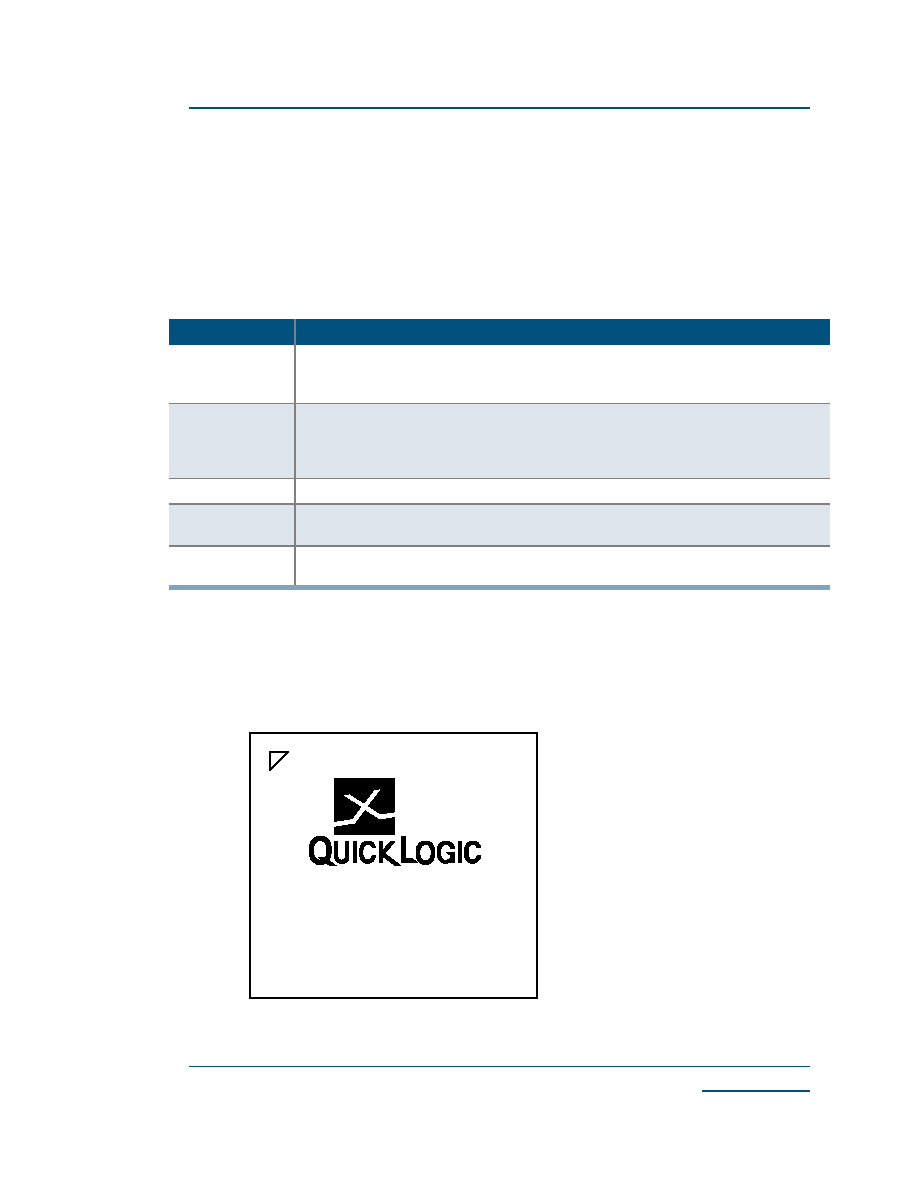
4XLFN/RJLF &RUSRUDWLRQ
ZZZTXLFNORJLFFRP
(FOLSVH,, )DPLO\ 'DWD 6KHHW 5HY %
Preliminary
5HFRPPHQGHG 8QXVHG 3LQ 7HUPLQDWLRQV IRU WKH (FOLSVH,,
'HYLFHV
All unused, general purpose I/O pins can be tied to V
CC
, GND, or HIZ (high impedance) internally
using the Configuration Editor. This option is given in the bottom-right corner of the placement
window. To use the Placement Editor, choose Constraint
>
Fix Placement in the Option pull-
down menu of SpDE.
The rest of the pins should be terminated at the board level in the manner presented in
7DEOH
.
34)3 3LQRXW 'LDJUDP
7DEOH 5HFRPPHQGHG 8QXVHG 3LQ 7HUPLQDWLRQV
6LJQDO 1DPH
5HFRPPHQGHG 7HUPLQDWLRQ
PLLOUT<x>
a
a. x represents a number.
Unused PLL output pins must be connected to either V
CC
or GND so that their associated
input buffer never floats. Utilized PLL output pins that route the PLL clock outside of the
chip should not be tied to either V
CC
or GND.
IOCTRL<y>
b
b. y represents an aphabetical character.
There is an internal pulldown resistor to Ground on this pin. This pin should be tied to
Ground if it is not used. For backwards compatibility with Eclipse, it can be tied to Vcc or
Ground. If tied to Vcc, it will draw no more than 20 µA per IOCTRL pin due to the pulldown
resistor.
CLK/PLLIN<x>
Any unused clock pins should be connected to V
CC
or GND.
PLLRST<x>
If a PLL module is not used, then the associated PLLRST<x> must be connected to V
CC
,
under normal operation use it as needed.
INREF<y>
If an I/O bank does not require the use of INREF signal the pin should be connected to
GND.
Eclipse-II
QL8325-7PQ208C

ZZZTXLFNORJLFFRP
4XLFN/RJLF &RUSRUDWLRQ
(FOLSVH,, )DPLO\ 'DWD 6KHHW 5HY %
Preliminary
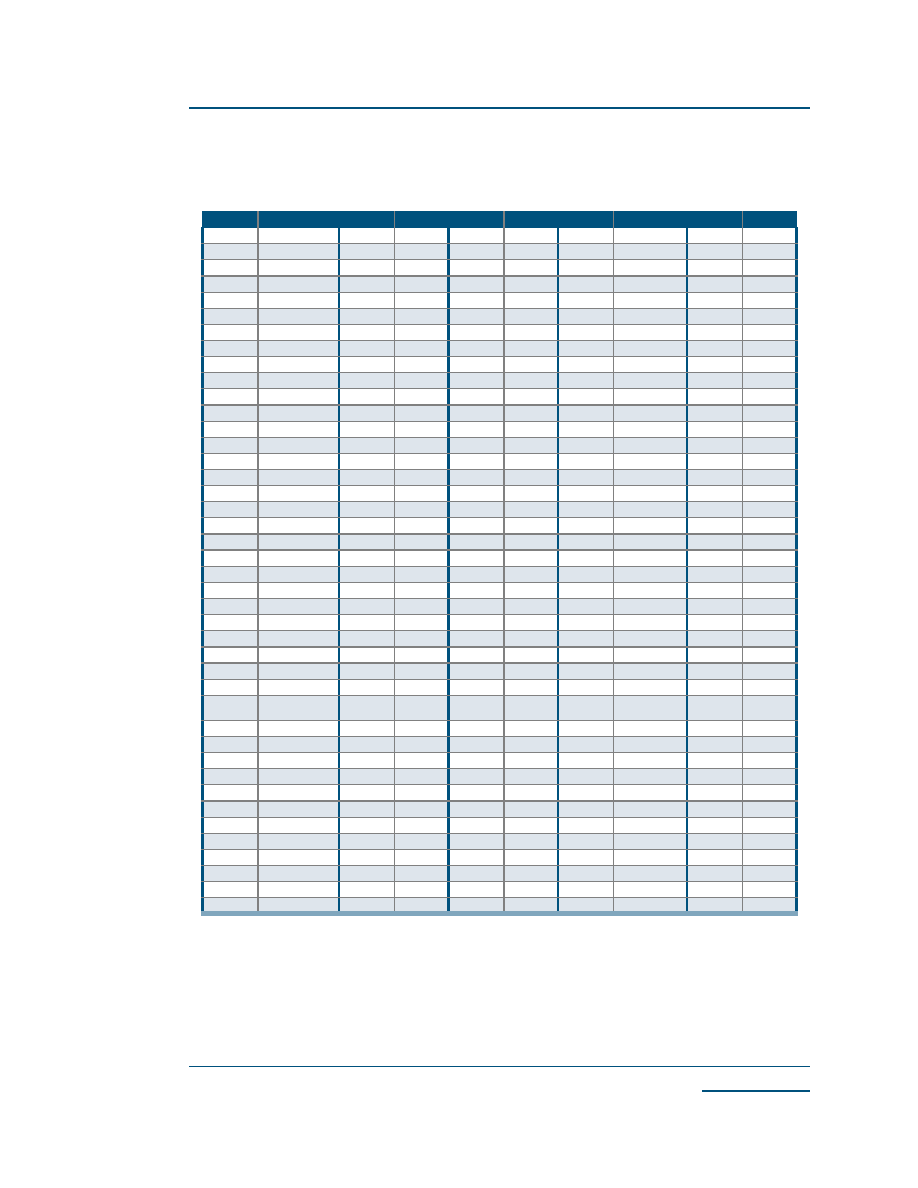
4XLFN/RJLF &RUSRUDWLRQ
ZZZTXLFNORJLFFRP
(FOLSVH,, )DPLO\ 'DWD 6KHHW 5HY %
Preliminary
34)3 3LQRXW 7DEOH
7DEOH 34)3 3LQRXW 7DEOH
34)3
)XQFWLRQ
34)3
)XQFWLRQ
34)3
)XQFWLRQ
34)3
)XQFWLRQ
34)3
)XQFWLRQ
3//567�
,2%�
,2'�
&/.�3//,1�
,2*�
9
&&3//
�
9
&&,2
%�
9
&&
&/.�
,15()*�
*1'
,2%�
,2'�
9GHG
,2*�
*1'
9
&&
,2'�
&/.�
,2*�
,2$�
,2%�
9
&&
9
&&
,2*�
,2$�
,2%�
,2'�
&/.�
,29�
,2$�
*1'
,2'�
706
9
&&
9
&&,2
$�
7'2
,2'�
,2)�
,2*�
,2$�
3//287�
,15()'�
,2)�
9
&&,2
*�
,2$�
*1'3//�
,2'�
,2)�
*1'
,2$�
*1'
,2'�
*1'
,2*�
9
&&
9
&&3//
�
,2'�
9
&&,2
)�
,2*�
,15()$�
3//567�
,2'�
,2)�
,2*�
,2$�
9
&&
9
&&,2
'�
,2)�
9
&&
,2$�
,2&�
,2'�
,2)�
7&.
,2$�
*1'
,2'�
,2)�
9
&&
,2$�
,2&�
9SXPS
,2)�
,2+�
,2$�
9
&&,2
&�
3//287�
,2)�
,2+�
9
&&,2
$�
,2&�
*1'
,15())�
,2+�
,2$�
,2&�
*1'3//�
9
&&
*1'
*1'
,2&�
3//567�
,2)�
9
&&,2
+�
,2$�
,2&�
9
&&3//
�
,2)�
,2+�
7',
,2&�
,2(�
,2)�
,2+�
&/.�
,2&�
*1'
9
&&,2
)�
,2+�
&/.�
,2&�
,2(�
,2)�
,2+�
9
&&
,15()&�
,2(�
,2)�
,1+�
&/.�3//,1�
,2&�
9
&&,2
(�
*1'
9
&&
&/.�3//,1�
,2&�
,2(�
,2)�
,2+�
9GHG
,2&�
9
&&
3//287�
,2+�
&/.�
'('&/.3//,1�
9
&&,2
&�
,2(�
*1'3//�
,2+�
,2%�
,2&�
,2(�
*1'
,2+�
,2%�
,2&�
,2(�
9
&&3//
�
,2+�
*1'
*1'
,2(�
3//567�
,2+�
9
&&,2
%�
9
&&
,15()(�
*1'
,2+�
,2%�
,2&�
,2(�
,2*�
9
&&,2
+�
,2%�
7567%
,2(�
9
&&,2
*�
*1'
,2%�
9
&&
,2(�
,2*�
,2+�
,2%�
,2'�
9
&&,2
(�
,2*�
3//287�
,2%�
,2'�
*1'
9
&&
*1'
,15()%�
,2'�
,2(�
,2*�
*1'3//�
,2%�
*1'
,2(�
,2*�
,2%�
9
&&,2
'�
,2(�
,2*�
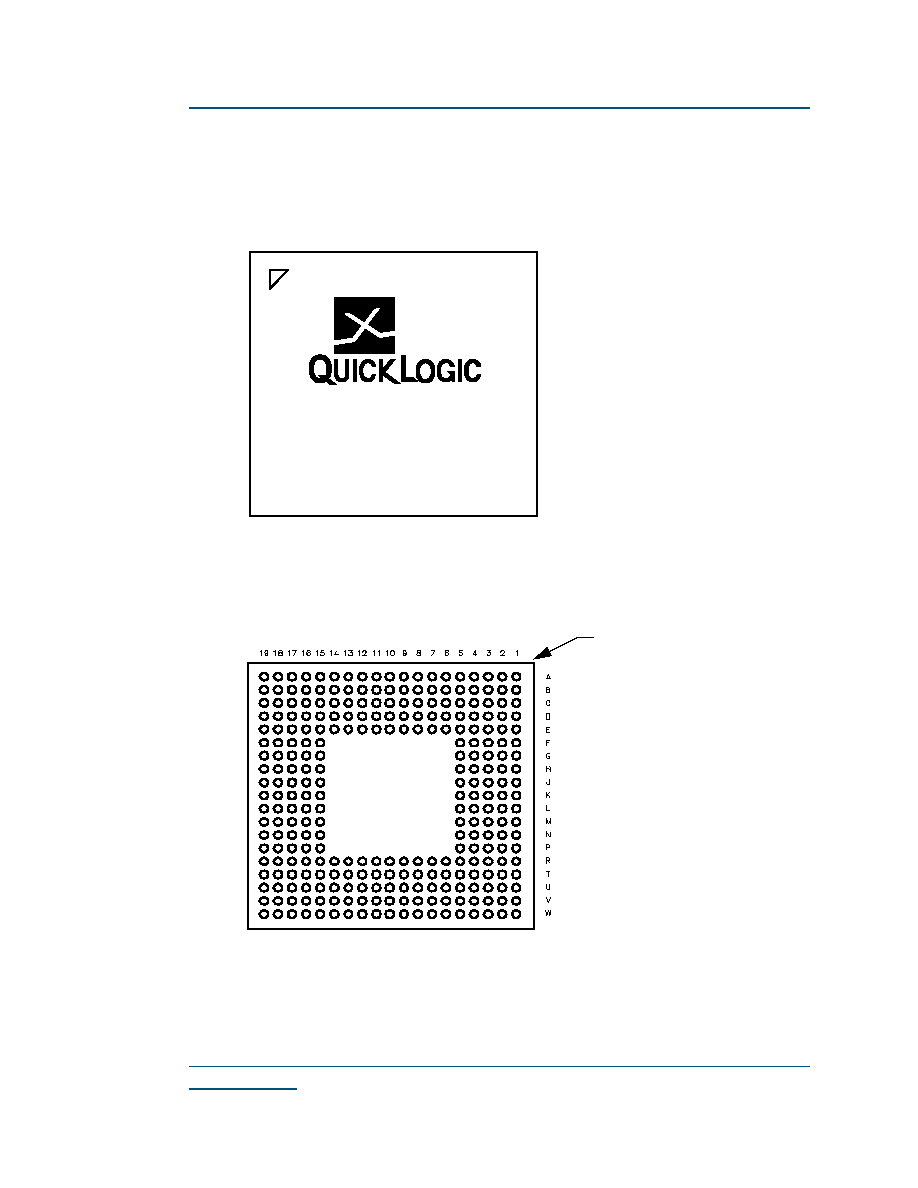
ZZZTXLFNORJLFFRP
4XLFN/RJLF &RUSRUDWLRQ
(FOLSVH,, )DPLO\ 'DWD 6KHHW 5HY %
Preliminary
3%*$ 3LQRXW 'LDJUDP
7RS
%RWWRP
Eclipse-II
QL8325-7PT280C
Pin A1
Corner
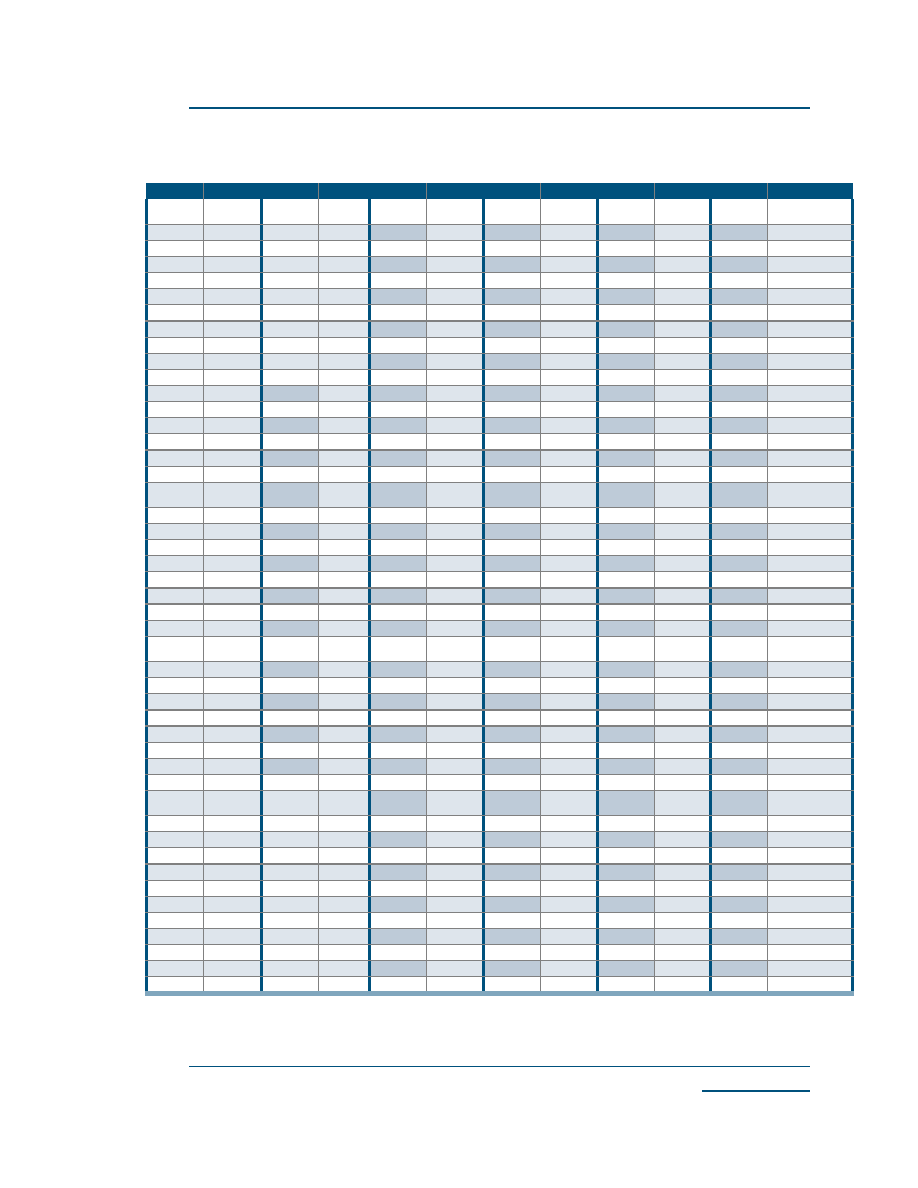
4XLFN/RJLF &RUSRUDWLRQ
ZZZTXLFNORJLFFRP
(FOLSVH,, )DPLO\ 'DWD 6KHHW 5HY %
Preliminary
3%*$ 3LQRXW 7DEOH
7DEOH 3%*$ 3LQRXW 7DEOH
3%*$
)XQFWLRQ
3%*$
)XQFWLRQ
3%*$
)XQFWLRQ
3%*$
)XQFWLRQ
3%*$
)XQFWLRQ
3%*$
)XQFWLRQ
$
3//287!
&
&/.!
3//,1!
(
,2&75/'!
.
,2&!
5
,2+!
8
,2%!
$
*1'3//!
&
9
&&,2
(!
)
,15()*!
.
,2'!
5
*1'
8
,2&75/%!
$
,2)!
&
,2(!
)
,2&75/*!
.
,2&!
5
*1'
8
9
&&,2
%!
$
,2)!
&
,2(!
)
,2*!
.
7567%
5
9
&&
8
,2%!
$
,2)!
&
,2(!
)
,2*!
/
,2+!
5
9
&&
8
7'2
$
,2&75/)!
&
9
&&,2
(!
)
*1'
/
,2+!
5
*1'
8
3//567!
$
,2)!
&
,2(!
)
9
&&
/
9
&&,2
+!
5
*1'
8
,2%!
$
,2)!
&
,2(!
)
,2&75/'!
/
,2+!
5
9
&&
9
3//287!
$
,2)!
&
,2(!
)
,2'!
/
9
&&
5
9
&&
9
*1'3//!
$
&/.!
&
,2(!
)
,2'!
/
*1'
5
9
&&
9
*1'
$
,2(!
'
,2*!
)
,2'!
/
,2&!
5
9GHG
9
,2$!
$
,2(!
'
,2*!
*
,2*!
/
9
&&,2
&!
5
*1'
9
,2$!
$
,2(!
'
,2)!
*
,2*!
/
,2&!
5
,2&!
9
,2&75/$!
$
,2&75/(!
'
,2)!
*
,2&75/*!
/
,2&!
5
9
&&,2
&!
9
,2$!
$
,2(!
'
,2)!
*
,2*!
0
,2+!
5
,2&!
9
,2$!
$
,2(!
'
,2)!
*
9
&&
0
,2+!
5
,2&!
9
,2$!
$
,2(!
'
,2)!
*
9
&&
0
,2+!
7
,2+!
9
&/.!
$
3//567!
'
,2)!
*
,2'!
0
,2+!
7
,2+!
9
&/.!
'('&/.3//,1!
$
*1'
'
&/.!
*
,2'!
0
9
&&
7
,2$!
9
,2%!
%
3//567!
'
,2(!
*
,2'!
0
9
&&
7
,2$!
9
,2%!
%
*1'
'
,2(!
*
,2'!
0
,15()&!
7
,2$!
9
,15()%!
%
,2)!
'
,2(!
+
,2*!
0
,2&!
7
,2&75/$!
9
,2%!
%
,2)!
'
,15()(!
+
,2*!
0
,2&!
7
,2$!
9
,2%!
%
,2)!
'
,2(!
+
,2*!
0
,2&!
7
,2$!
9
,2%!
%
,15())!
'
,2(!
+
,2*!
1
,2&75/+!
7
,2$!
9
*1'3//!
%
,2)!
'
,2'!
+
9
&&
1
,2+!
7
,2$!
9
*1'
%
,2)!
'
,2'!
+
9
&&
1
,2+!
7
&/.!
3//,1!
:
*1'
%
706
'
,2'!
+
9
&&
1
,2+!
7
,2%!
:
3//567!
%
&/.!
'
,2'!
+
,2'!
1
9
&&
7
,2%!
:
,2$!
%
,2(!
(
,2*!
+
,2'!
1
9
&&
7
,2%!
:
,2$!
%
,2(!
(
,2*!
+
,2'!
1
,2&!
7
,2%!
:
,2$!
%
,2&75/(!
(
9
&&,2
*!
-
,2*!
1
,2&!
7
,2%!
:
,2$!
%
,2(!
(
,2)!
-
,2*!
1
,2&75/&!
7
9
&&3//
!
:
,2$!
%
,2(!
(
*1'
-
9
&&,2
*!
1
,2&75/&!
7
,2%!
:
,2$!
%
,2(!
(
9
&&
-
,2*!
3
,2+!
7
,2%!
:
7',
%
9
&&3//
!
(
9
&&
-
*1'
3
,2+!
8
,2$!
:
&/.!
3//,1!
%
*1'3//!
(
9GHG
-
9
&&
3
,2&75/+!
8
,2$!
:
,2%!
%
3//287!
(
9
&&
-
,2&!
3
,15()+!
8
9
&&3//
!
:
,2%!
&
,2)!
(
*1'
-
9
&&,2
'!
3
9
&&
8
,2$!
:
,2%!
&
9
&&3//
!
(
*1'
-
,2'!
3
*1'
8
9
&&,2
$!
:
,2&75/%!
&
,2)!
(
9
&&
-
,2'!
3
,2&!
8
,15()$!
:
,2%!
&
,2)!
(
9
&&
.
9
&&
3
,2&!
8
,2$!
:
,2%!
&
9
&&,2
)!
(
*1'
.
7&.
3
,2&!
8
,2$!
:
,2%!
&
,2&75/)!
(
9SXPS
.
,2*!
3
,2&!
8
9
&&,2
$!
:
,2%!
&
,2)!
(
,2'!
.
,2*!
5
,2+!
8
&/.!
:
3//287!
&
,2)!
(
9
&&,2
'!
.
*1'
5
,2+!
8
9
&&,2
%!
&
9
&&,2
)!
(
,15()'!
.
*1'
5
9
&&,2
+!
8
,2%!
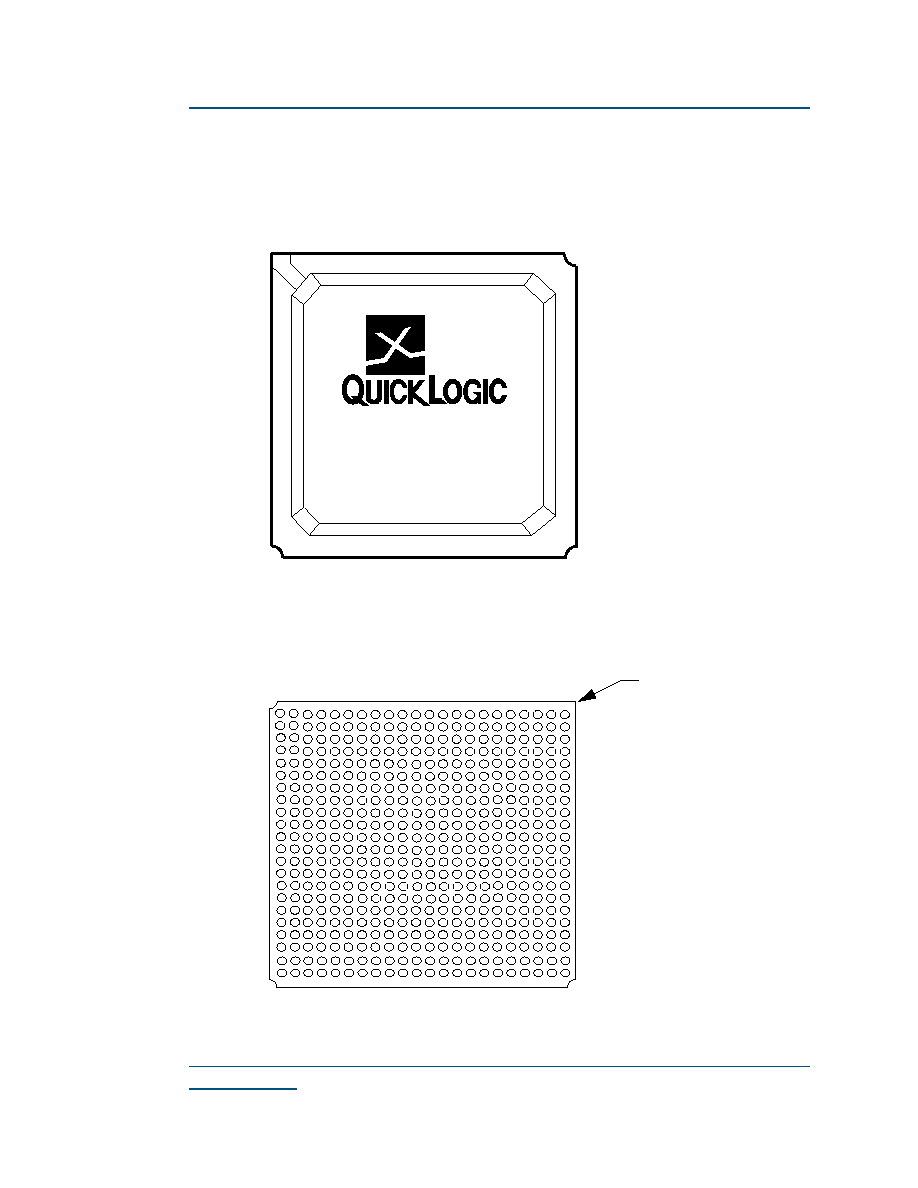
ZZZTXLFNORJLFFRP
4XLFN/RJLF &RUSRUDWLRQ
(FOLSVH,, )DPLO\ 'DWD 6KHHW 5HY %
Preliminary
3%*$ 3LQRXW 'LDJUDP
7RS
%RWWRP
Eclipse-II
QL8325-7PS484C
20
19 18
17 16
15 14
13 12
11 10
9
8
7
6
5
4
3
2
1
A
B
C
E
D
F
G
H
K
J
L
M
N
R
P
T
U
V
Y
W
22
21
AB
AA
Pin A1
Corner
Pin A1
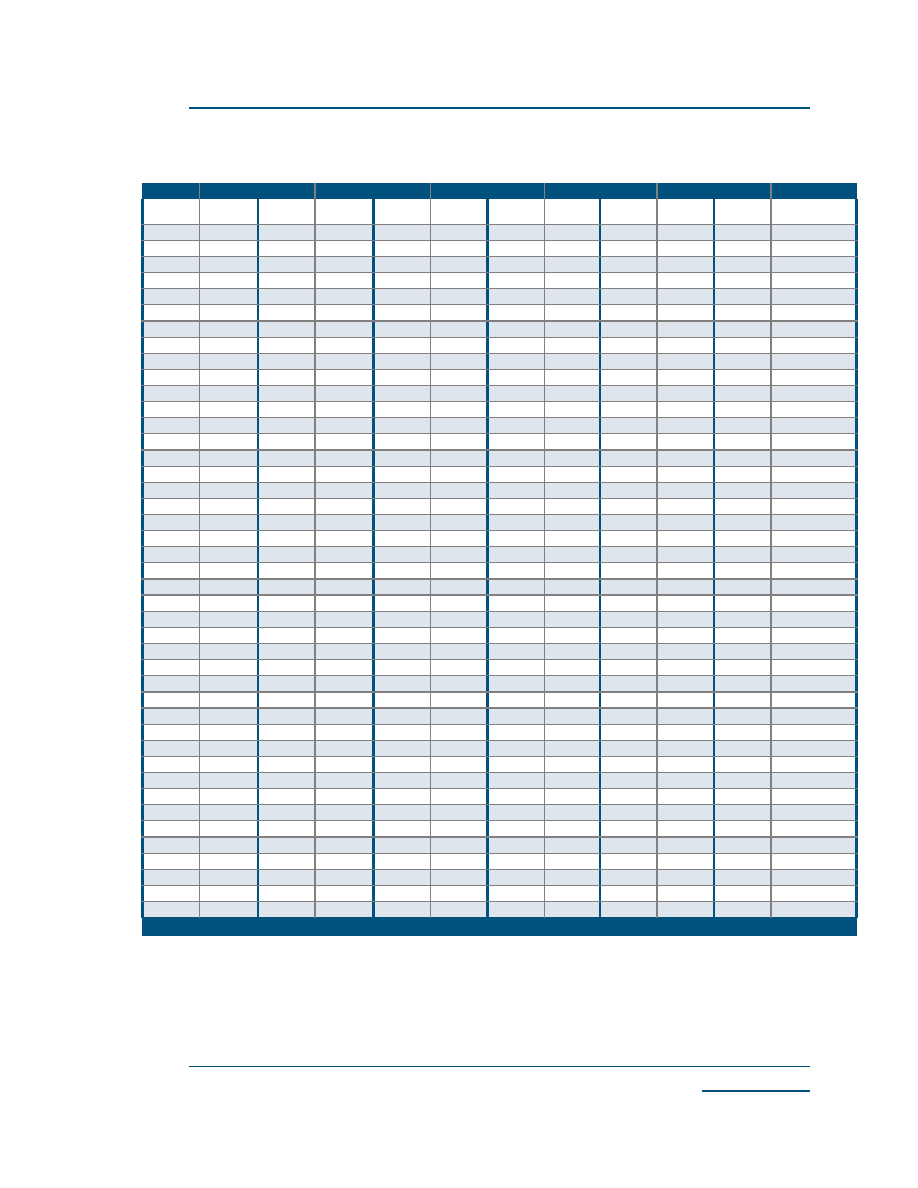
4XLFN/RJLF &RUSRUDWLRQ
ZZZTXLFNORJLFFRP
(FOLSVH,, )DPLO\ 'DWD 6KHHW 5HY %
Preliminary
3%*$ 3LQRXW 7DEOH
7DEOH 3%*$ 3LQRXW 7DEOH
3%*$
)XQFWLRQ
3%*$
)XQFWLRQ
3%*$
)XQFWLRQ
3%*$
)XQFWLRQ
3%*$
)XQFWLRQ
3%*$
)XQFWLRQ
$
,2$!
&
,2$!
(
,2&75/$!
*
,2$!
-
,2$!
/
&/.!
'('&/.3//,1!
$
3//567!
&
,2$!
(
,2$!
*
,2$!
-
,2$!
/
&/.!
$
,2$!
&
9
&&3//
!
(
,2$!
*
,2$!
-
,2$!
/
&/.!3//,1!
$
,2$!
&
3//287!
(
,2$!
*
,2$!
-
,2$!
/
,2$!
$
,2$!
&
,2$!
(
,2$!
*
,2$!
-
,2$!
/
,2$!
$
,2+!
&
,2+!
(
,2+!
*
,2$!
-
,2$!
/
,2$!
$
,2+!
&
,2+!
(
1&
*
*1'
-
,2$!
/
*1'
$
,2&75/+!
&
,2+!
(
,2+!
*
,2+!
-
9
&&
/
*1'
$
,2+!
&
,2&75/+!
(
,2+!
*
,2+!
-
*1'
/
*1'
$
1&
&
,2+!
(
,2+!
*
,2+!
-
9
&&
/
*1'
$
1&
&
,2+!
(
9
&&
*
,2*!
-
9
&&
/
*1'
$
7&.
&
,2+!
(
,2*!
*
*1'
-
*1'
/
*1'
$
,2*!
&
,2*!
(
,2*!
*
,2*!
-
9
&&
/
*1'
$
,2*!
&
,2*!
(
,2*!
*
,2*!
-
*1'
/
9
&&
$
,2*!
&
,2*!
(
,2&75/*!
*
,2*!
-
9
&&
/
9
&&
$
,2*!
&
,2*!
(
,2*!
*
9SXPS
-
,2)!
/
&/.!
$
,2*!
&
,2*!
(
,15()*!
*
9
&&,2
)!
-
9
&&,2
)!
/
9
&&,2
)!
$
,2*!
&
,2*!
(
,2*!
*
,2)!
-
,2)!
/
,2)!
$
,2)!
&
,2)!
(
,2)!
*
,2)!
-
,2)!
/
&/.!
$
*1'
&
*1'3//!
(
,2)!
*
,2)!
-
,2)!
/
,2)!
$
3//287!
&
,2)!
(
,2)!
*
,15())!
-
,2)!
/
,2)!
$
,2)!
&
,2)!
(
,2)!
*
,2)!
-
,2)!
/
,2)!
%
,2$!
'
,2$!
)
,2$!
+
,2$!
.
7',
0
,2%!
%
*1'
'
,2$!
)
,15()$!
+
,2$!
.
,2$!
0
,2%!
%
*1'3//!
'
,2$!
)
,2$!
+
,2$!
.
,2$!
0
,2%!
%
*1'
'
,2$!
)
,2$!
+
,2$!
.
,2$!
0
&/.!3//,1!
%
,2$!
'
,2$!
)
,2$!
+
,2&75/$!
.
,2$!
0
,2%!
%
,2+!
'
,2+!
)
9
&&,2
$!
+
9
&&,2
$!
.
9
&&,2
$!
0
9
&&,2
%!
%
,2+!
'
,2+!
)
9
&&,2
+!
+
,2+!
.
,2$!
0
&/.!
%
,15()+!
'
,2+!
)
,2+!
+
*1'
.
9
&&
0
9
&&
%
,2+!
'
,2+!
)
9
&&,2
+!
+
9
&&
.
9
&&
0
9
&&
%
,2+!
'
,2+!
)
,2+!
+
9
&&
.
*1'
0
*1'
%
,2+!
'
,2+!
)
9
&&,2
+!
+
9
GHG
.
*1'
0
*1'
%
1&
'
,2*!
)
9
&&,2
*!
+
*1'
.
*1'
0
*1'
%
1&
'
,2*!
)
,2*!
+
9
&&
.
*1'
0
*1'
%
1&
'
,2*!
)
9
&&,2
*!
+
9
&&
.
9
&&
0
*1'
%
,2*!
'
,2&75/*!
)
1&
+
*1'
.
9
&&
0
*1'
%
,2*!
'
,2*!
)
9
&&,2
*!
+
,2)!
.
,2)!
0
*1'
%
,2*!
'
,2*!
)
1&
+
,2)!
.
,2)!
0
,2(!
%
,2*!
'
,2)!
)
,2)!
+
,2)!
.
,2)!
0
,2(!
%
3//567!
'
9
&&3//
!
)
,2)!
+
,2)!
.
,2)!
0
,2(!
%
,2)!
'
,2)!
)
,2&75/)!
+
,2)!
.
,2)!
0
&/.!
%
,2)!
'
,2)!
)
,2)!
+
,2)!
.
,2)!
0
&/.!3//,1!
%
,2)!
'
,2)!
)
,2&75/)!
+
,2)!
.
,2)!
0
706
6KHHW RI �
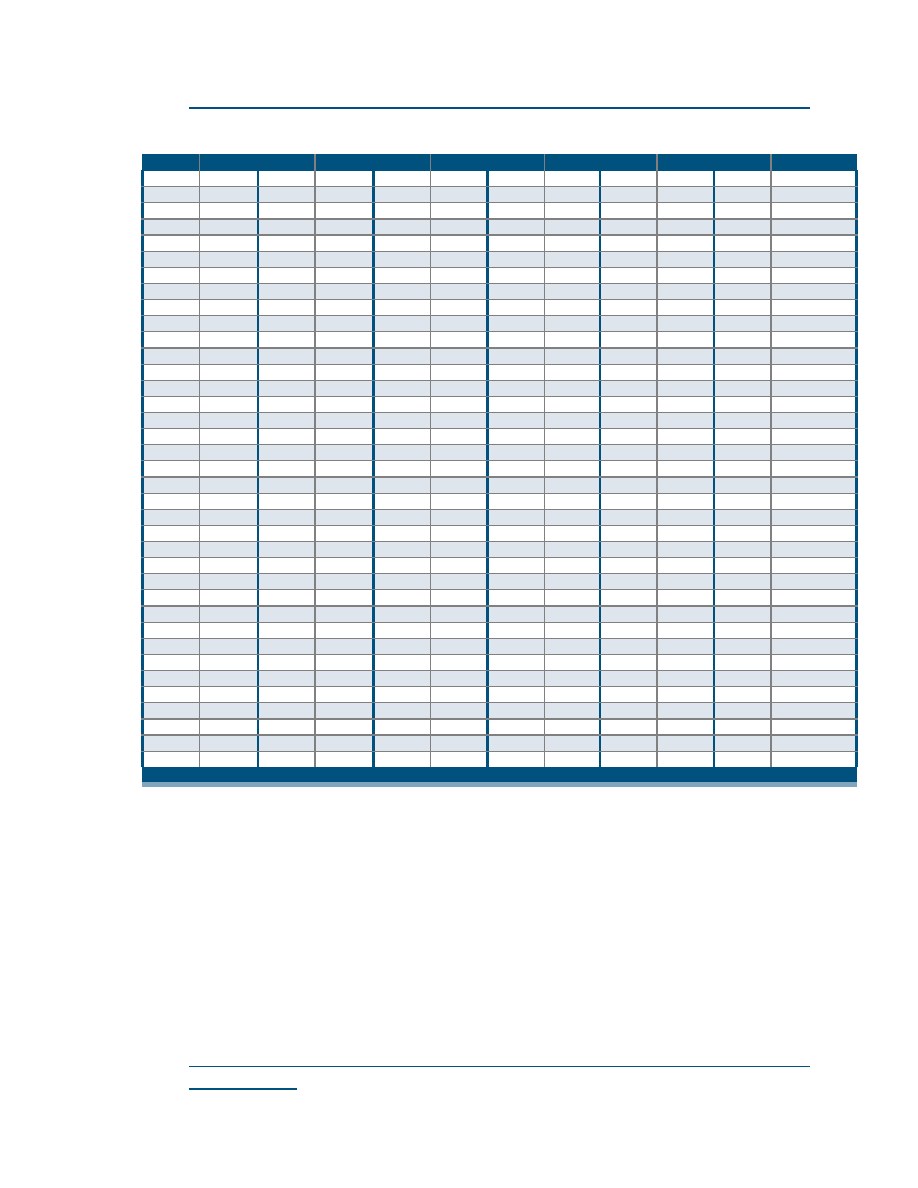
ZZZTXLFNORJLFFRP
4XLFN/RJLF &RUSRUDWLRQ
(FOLSVH,, )DPLO\ 'DWD 6KHHW 5HY %
Preliminary
1
,2%!
3
,2(!
7
1&
9
,2%!
:
,2'!
$$
,2&!
1
,2%!
3
,2(!
7
7567%
9
,2%!
:
,2(!
$$
,2&!
1
,2%!
3
,2(!
7
*1'
9
,2%!
:
,2(!
$$
,2'!
1
,2%!
3
,2(!
7
1&
9
,2%!
:
,2(!
$$
,2'!
1
,2%!
3
,2(!
7
,2'!
9
,2&!
:
,2(!
$$
,2'!
1
,2%!
3
,2(!
7
1&
9
,2&!
:
,2(!
$$
,2'!
1
,2%!
3
,2(!
7
,2'!
9
,2&!
<
,2%!
$$
,2'!
1
9
&&
5
,2%!
7
*1'
9
1&
<
,2%!
$$
,2'!
1
9
&&
5
,15()%!
7
,2(!
9
,2&!
<
9
&&3//
!
$$
,2'!
1
*1'
5
,2%!
7
,2(!
9
,2&!
<
,2&!
$$
,2(!
1
*1'
5
,2%!
7
,2(!
9
9
&&
<
,2&!
$$
*1'3//!
1
*1'
5
,2%!
7
,2(!
9
1&
<
,2&!
$$
,2(!
1
*1'
5
,2%!
7
,2&75/(!
9
,2'!
<
,2&!
$$
,2(!
1
9
&&
5
,2%!
7
,2(!
9
,2'!
<
,2&75/&!
$%
,2%!
1
9
&&
5
*1'
8
,2&75/%!
9
,15()'!
<
,2&!
$%
*1'3//!
1
,2(!
5
9
&&
8
,2%!
9
,2'!
<
,2&!
$%
3//567!
1
9
&&,2
(!
5
9
&&
8
,2&75/%!
9
,2(!
<
,2'!
$%
,2%!
1
,2(!
5
*1'
8
,2%!
9
,2(!
<
,2'!
$%
,2%!
1
,2(!
5
9GHG
8
,2%!
9
,2(!
<
,2'!
$%
,2&!
1
,2(!
5
9
&&
8
,2&!
9
,2(!
<
,2'!
$%
,2&!
1
,2(!
5
9
&&
8
9
&&,2
&!
9
,2(!
<
,2&75/'!
$%
,2&75/&!
1
,2(!
5
*1'
8
1&
:
,2%!
<
,2'!
$%
,2&!
3
,2%!
5
,2'!
8
9
&&,2
&!
:
,2%!
<
,2'!
$%
,2&!
3
,2%!
5
9
&&,2
(!
8
,2&!
:
,2%!
<
,2(!
$%
,2&!
3
,2%!
5
,2(!
8
9
&&,2
&!
:
,2%!
<
3//287!
$%
,2'!
3
,2%!
5
,2(!
8
9
&&,2
'!
:
,2%!
<
3//567!
$%
,2'!
3
,2%!
5
,2(!
8
,2'!
:
,2&!
<
,2(!
$%
,2'!
3
9
&&,2
%!
5
,2(!
8
9
&&,2
'!
:
1&
<
,2(!
$%
,2'!
3
,2%!
5
,2(!
8
1&
:
,2&!
$$
7'2
$%
,2&75/'!
3
9
&&
7
,2%!
8
9
&&,2
'!
:
,2&!
$$
3//287!
$%
,2'!
3
*1'
7
,2%!
8
9
&&,2
(!
:
,2&!
$$
*1'
$%
,2'!
3
9
&&
7
,2%!
8
,2(!
:
,2&!
$$
,2%!
$%
,2(!
3
*1'
7
,2%!
8
,2(!
:
,2'!
$$
,2&!
$%
*1'
3
9
&&
7
,2%!
8
,2&75/(!
:
,2'!
$$
,2&!
$%
9
&&3//
!
3
9
&&
7
9
&&,2
%!
8
,2(!
:
,2'!
$$
,2&!
$%
,2(!
3
*1'
7
*1'
8
,15()(!
:
,2'!
$$
,15()&!
3
9
&&
7
,2&!
9
,2%!
:
1&
$$
,2&!
7DEOH 3%*$ 3LQRXW 7DEOH &RQWLQXHG�
3%*$
)XQFWLRQ
3%*$
)XQFWLRQ
3%*$
)XQFWLRQ
3%*$
)XQFWLRQ
3%*$
)XQFWLRQ
3%*$
)XQFWLRQ
6KHHW RI �
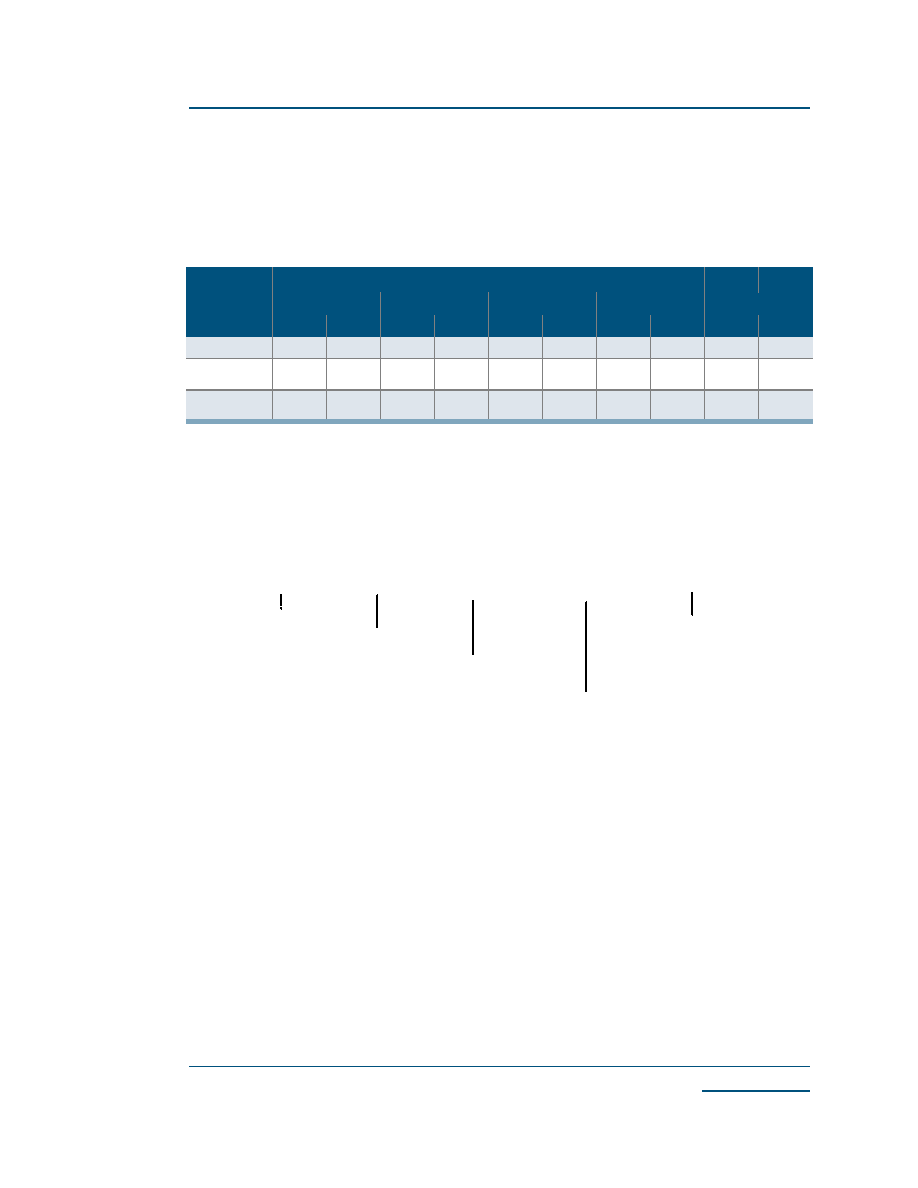
4XLFN/RJLF &RUSRUDWLRQ
ZZZTXLFNORJLFFRP
(FOLSVH,, )DPLO\ 'DWD 6KHHW 5HY %
Preliminary
3DFNDJLQJ ,QIRUPDWLRQ
The Eclipse-II
product family packaging information is presented in
7DEOH
.
NOTE:
0LOLWDU\ WHPSHUDWXUH UDQJH SODVWLF SDFNDJHV ZLOO EH DGGHG DV IROORZ RQ SURGXFWV WR WKH
FRPPHUFLDO DQG LQGXVWULDO SURGXFWV
7DEOH 3DFNDJLQJ 2SWLRQV
'HYLFH
,QIRUPDWLRQ
'HYLFH
4/
4/
4/
4/
4/
3LQ
3LWFK
3LQ
3LWFK
3LQ
3LWFK
3LQ
3LWFK
3LQ
3LWFK
34)3
34)3
PP
94)3
PP
94)3
PP
94)3
PP
3DFNDJH
'HILQLWLRQV
D
a. PQFP = Plastic Quad Flat Pack; BGA= Ball Grid Array; VQFP = Very
Thin Quad Flat Pack; CSBGA = Chip Scale Ball Grid Array; FBGA =
Fine Pitch Ball Grid Array
2UGHULQJ ,QIRUPDWLRQ
)%*$
PP
)%*$
PP
34)3
PP
34)3
PP
34)3
PP
%*$
PP
%*$
PP
&6%*$
PP
&6%*$
PP
&6%*$
PP
QL 8050
-7
PQ208 C
Operating Range:
C = Commercial
I = Industrial
M = Military
Package Lead Count:
PV100 = 100-pin VQFP
PQ208 = 208-pin PQFP
PT196 = 196-ball Chip Scale BGA (0.8 mm)
PT280 = 280-ball FPBGA (0.8 mm)
PS484 = 484-ball FPBGA (1.0 mm)
8150,
Part Number:
8050,
8250,
8325
QuickLogic Device
Speed Grade:
7 Faster
8 Fastest
8025,

ZZZTXLFNORJLFFRP
4XLFN/RJLF &RUSRUDWLRQ
(FOLSVH,, )DPLO\ 'DWD 6KHHW 5HY %
Preliminary
&RQWDFW ,QIRUPDWLRQ
Telephone:
408 990 4000 (US)
416 497 8884 (Canada)
44 1932 57 9011 (Europe)
49 89 930 86 170 (Germany)
852 8106 9091 (Asia)
81 45 470 5525 (Japan)
E-mail:
info@quicklogic.com
Support:
support@quicklogic.com
Web site:
http://www.quicklogic.com/
5HYLVLRQ +LVWRU\
7DEOH 5HYLVLRQ +LVWRU\
5HYLVLRQ
'DWH
&RPPHQWV
A
Preliminary
August
2002
Brian Faith, Judd Heape, Andreea Rotaru
Rev A
December
2002
Brian Faith, Andreea Rotaru
Rev B
January
2003
Brian Faith, Andreea Rotaru

4XLFN/RJLF &RUSRUDWLRQ
ZZZTXLFNORJLFFRP
(FOLSVH,, )DPLO\ 'DWD 6KHHW 5HY %
Preliminary
&RS\ULJKW DQG 7UDGHPDUN ,QIRUPDWLRQ
Copyright © 2002 QuickLogic Corporation.
All Rights Reserved.
The information contained in this document and the accompanying software programs is
protected by copyright. All rights are reserved by QuickLogic Corporation. QuickLogic
Corporation reserves the right to modify this document without any obligation to notify any
person or entity of such revision. Copying, duplicating, selling, or otherwise distributing any part
of this product without the prior written consent of an authorized representative of QuickLogic is
prohibited.
QuickLogic and the QuickLogic logo, pASIC, ViaLink, DeskFab, and QuickWorks are registered
trademarks of QuickLogic Corporation; Eclipse, QuickFC, QuickDSP, QuickDR, QuickSD,
QuickTools, QuickCore, QuickPro, SpDE, WebASIC, and WebESP are trademarks of QuickLogic
Corporation.
















































